Contents
COLONY COLLAPSE REDUX?. 1
A SIDE NOTE ON RECENT COLONY COLLAPSES. 2
WASTED YEARS. 3
NOVEL HOST-PARASITE RELATIONSHIPS. 3
BREEDING MAY BE SIMPLE, OR MORE COMPLICATED.. 4
SELECTING FOR TOLERANCE OR RESISTANCE?. 4
HOW DOES VARROA’S NATIVE HOST DEAL WITH THE MITE?. 5
SOCIAL APOPTOSIS. 6
RE-EVALUATING SELECTIVE BREEDING STRATEGIES. 6
PROGRAMS SELECTING FOR SPECIFIC TRAITS. 6
REVIEWS OF THE SUCCESS OF SELECTION METHODS. 7
COULD THERE BE A BETTER WAY TO RUN A SELECTIVE BREEDING PROGRAM?. 8
SELECT FOR THE OBJECTIVE, RATHER THAN THE MEANS TO THE END.. 9
NEXT MONTH.. 10
CITATIONS AND NOTES. 10
Selective Breeding for Mite Resistance
Part 1
Randy Oliver
ScientificBeekeeping.com
First Published in ABJ August 2025
I’ve selectively bred bees that were gentle, then immune to AFB, and then resistant to the deadly tracheal mite. So when I saw my first varroa mite on a sticky board in 1993, I thought “this is gonna be easy.” Boy was I wrong!
COLONY COLLAPSE REDUX?
We’ve all heard about the high rate of colony losses this past winter. This was hardly unexpected [[1]]. As stated by Dr. Zachary Lamas [[2]]:
The universal prevalence of [the amitraz] resistance genotype in all of these [mite] samples is strongly suggestive that amitraz may have been ineffective at controlling these Varroa populations. The removal of amitraz as a viable tool to manage Varroa will destabilize beekeeping operations until a replacement miticide or management strategy arrives.
Due to amitraz’s loss of efficacy, researchers and startups are feverishly trying to come up with new “treatments” for varroa control. But the tragic irony of using any miticide to control varroa is that doing so increases the selective pressure for mites that are resistant to that chemical. Beekeepers have exhibited their success at breeding mites resistant to a “silver bullet” miticide time and again.
Keep in mind that any “treatments” are nothing but stopgap measures (Figure 1).

Fig. 1 There was nothing necessarily wrong with jumping to the top of the IPM pyramid to control varroa when it first invaded, but we needed to keep in mind that miticides were only short-term stopgap measures to hold the fort until we bred bees that could handle the mites themselves.
A SIDE NOTE ON RECENT COLONY COLLAPSES
It wasn’t just varroa or amitraz resistance. Beginning last September, our own operation got hit by a mysterious dwindling — clearly not due to varroa/DWV (we were monitoring by mite washes, and there were no sick brood, deformed wings, and seldom any dead bees on the ground), we’ve never used amitraz, and had no pesticide exposure. But it was like déjà vu — the field signs were very similar to the “CCD” that we observed when Nosema ceranae invaded during the 2000s — the slow dwindling of the adult workers, leading to a shrinking cluster over healthy brood (the well-described field sign of collapse due to Nosema apis [[3]]). So I pulled out the ‘scope, and although there was scattered nosema present, it didn’t differentiate between the healthy and dwindling colonies.
Despite our normal feeding of pollen sub and syrup, we helplessly watched what we expected to be strong colonies for almond pollination dwindle to nothing.
The good news: Although the losses devastated us, there were colonies in each yard that continued to thrive (apparently resistant to the mysterious pathogen), and we are now rebuilding our operation with our fingers crossed.
WASTED YEARS
We’ve had varroa in the U.S. for nearly forty years! When we put our minds to it, it took only eight years for us to put a man on the moon. Had we made the effort, we might have done the same with varroa. But the ready availability of inexpensive synthetic miticides allowed us to keep treating the symptoms, rather than addressing the cause.
Let me be clear, the ARS labs, notably the efforts of John Harbo, Jeff Harris, Tom Rinderer, and Bob Danka (as well as a number of other beekeepers (such as Danny Weaver and Kirk Webster), were doing the work of breeding mite-resistant stocks, but the beekeeping industry itself is to blame for not demanding (and rewarding) our queen producers to adopt and improve them.
Practical application: Our queen producers respond to market demand, and can easily sell every queen that they produce. Until beekeepers demand mite-resistant stock, there is little incentive for queen producers to go to the effort of offering them.
NOVEL HOST-PARASITE RELATIONSHIPS
Before humans were involved, some mites evolved parasitic lifestyles on various honey bee species in Asia — in stable host-parasite relationships. When humans later introduced these mites as novel parasites to the European honey bee, our beloved bees were caught unprepared to deal with them, and varroa and Tropilaelaps run rampant (plus increase virus transmission).
Even after four decades, in North America the vast majority of managed colonies are still stocked with honey bee bloodlines that exhibit scant resistance to varroa infestation (although our feral populations appear to be evolving resistance).
We already know that varroa’s original host, the Eastern honey bee (Apis cerana), is able to keep varroa (and Tropilaelaps) in check as “minor parasites” (present, but not causing serious harm). That means that it’s possible for honey bees to deal with mites on their own — it’s time for us to get serious about handing varroa management over to our bees, rather than trying to come up with flashy new miticides.
And we’ve now got Tropilaelaps knocking on our door. All it’s gonna take is a single swarm on a cargo ship (or some bees imported into Canada or Mexico) to introduce it into North America. Since Apis cerana is highly resistant to both varroa and Tropilaelaps, there’s a good chance that if we breed bees resistant to varroa, that we may be better prepared for the invasion of the devastating Tropilaelaps mite [[4]].
Practical application: The only long-term solution to varroa and Tropilaelaps is to selectively breed bees that have the capacity keep these parasites in check without our help!
BREEDING MAY BE SIMPLE, OR MORE COMPLICATED
When the tracheal mite invaded California, it killed 70% of our colonies. In a few years Steve Taber had selectively bred bees that were resistant to the mite, and since no one was breeding from dead colonies, soon the only bees left were those that were naturally resistant to tracheal mite.
Practical point: The “breeding population” of bees that existed when tracheal mite invaded already contained genetic alleles for traits that conferred resistance. Similar to how a single allele can confer amitraz resistance to a varroa mite, it appeared that it didn’t take much genetic change for bees to gain resistance to the tracheal mite [[5]]. Unfortunately, it appears that it takes far more than one allelic variation to confer resistance to varroa.
SELECTING FOR TOLERANCE OR RESISTANCE?
I often hear of people suggesting that we breed for “mite tolerant” bees, but is that what we really want? (Figure 2).

Fig. 2 The above bee is mite tolerant (since it is still alive). But varroa and its associated viruses extract metabolic, physiological, and immunity costs from the bees’ finite resources. I suggest selecting for mite resistance rather than tolerance.
Mite tolerance is mainly about virus resistance [[6]]. Back in the day, honey bees were virus resistant — Dr. Leslie Bailey found that it was difficult to infect a bee with viruses by mouth. And when varroa first infested our colonies, our bees were amazingly mite tolerant, since you could allow the mite infestation rate to climb to sky-high levels, and then save the colony in fall with a single treatment with Apistan. But then the viruses evolved, using varroa as their vector.
We still see some colonies that can tolerate high mite levels, with healthy brood. But although they don’t die, their bees are not going to be as healthy as bees that haven’t had their fat bodies sucked out by a mite.
Practical application: When I first started seriously breeding for mite resistance, my sons asked me whether we should include the queens of mite-tolerant colonies (lots of mites, but no signs of virus) as breeders. But since those colonies did not control their mite population, that would have maintained non-resistant genetics in our breeding population, so I decided “no.” On the other hand, mite-resistant colonies keep mites to a nearly undetectable level, so don’t have any more virus issues than our bees did back before varroa invaded (no one even talked back then about any viruses other than sacbrood).
This brings up the obvious question:
HOW DOES VARROA’S NATIVE HOST DEAL WITH THE MITE?
I’ve written about this previously [[7]], and we are not completely clear on the traits they use, [[8]] but in short, Apis cerana wrote the rules for its host-parasite relationship with the mite, focusing upon limiting the mite’s opportunities for reproduction. As best I can tell, here is the contract:
- Don’t waste your time trying to reproduce in our worker brood—our larvae will sacrifice themselves if you do. (So far, we haven’t seen this to any extent in Apis mellifera.)
- We’ll allow you to reproduce solely in our drone brood, under the condition that we’ll monitor for any signs of stress to that pupa (through a sniffing hole in the capping). Harm that pupa, and we will entomb you in a waxen grave. (Apis mellifera has yet to evolve a sniffing hole, and generally doesn’t uncap infested drone brood, but does remove sick worker brood.)
- And we’ll further restrict your reproduction by rearing drones only from time to time. (Apis mellifera unfortunately rears drones so long as there is a pollen flow going on.)
- At all times we will make your life miserable by aggressive grooming and biting. (Despite this, some mites survive for a long time in Apis cerana colonies.)
Apis cerana likely also uses additional traits to keep varroa in check as a minor parasite, and some tools that our bees don’t have in their arsenal. But there‘s more than one way to skin a cat, and Apis mellifera has come up with other tricks — notably forms of disruption of mite reproduction (uncapping), “suppression of mite reproduction” (SMR)[[9]], or hygienic removal of infested pupae (VSH), apparently triggered by “sacrifice me” signals from the pupae.
SOCIAL APOPTOSIS
In societal species (notably eusocial insects with a soldier caste), individuals can sacrifice themselves for the benefit of the colony as a whole (as a honey bee does when it stings in defense of the hive) [[10]]. This is analogous to the altruistic death of the cells that line your gut in response to getting infected by a pathogen (they sacrifice themselves for the good of your body before the pathogen can reproduce). In Apis cerana, the worker larvae appear to do this in response to a protein in varroa saliva [[11]]; and drone pupae by emitting a scent signal.
Hypothetical example: Imagine a strain of honey bees in which any worker that detected a mite on its body immediately flew away not to return [[12]]: varroa would be unable to exist in that colony.
The second-best choice would be to limit the mite’s ability to reproduce (varroa’s Achilles’ heel). The worker larvae of mite-resistant strains of Apis mellifera may not directly commit altruistic suicide, but appear to instead emit a “sacrifice me” pheromone that triggers uncapping and perhaps hygienic removal [[13]].
RE-EVALUATING SELECTIVE BREEDING STRATEGIES
Over the years, beekeepers and researchers have tried a variety of different approaches to selectively breed for mite-resistant, mite-tolerant, or “survivor” bloodlines [[14], [15], [16], [17]. [18]]. The simplest is to copy the ruthless hand of Mother Nature by letting the bees and mites duke it out and then breeding from the queens of any colonies that survive [[19]].
There are a few problems with this method:
- If you don’t start with a breeding population that already carries some alleles for resistance, your entire population may die (as happened on Santa Cruz Island [[20]]).
- Or you may wind up with bees that maintain small colonies and swarm a lot, as happened in the Gottland program [[21]].
- Or the resulting stock may be more “spicy” than desired (notably with Africanized stock).
- But the main problem is that so few colonies may survive the initial vetting process, that you don’t have enough colonies left to continue the program (or stay in business).
This method has worked informally in South Africa [[22]], and Cuba [[23]], and more formally in John Kefuss’ operation in France (Kefuss coined the name “The Bond Method” after the James Bond movie “Live and Let Die”). It’s also having results in many feral populations, and with some of the “treatment free” beekeepers who catch feral swarms.
Practical application: The Bond Method is very simple, and can work, but results in the unnecessary death of many colonies. There is no need to punish colonies with an ugly death (and to lose most of your stock each year) when all you need to do is to demote and replace the queens of non-resistant colonies.
PROGRAMS SELECTING FOR SPECIFIC TRAITS
Rather than the live-and-let-die approach, others have selected for specific traits observed to be associated mite resistance:
- Varroa-sensitive hygiene (VSH) — bees that remove mite-infested pupae
- Mite non-reproduction (MNR or SMR) — proportion of mites that fail to reproduce (Harbo assay, Figure 3)
- Hygienic behavior — freeze-kill or unhealthy brood odor (UBO) assays for pupal removal
- Grooming behavior — mite-biting assays, typically on sticky boards
- Uncapping-recapping behavior — using Veet waxing strips
- Post-capping stage duration — effective for Apis capensis
- Marker-assisted selection — screening for genetic markers associated with resistance [[24]]

Fig. 3 Some proxies for mite resistance are time-consuming and tedious to perform, and select only for a specific trait, not for a colony’s overall success at resisting mite buildup.
There’s a problem with selecting for only a single, specific trait — no one trait alone is likely to dependably confer resistance. Resistant colonies hit the mite from several directions, and the more different blows, weapons, and techniques in their genome, the better!
REVIEWS OF THE SUCCESS OF SELECTION METHODS
Over the past few years, a number of research groups have come to the conclusion that taking the shortcut of using the assessment of only a single trait as a proxy for varroa resistance has had poor success.
As stated by Eynard [[25]]:
A recent extensive review of varroa resistance traits has revealed that there is no clear evidence for significant correlations between the standard traits measured as proxies for varroa resistance, such as VSH, grooming, MNR, hygienic behaviour or recapping behaviour.
Practical consideration: By using a specific trait as your selection criterion, you are limiting the bees as to the method to use to fight the mite! Although a right punch may be effective as a first blow, it takes a combination of techniques to win a long-term fight. Single-trait selection also means that you could easily overlook other promising traits that random mutation may come up with, such as the molecular warfare exhibited in some European mite-resistant bloodlines [[26]].
And as eloquently concluded by Sprau [[27]]:
Our results of a 4-year selection program clearly demonstrate that the currently suggested evaluation methods for important traits of Varroa resistance are highly variable, extremely time-consuming, and thus hardly feasible under practical conditions of animal husbandry. Successfully selected traits for MNR and VSH are not stable in subsequent generations as recombination between polygenic traits, mutations, mating behavior, and environmental influences introduce variability. Therefore, evaluation of every generation is critical to identify colonies with the desired traits. Considering these limitations, we fundamentally and critically question the current rationale and methodology of selecting and breeding for Varroa-resistant colonies.
COULD THERE BE A BETTER WAY TO RUN A SELECTIVE BREEDING PROGRAM?
Based upon the results of our own breeding program, I believe there is (Figure 3).

Fig. 4 Lots of teams have tried shortcuts to select for mite resistance. But there may not be any. Better to simply measure whether they get the job done!
Ask yourself two simple questions (to be answered further down):
- Which selection criterion is most informative?
- Which assessment method takes the least amount of time and effort?
SELECT FOR THE OBJECTIVE, RATHER THAN THE MEANS TO THE END
In a previous life, I built houses for many years. Our clients didn’t care what methods, tools, or tricks we used to do the job, but rather that we got the job done! Similar to building a house, there are a lot of different things involved in mite resistance (Eynard [[28]] found some 60 different genetic “associations” that may be involved in resistant bloodlines).
As stated by Guichard [[29]], regarding the improvement of selection strategies:
Given that the traits described as conferring resistance to honey bee colonies may exhibit regionally variable efficiency in terms of improving survival or at least in limiting colony, an a priori choice of resistance traits to be selected in any given susceptible population is a hazardous strategy to obtain surviving colonies … A further challenge to choosing relevant traits to be selected is that in all naturally-resistant populations investigated to date, various combinations of resistance mechanisms are thought to contribute to colony survival … Thus, a limited response to selection is expected when only one trait is selected, which seems to be a common procedure in current selection programs.
Not only are some of the proxies (such as brood inspection for the Harbo Assay, microscopic inspection of mauled mites on sticky boards, testing for hygienic behavior, counted recapped cells, or genetic analysis) time consuming and sometimes costly, using them doesn’t necessarily lead to producing a resistant stock that is workable and productive.
Practical application: So rather than selecting for an associated proxy (such as VSH or mite biting), just select for bees that “get the job done.” In a selective breeding program to solve a problem (colony death due to the varroa-virus complex), the question to ask ourselves is: Do we want to use indirect selection (selecting for a particular criterion that we think may be associated with solving the problem), or instead use direct selection of colonies that keep their mites under control by whatever means?
ARS researchers Harbo and Harris laid this out clear back in 1999 [[30]]
- We define mite resistance as the ability of a colony of honey bees to impede the growth of a population of varroa.
- With this definition, a highly resistant colony of bees would cause a mite population to decline and then to either disappear or be maintained at a very low level. This is the breeding objective.
- By comparing the growth of mite populations in each colony, one can determine which bees are more resistant to mites.
- There is no need for colonies to die in a breeding program that selects bees for resistance to mites.
Twenty-five years later, Eynard’s group reports [[31]]:
An important experimental aspect that limits varroa resistance studies, including this one, is that most of the currently applied measures of varroa resistance are difficult to scale to a large number of samples. For example, they can involve tedious and potentially subjective scoring, induced or artificial varroa infestation, multiple measures in time, estimation of ratios and applying heuristic thresholds for minimum detection. Nevertheless, direct estimates of varroa infestation remain the simplest traits to score for quantifying varroa resistance. Indeed, a low varroa infestation can be explained by multiple phenomena either linked to the environment, to beekeeping practices, to varroa biology or to a property of the honeybee colony itself. Boldface mine].
Back to the two questions that I began this section with:
- Which selection criterion is most informative?
- Which assessment method takes the least amount of time and effort?
The answer to each is to perform mite wash counts, and breed from the mothers of those colonies that control varroa on their own.
NEXT MONTH
I’ll dive into what I’ve learned about selective breeding of honey bees, and my suggestions for how to run a program.
CITATIONS AND NOTES
[1] A New Era in Mite Management. ABJ June 2025
[2] Lamas, Z, et al. (2025) Viruses and vectors tied to honey bee colony losses. https://doi.org/10.1101/2025.05.28.656706
[3] White, GF (1919) Nosema-Disease. USDA Bulletin No. 780.
[4] Shrestha, M, et al. (2020) Individual-level comparisons of honey bee (Hymenoptera: Apoidea) hygienic behavior towards brood infested with Varroa destructor (Parasitiformes: Varroidae) or Tropilaelaps mercedesae (Mesostigmata: Laelapidae). Insects 11(8): 510.
[5] We still don’t know exactly what mechanisms bees use for resistance to the tracheal mite.
[6] Thaduri, S, et al. (2018) Temporal changes in the viromes of Swedish Varroa-resistant and Varroa-susceptible honeybee populations. PLoS One 13(12): e0206938.
[7] https://scientificbeekeeping.com/the-varroa-problem-part-8/ (ABJ June 2017)
https://scientificbeekeeping.com/guessing-the-future-of-varroa-part-2/ (ABJ January 2019)
[8] Grindrod, I & S Martin (2023) Varroa resistance in Apis cerana: a review. Apidologie 54(2): 14.
[9] Scaramella, N, et al. (2023) Host brood traits, independent of adult behaviors, reduce Varroa destructor mite reproduction in resistant honeybee populations. International Journal for Parasitology 53 (10): 565-571.
[10] Mullen, E & G Thompson (2015) Understanding honey bee worker self-sacrifice: a conceptual–empirical framework. Advances in insect physiology 48: 325-354.
[11] Zhang, Y & R Han (2019) Insight into the salivary secretome of Varroa destructor and salivary toxicity to Apis cerana. Journal of Economic Entomology 112(2): 505-514. It may be direct self-sacrifice, or the larvae may emit a “remove me” pheromone.
[12] Rueppell, O, et al. (2010) Altruistic self‐removal of health‐compromised honey bee workers from their hive. Journal of evolutionary biology 23(7): 1538-1546.
[13] Zhao, H, et al. (2015) Behavioral responses of Apis mellifera adult workers to odors from healthy brood and diseased brood. Sociobiology 62(4): 564-570.
[14] van Alphen, J & B Fernhout (2020) Natural selection, selective breeding, and the evolution of resistance of honeybees (Apis mellifera) against Varroa. Zoological Letters 6(1): 6.
[15] Guichard, M, et al. (2023) Prospects, challenges and perspectives in harnessing natural selection to solve the ‘varroa problem’ of honey bees. Evolutionary Applications 16(3): 593-608.
[16] Guzman-Novoa E, et al. (2024) Honey bee populations surviving Varroa destructor parasitism in Latin America and their mechanisms of resistance. Front. Ecol. Evol. 12:1434490.
[17] van Alphen, J (2025) The downside of selection: a forgotten cause of honeybee decline. Archives of Microbiology & Immunology 9(1).
[18] Lin, Z, et al. (2025) Honey Bee Breeding and Breed: Advancements, Challenges, and Prospects. Animal Research and One Health.
[19] Locke, B. (2016) Natural Varroa mite-surviving Apis mellifera honeybee populations. Apidologie 47: 467-482.
[20] Wenner, A, et al. (2009) Biological control and eradication of feral honey bee colonies on Santa Cruz Island, California: A summary. In Proceedings of the 7th California Islands symposium (pp. 327-335). Arcata, C. A: Institute for Wildlife Studies.
[21] Locke, B & I Fries (2011) Characteristics of honey bee colonies (Apis mellifera) in Sweden surviving Varroa destructor infestation. Apidologie 42 (4): 533-542.
[22] Allsopp, M. (2006) Analysis of Varroa destructor infestation of southern African honeybee populations. University of Pretoria (South Africa).
[23] Luis, A, et al. (2022) Recapping and mite removal behaviour in Cuba: Home to the world’s largest population of Varroa-resistant European honeybees. Scientific Reports 12(1): 15597.
[24] Kaskinova, M, et al. (2020) Genetic markers for the resistance of honey bee to Varroa destructor. Vavilov Journal of Genetics and Breeding 24(8): 853.
[25] Eynard, S, et al. (2024) Sequence-based genome-wide association studies reveal the polygenic architecture of Varroa destructor resistance in Western honey bees Apis mellifera. bioRxiv 2024-02.
[26] Conlon, B, et al. (2019) A gene for resistance to the Varroa mite (Acari) in honey bee (Apis mellifera) pupae. Molecular Ecology 28(12): 2958-2966.
[27] Sprau, L, et al. (2024) The selection traits of mite non-reproduction (MNR) and Varroa sensitive hygiene (VSH) show high variance in subsequent generations and require intensive time investment to evaluate. Apidologie 55(5): 68.
[28] Eynard, S, et al. (2024) Op. cit.
[29] Guichard, M, et al. (2020) Advances and perspectives in selecting resistance traits against the parasitic mite Varroa destructor in honey bees. Genetics Selection Evolution 52: 1-22.
[30] Harbo, J & J Harris (1999) Selecting honey bees for resistance to Varroa jacobsoni. Apidology 30 (2-3): 183-196.
[31] Eynard, S, et al. (2024) Op. cit.
Contents
SYNTHETIC MITICIDES. 2
BIOPESTICIDES. 3
PEST RESISTANCE MANAGEMENT. 4
SHIFTING TO “NATURAL” TREATMENTS. 5
MONITORING THE DEGREE OF MITE INFESTATION.. 6
TREATMENT THRESHOLDS. 7
PHYSICAL, MECHANICAL, AND BIOTECHNICAL METHODS. 10
PUTTING IT ALL TOGETHER. 13
BIOLOGICALLY RESISTANT STOCK. 14
NOTES AND CITATIONS. 15
The Shift Toward Bioacaricides
Randy Oliver
ScientificBeekeeping.com
First Published in ABJ July 2025
Our industry has long depended upon synthetic chemicals to control varroa, but as the mite evolves resistance to these “silver bullets,” beekeepers worldwide are forced to shift towards other ways to control this pest.
In my last article I explained that the aim of Pesticide Resistance Management (PRM) is to extend the useful life of a pesticide by slowing down or preventing the development of resistance to it by its target (in our case the development of resistance to synthetic acaricides by our beloved varroa mite). Unfortunately, our industry has largely failed at this — largely because of the limited number of registered choices available to us over the course of time.
Practical application: PRM uses strategies such as integrating different pest control methods, reducing reliance on a single pesticide, and using pesticides with different modes of action.
This brings us to the subject of Integrated Pest Management (IPM) — a holistic stepwise approach to managing pests, not completely dependent upon pesticides, as illustrated in Figure 1.

Fig. 1 The IPM pyramid for varroa, giving the most weight to the portions at the bottom, and stepping up only if necessary. But in most countries, beekeepers skipped the lower steps entirely and jumped straight to the top (currently the surprising governmental approach in Australia). So let’s start there and work down.
SYNTHETIC MITICIDES
U.S. beekeepers today have only a few registered synthetic (aka “conventional”) miticides at their disposal (Table 1).

Table 1. The EPA maintains a current list of registered products at [[1]]. As you can see, we have a limited selection of synthetics at our disposal. Although they do have three different modes of action, not all were brought to market soon enough to allow us to utilize rotation, which led to the sequential development of resistance to each one by the mite.
BIOPESTICIDES
Let’s go down one step in the IPM Pyramid. Rather than skipping straight to conventional synthetic chemicals to control varroa, the IPM strategy would have been to see whether we could control varroa by using biopesticides (biological substances or organisms that damage, kill, or repel organisms seen as pests) that specifically target mites (technically called “bioacaricides”). As explained in a recent review of the use of bioacaricides in agriculture [[2]]:
Bioacaricides (biological acaricides) are pesticides of biological origin used to protect crops from mite pests. There are three types of bioacaricides. Microbial acaricides are based on microorganisms (fungi and bacteria) that are pathogenic to mites. Other bioacaricides are manufactured from natural active substances of microbial, plant or animal origin and control mites by toxic action (biochemicals).
Twenty-three years ago I was excited when U.C. Davis’ Christine Peng presented her findings that the fungus Hirsutella was pathogenic to varroa [[3]]. Since then a number of researchers have experimented with “directed evolution” of various parasitic fungi that are safe for bees (and can tolerate cluster temperature), but unfortunately none have yet been brought to market [[4]].
That said, I’ll focus upon the use of biochemicals, which are strongly favored by the Environmental Protection Agency over synthetic pesticides (xenochemicals [[5]]), (so long as they are registered products). The reasons that the EPA favors biochemicals is that they readily degrade in the environment, and in many cases are things that we already consume in our diet.
Natural mite control: Fortunately for us beekeepers, plants have also been fighting mites for nearly 400 million years, so they’ve had a long time to develop “secondary metabolites” [[6]] that repel or kill the critters. Oxalic acid, formic acid, and thymol all fall into this category, as do the fragrant essential oils (which may smell good to humans at low concentrations, but at higher concentrations are repellent to bees and lethal to mites).
Some bioacaricide formulated products are already registered by the EPA for sale or distribution (Table 2).
| Product Name |
Active Ingredient |
Class |
| APIGUARD |
Thymol (25%) |
Essential oils |
| API LIFE VAR |
Thymol (74.09%) |
| Oil of Eucalyptus (16%) |
| Menthol (3.73%) |
| HOPGUARD3 |
Hop Beta Acids Resin (16%) |
Plant acid resin |
| MITE-AWAY QUICK STRIPS |
Formic Acid (46.7%) |
Organic acids |
| FORMIC PRO |
Formic Acid (42.25%) |
| VARROXSAN |
Oxalic Acid Dihydrate (18.42%) |
| API-BIOXAL |
Oxalic Acid Dihydrate (97%) |
| EZ-OX TABLETS |
Oxalic Acid Dihydrate (97%) |
| ORGANISHIELD |
Sucrose Octanoate (40%) |
Phytoester |
Table 2 The biopesticides currently registered by the EPA for varroa control. For our purposes, you can likely assume that each active ingredient has a different mode of action, and can thus be used for rotation.
Practical application: The EPA has left restrictions on “own use” of unregistered active ingredients up to each state – read my summary at [[7]].
There are also additional natural phytochemicals on the EPA’s Minimal Risk list with potential for varroa control, that do not have restrictions against their use (Table 3).

Table 3. Plant oils (and an acid) on the EPA’s Minimal Risk list [[8]] that have shown potential as varroacides. These off-the-shelf substances can be legally applied to hives for mite control, but no one as of yet has put a well-tested formulated product based upon any of them on the shelf.
Practical application: As far as the Minimal Risk phytochemicals in Table 3, they may test well in the lab, but it’s tricky to figure out how to apply them efficaciously to hives, without unduly disrupting the colony. In the EPA’s snail-paced world of pesticide regulation (and lag in updating the Minimal Risk list), other food-grade aromatic oils, such as oregano oil, would be legal to apply your hive as aromatherapy, but not if your intent were to use them for pesticidal purposes.
PEST RESISTANCE MANAGEMENT
As I pointed out in my previous article, when applying miticides, use them in rotation to avoid breeding resistant mites. In addition, it may be best for us to aim for moderate efficacy rather than 99% kills, in order to reduce the selective pressure towards resistant mites (Figure 2).

Fig. 2 In the simulation above, three moderate (85%)-efficacy treatments (with the first proactively applied in early spring) resulted in sustainable mite control (the ending mite count did not increase above the starting count).
Practical application: In the above simulation, I proactively reduced the mite wash count to zero in early March (which makes all the difference in the world for mite management), and used only moderate-efficacy treatments. I did not specify the products use for the treatments, but to avoid selecting for mites resistant to a particular miticide, it’s best to rotate modes of action [[9]]). Using low-efficacy treatments and rotation decreases the selective pressure towards mites developing resistance
SHIFTING TO “NATURAL” TREATMENTS
Because the bioacaricides are found in Nature, they are often referred to as “natural” treatments. Each has appropriate times of the season (and colony condition) when they are most appropriate (Figure 3). For example, you might not want to use a strong formic treatment as the colony is going into winter, due to potential queen loss. And although oxalic dribble is cheap, quick, and efficacious when a colony is broodless, it’s not appropriate when there’s a lot of brood present (due to minimal efficacy and slowing of colony growth).

Fig. 3 Weigh your treatment options relative to time of season, colony condition, amount of brood, concerns about setback or queen issues, and whether honey for harvest is on the hive. One can just treat by the calendar, but it’s more reasonable to follow the IPM practice of monitoring the pest pressure.
MONITORING THE DEGREE OF MITE INFESTATION
Moving further down the IPM Pyramid, we come to monitoring the degree of the pest infestation rate.
Practical application: If you’re not monitoring the mite infestation rates of your hives, you’re working blind! The more hives that you monitor, the better you can appraise your overall status regarding the varroa/virus complex, as well as identify any high-mite “varroa factories” in your operation.
The quickest and most accurate method for monitoring that I’ve found is a mite wash of a half cup of bees, taken from a comb adjacent to the broodnest (but not containing open brood), after allowing the older bees to fly off [[10]]. I’ve got a video of me doing one at [[11]], although I now use Dawn detergent (1 Tbl per half gallon of water) rather than alcohol. With either Dawn or 90% alcohol, no shaking is necessary (after waiting 60 seconds for the mites to release) – only a gentle swirling for around 30 seconds.
There are a number of mite wash cups on the market, but I prefer my own, made from 16-oz Solo cups (Figure 4).

Fig. 4 I’ve improved the design of my original mite wash cup (the commercial ones on the market were based upon mine, but are awkward to use). I’ll publish how to make your own in an upcoming article, but for now you can order them from my helper Jacob McBride. I told Jake that I’d pitch his product if he were willing to sell them cheaply enough for clubs to pass them out to their members ($20 for a 10-pack). You can order from him at forbeessake@gmail.com.
TREATMENT THRESHOLDS
Rather than wasting money on unnecessary treatments, IPM uses monitoring to determine whether the pest population is exceeding the “economic threshold” — the pest population density at which control measures should be initiated to prevent the pest population from reaching the “economic injury level” (EIL). The EIL is the point where the cost of pest control equals the economic losses caused by the pest.
Practical application: “Treatment threshold” tells you whether treatment for varroa is indicated or even worth it. In our own operation (having a substantial proportion of mite-resistant colonies), our savings from not applying unnecessary treatments more than pays for the cost of monitoring.
Back in 2006, the recommended treatment thresholds were all over the place [[12]] (and in my opinion generally too high). See Figure 5 for my personal observations on the effects of the mite infestation rate upon a colony.

Fig. 5 The effects of the varroa/DWV complex upon a colony, relative to mite wash counts of ½ level cup of bees.
Practical application: Don’t be misled by low springtime wash counts! Take a look at the bottom row in Fig. 5 – during swarm season, nearly 4 out of 5 mites are in the brood, and will not show up in a mite wash count. So even though the mite count of the adult bees is very low, the varroa population of the hive is invisibly growing exponentially.
Even though you don’t see much effect upon the colony from mite counts up to 6, by that time varroa is about to explode, since the mite population is increasing at a scary daily rate (Figure 6), along with the viruses that it transmits as the percentage of pupae get parasitized.

Fig. 6 Understand exponential growth! The varroa population increases exponentially faster than does the mite wash count. The more mites in a hive, the greater net increase in additional mites per day (and the steeper their growth curve). Starting with a daily increase of only a few mites per day, by mid-May (with a mite count of only 3), the varroa population is growing at a net increase of ~50 mites per day. A month later (at a count of 6) it’s growing by ~100 mites per day, and in another month (at a count of 13) by nearly 200 additional mites per day! By that time your hive has been converted from a honey producer to a varroa factory!
Practical application: Treat proactively rather than reactively – it’s easier to maintain a low mite level than to bring a high mite level down! Your colonies will be healthier and more productive if you reduce the mite wash count to zero early in the spring, and then keep the count low for the rest of the season!
Since we began our selective breeding program, for which we take a wash count from every single hive before our first summer treatment (in order to identify any potential breeders), it’s really opened our eyes! We can skip that treatment for any colonies exhibiting counts of zero. On the other hand, roughly 5% of our hives turn out (for whatever reason) to be outliers with counts way above the average infestation rate. Giving these “mite factories” special attention (and requeening) makes overall mite management much easier.
PHYSICAL, MECHANICAL, AND BIOTECHNICAL METHODS
Stepping down the IPM Pyramid yet again, before you rely on chemical treatments, you first try biotechnical methods to deal with the pest. I’ve tried drone trapping, open-mesh floors, sugar dusting, small cell, allowing colonies to swarm, and thermal treatment. Some helped a bit, but by far the most cost-effective biotechnical method I’ve tried is an induced brood break coupled with an oxalic dribble (in IPM you can combine methods).
The combination of an induced brood break (by caging the queen) and oxalic acid is now widely used in Europe, typically in summer, and often also in the winter. An alternative is to temporarily confine the queen to a single comb (Figure 7).

Fig. 7 You can use commercial isolation cages or division boards made with queen excluder sides. It may help to isolate her on drone comb, since mites preferentially enter cells with mature drone larvae).
Practical tips: Forget using a syringe to apply oxalic dribble (Figure 8). And we find that using a weak glycerin solution rather than sugar syrup works better [[13]].


Fig. 8 An oxalic dribble works great on colonies without brood (and is cheaper, quicker, and safer than vaporization). For those with a few hives, oxalic dribble is most easily applied by using a 250mL wash bottle, with 1mm cut off the tip (which then creates an opening that applies 5mL per second with a gentle squeeze). For larger operations, apply it with a garden sprayer set to a 5mL/sec stream.
Another way is to create a brood break is to temporarily split the hive, separating the combs containing any sealed brood into a separate hive (and using oxalic or formic acid (Figure 9)).

Fig. 9 Splitting a hive and separating the open brood from the young brood allows you to kill most all the mites by applying oxalic at different time points for each division. Alternatively, you could blast the portion containing sealed brood with formic acid (without risk of killing the queen), and then quickly return the treated sealed brood back to the hive (some variation of this may be useful against tropilaelaps, should it ever get here).
The above method can be used to kill several birds with one stone:
- Prevent swarming in the spring.
- Controlling varroa.
- Requeening the hive, and…
- Solving the “marriage problem” (when your spouse yet again sees you doubling your number of hives to avoid swarming, and complains “I thought this was going to be a hobby!”). Just recombine the divisions once the honey flow begins, and make a huge honey crop with the amplified colonies).
Practical application: Finding the queen can be a pain, but it’s not necessary to do so. By simply shaking the bees off the combs containing sealed brood, you can make the split without ever spotting the queen [[14]].
PUTTING IT ALL TOGETHER
We’ve successfully managed 1500-2000 hives since the year 2001, using only natural treatments. The breakthrough for us was to reduce the mite populations of our colonies in early spring, by creating induced brood breaks (which also allows us to control swarming, and sell a thousand nucs each spring (Figure 10).

Fig. 10 After returning from almond pollination, our colonies are bursting with bees and brood. So just before they swarm, at each holding yard we set up a portable table and create a nuc assembly line. We typically take three 4-frame nucs out of each hive, leaving the queen back in the original hive, but without any sealed brood. This allows us to immediately apply an oxalic dribble before we close the hive back up.
We immediately move the nucs to out outyards (so that the older bees don’t return to their parent hive), and install ripe queen cells the next day. Then on Day 18 or 19 after making the nucs, we check for queenrightness, combine any queenless ones with queenright ones, and apply an oxalic dribble, which due to the induced brood break, is highly efficacious (explained at [[15]]).
Practical application: Our income is largely from nuc sales (at the expense of maximal honey production). By instead simply splitting each hive in half, you could prevent swarming, make up for winter losses, control mites, and recombine as many splits as you want at the start of the honey flow.
We then follow with the treatment rotation shown in Figure 11.

Fig. 11 Critical for this mite management strategy is the proactive control of varroa early in the season by the induced brood break created by splitting and inserting queen cells. Those who live where the honey flow is extended would need to come up with their own management strategy.
BIOLOGICALLY RESISTANT STOCK
The foundation of IPM is to make your life easier by keeping plant or animal strains that are naturally resistant to pests [[16]]. I do this in my orchard and vineyard by keeping only those cultivars that are naturally resistant to common diseases. We’ve also been deeply engaged in doing so with our bees – requeening all of our hives each year with the daughters of queens whose colonies required zero mite management over the course of the previous year (Figure 12).

Fig. 12 The mite wash count tags from some of our breeder queens this spring, started from nucs last spring. None received any varroa treatments whatsoever, despite being exposed to mite immigration, and going to almonds. This our goal for the final solution to The Varroa Problem, which I’ll be covering in my next articles.
NOTES AND CITATIONS
[1] https://www.epa.gov/pollinator-protection/epa-registered-pesticide-products-approved-use-against-varroa-mites-bee-hives
[2] Marčić, D, et al (2025) Bioacaricides in crop protection—What Is the state of play? Insects 16(1): 95. https://www.mdpi.com/2075-4450/16/1/95
[3] Peng, C, et al (2002) Virulence and site of infection of the fungus, Hirsutella thompsonii, to the honey bee ectoparasitic mite, Varroa destructor. Journal of Invertebrate Pathology 81(3): 185-195.
[4] Han, J, et al (2021) Directed evolution of Metarhizium fungus improves its biocontrol efficacy against Varroa mites in honey bee colonies. Scientific Reports 11(1): 10582.
[5] A chemical compound that is foreign to a biological system or the natural environment.
[6] Secondary metabolites are organic compounds produced by plants, bacteria, fungi, or animals that are not essential for their basic growth, development, or reproduction, but may have roles in defense, interactions with the environment, or other specific functions.
[7] https://scientificbeekeeping.com/instructions-for-extended-release-oxalic-acid/
[8] https://www.ecfr.gov/current/title-40/chapter-I/subchapter-E/part-152/subpart-B/section-152.25
[9] As I suggested in laying out a strategy in an article in this Journal nearly 20 years ago: IPM 1 Fighting Varroa : The Silver Bullet, or Brass Knuckles? https://scientificbeekeeping.com/fighting-varroa-the-silver-bullet-or-brass-knuckles-2/
[10] Smokin’-Hot Mite Washin’ ABJ September 2017 https://scientificbeekeeping.com/the-varroa-problem-part-10/
[11] https://scientificbeekeeping.com/how-to-perform-an-alcohol-wash/
[12] https://scientificbeekeeping.com/fighting-varroa-reconnaissance-mite-sampling/
[13] https://scientificbeekeeping.com/oxalic-acid-treatment-table/
[14] https://www.youtube.com/watch?v=-HIxryJo2PE&t=312s
[15] https://scientificbeekeeping.com/simple-early-treatment-of-nucs-against-varroa/
- [16] Breeding for parasite resistance saves farmers millions of dollars
Contents
Oxalic Strips (OAE) 1
Fig. 1 The bees shifted brood rearing away from the strips. 4
Extended-Release Thymol 4
Conditions During the Trial 7
A Note on Our Mite Wash System.. 8
Results and Discussion. 10
Acknowledgements. 12
Citations and Notes. 12
A Trial of Some Summer Treatments
Randy Oliver
ScientificBeekeeping.com
First published in ABJ April 2025
In the arid West, we’ve pulled our honey by August, and are preparing our double-deep hives for overwintering — with the most important objective being to get mite counts down prior to the rearing of the brood that will form the winter cluster.
I’ve been juggling a number of research projects (soon to be published in this journal). Not surprisingly, I continue to test various varroa control treatments, this one during late summer, comparing the active ingredients oxalic acid or thymol.
Practical application: We have the advantage of not having honey supers still on the hives, but may still wish to use miticides that won’t contaminate combs that we might later decide to pull. Due to the heat, it’s tricky to get consistent mite control with formic acid, so I decided to test extended-release oxalic acid (OAE) strips (as opposed to sponges), as well as an experimental thymol application.
Oxalic Strips (OAE)
Disclaimer: The EPA does not prohibit one’s own application of generic oxalic acid, thymol, or formic acid in your hives, leaving it up to your State Lead Agency to decide whether you can use unregistered off-the-shelf products for varroa control. I experiment with mite treatments under a Pesticide Research Authorization, and do not promote the use of any treatments restricted by your State. (Details at https://scientificbeekeeping.com/instructions-for-extended-release-oxalic-acid/).
I’ve written previously about my testing of oxalic acid sponge or pad applications, which work great (if applied early enough) between the boxes of two-chamber broodnests, but are not suitable for single-chamber broodnests or top-bar hives, since distribution of the OA onto the bees is dependent upon being placed where there is continual traffic of workers within the broodnest cluster. So for single-chamber hives one must insert hung strips.
Practical application: The hung strips (although they take more time to apply) also work fine in double-deeps — the choice is up to you.
I decided to compare the efficacies of three different formulations of OAE strips — the original Aluen CAP (the similar VarroxSan was not yet available in the U.S.), and two homemade strips using different cellulose matrices (Figure 1).

Fig. 1 The prepared Aluen CAP strips (not registered in the U.S.) use a 1:2.5 ratio of OA to glycerin. Based upon my previous findings, we used a 1:1 ratio to prepare the Beequip strips — here shown prior to saturating them. We also tested a thinner filter paper used by a number of beekeepers in Canada (General Filtration brand, shown in the background), cutting it into slightly wider strips (Figure 2) so that it would absorb the same amount of OA solution as we used for the Beequip strips.
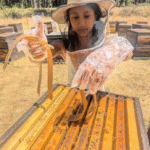
Fig. 2 The filter paper strips were a bit floppy, which made them tricky to insert (spreading the combs helps greatly). We applied all three types of strips at the rate of 1 strip per every 2.5 frames of bees, inserting them within the clusters.
The colonies did react to the hung strips, typically shifting their brood rearing away from them. Otherwise, the brood looked fine (Figure 3).
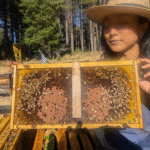
Fig. 3 The bees shifted brood rearing away from the strips.
Extended-Release Thymol
Last year we were very impressed by the efficacy of thymol-saturated soundboard blocks applied in a rim on top of the hive [[1]]. We used 40 g of thymol in that test, so I wondered how 30 g would work if applied between the brood chambers, rather than way up under the (hot) hive cover (Figure 4).
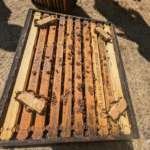
Fig. 4 I took this photo at the end of the trial, after lifting off the upper brood chamber. You can see how this colony built walls of propolis out around the blocks, which likely decreased their fumigation effect. Unlike oxalic acid, the aroma of thymol might taint the honey (not of concern if that honey is not to be sold).
Since we applied the thymol blocks in the outer corners, there did not appear to be much brood disruption in the center of the hives (Figures 5 & 6).
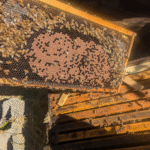
Fig. 5 At 28 days the thymol-treated hives had decent brood patterns (we often see spotty brood at this time of year, due to egg cannibalism by pollen-deficient nurse bees). Note that there was no propolization of the blocks in this hive.
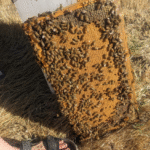
Fig. 6 However, in some hives at final grading the brood looked great!
Conditions During the Trial
The weather was generally hot and relatively dry, with no precipitation. I’ve shown our mite wash dates, daily high temperatures and average humidity in Figure 7.
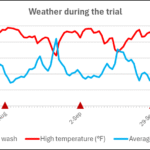
Fig. 7 We randomly assigned treatments [[2]] and installed the strips on 5-August as we took the mite counts, then took midway counts on 2-September, and final counts on 29-Sept. Weather data from nearby KCAGRASS50.
A Note on Our Mite Wash System
It took Rose and me only 145 minutes to take final mite wash counts from 78 hives (with me opening the hives and briefly inspecting them while shaking a bee sample, while Rose, working a portable agitator under a sunscreen, washed, counted, and recorded the data (Figure 8). That works out to only 1.7 minutes per wash for the two of us!
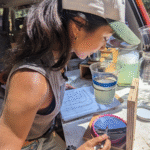
Fig. 8 We’ve developed a system that allows us to rapidly perform mite wash counts, with me opening the hives and taking the bee samples, and her popping the cups into the agitator, counting, recording, and refilling the cups.
Practical application: Our rapid mite wash system not only is a huge time saver for field research, but also the key for a selective breeding program for mite resistance, as well as for monitoring the varroa infestation rate in a commercial operation (to avoid large winter losses).
I’ll be writing about our system in an upcoming article. My helper Jacob McBride has already started a side gig fabricating the components (wash cups and portable agitators) for direct sale (Figure 9).
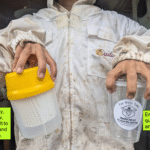
Fig. 9 The Solo cups are a much better fit to the hand, and drop the mites with minimal swirling agitation. Jake is offering 10-packs of my mite wash cup design for $20 plus shipping (great for purchase by beekeeping clubs to pass out to their members). You can contact him at forbeessake@gmail.com
Results and Discussion
I’ve plotted the progression of mite counts for the four treatments in Figure 10.
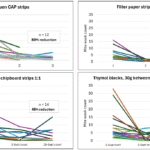
Fig. 10 Due to the number ending mite counts of zero, I couldn’t calculate percent reduction (you can’t divide by zero). So I simply divided the sum of the ending mite wash counts for each group by their starting sum to come up with an “absolute percent reduction of the total initial mite count,” which in this case, underestimates the effectiveness of the more successful treatments.
Practical application: I ran this experiment as a “comparative trial,” as opposed to a “test of efficacy,” so didn’t include an untreated Control group. Keep in mind that “percent reduction” underestimates “efficacy” (which involves comparison to an untreated Control group). At this time of season, we’d expect the mite wash counts to have at least doubled over the course of the trial, so the “efficacy” of these treatments can be presumed to have been much greater than the “percent reduction.”
Although all four treatments had achieved a relatively decent knockdown at 28 days, the General Filtration filter paper and Aluen CAP exhibited the best mite reduction at 55 days. The infestation rate rebound in the thymol group suggests that the 30 g dose was too low (or that the bees had propolized the blocks).
What surprised me is the great performance of the thin filter paper strips, which had largely lost their dampness by the endpoint. I have no idea as to why they performed better than the heavier chipboard strips.
As for as the performances of the 1:1 vs 1:2.5 OA:gly ratios, it’s hard to tease out any difference, due to the conflicting results of the chipboard and filter paper groups. I’m now in the middle of testing the amount of acidity transferred to the bees’ bodies by various oxalic application methods, which could help to explain — stay tuned!
Acknowledgements
Thanks again to my helpers Corrine Jones and Rose Pasetes.
Citations and Notes
[1] Oliver, R (2024) Extended-Release Thymol Blocks. ABJ April 2024
[2] We adjusted the assignments in the field to roughly set up a “randomized block” design for starting mite counts and colony strengths, assigning the highest starting mite count hives to the thymol group.
Contents
Feeding Thymol for Varroa Control 1
Setup. 2
Results. 8
Discussion. 10
Consumption/Removal of the Tablets. 11
Confirmation of Consumption. 12
Conclusions. 19
Acknowledgements. 20
Citations and Notes. 20
A Field Test of Apitablets
Randy Oliver
ScientificBeekeeping.com
First published in ABJ April 2025
I’m often asked by developers of new items for beekeepers, to give their products a test. So when Mehmet Batir asked me to test his new Apitablets, since they seemed promising, I gave them a try.
Feeding Thymol for Varroa Control
I’ve got lots of experience with using thymol as a fumigant to control varroa, but have not tried application in sugar patties fed to the bees, an idea suggested by Dr. Diana Sammataro [[1]]. Since then there have been some studies on the sublethal effects of fed thymol upon honey bees or their larvae [[2]], indicating that so long as the thymol percentage was kept below 0.5%, it would be safe for the bees [[3]]. And finally, there was a study by Cengiz [[4]] that demonstrated the fed thymol in sugar cake could be efficacious against varroa.
Practical application: A thymol-infused sugar block that could be fed to bees could be a great addition to our arsenal against varroa. But since I’ve repeatedly observed that bees don’t like the smell of thymol and go to great lengths to remove it from the hive, my question would be whether they would actually consume the treatment.
During our hot California Augusts and late-summer dearth, I often treat colonies with thymol for varroa control, and protein for buildup. So when Mehmet asked me to try his honey bee health product, Apitablets (Figure 1), I was curious to try the combination — solely for general colony health benefit (since the product is not labeled for miticidal purposes). That said, I was concerned about the health of my beloved varroa mites due to the thymol in the tablets, so also monitored their strength.

Fig. 1 Apitablets don’t list the ingredients in order of weight. They are not registered as a pesticide, so the warning to wear protective gloves is only a suggestion. The manufacturer’s website [[5]] prescribes placing one tablet on top of the frames in each brood box twice in the fall, 30 days apart.
Setup
I wanted to start with two equalized groups (Test and Control) of 12 hives each, so in late June (during our nectar flow) we stocked a semi-isolated yard with ~30 nucs with new queens, and allowed the colonies to grow, swapping combs of bees for three weeks to equalize them (Figure 2), and feeding sugar syrup to promote colony buildup.

Fig. 2 We equalized the Test and Control groups for both starting strength and varroa infestation rate.
20 July: Performed mite washes. Moved out two high-mite hives (since I didn’t want to lose colonies to excessive varroa loads), and moved in some low-mite hives. Added second deep brood chambers of drawn comb and combs of brood and bees with matching mite wash counts to equalize and locate brood in the centers of both brood chambers (Figure 3).

Fig. 3 The test yard, towards the end of the trial. Note the lack of forage.
22 July: Pollen and nectar flow ended, so a good time to start a test of a product claiming to promote colony health. Randomly assigned treatments, blocked by starting mite count. Graded each colony for starting strength and confirmed that the mean starting strength was approximately equal for each group. Applied 1 Apitablet to the Test hives (Figure 4), and fed 1 lb. pollen sub and half gallon 1:1 syrup to all hives.

Fig. 4 We placed each tablet in the center of the cluster (you should wear gloves).
31 July: Negligible pollen or nectar flow. Pollen sub mostly consumed. Fed another 1 lb. pollen patty and ½ gal syrup. Tablets roughly half chewed away. No apparent brood disruption by the tablets.
19 August: Inspected hives (Figures 5 & 6).

Fig. 5 The bees clearly did not like the odor of the tablets (presumably due to their thymol content), moving their broodnests away from them (a typical response to thymol). In this photo you can see the tablet stuck to the top bar of the comb that had been in the center, with the combs that had been to either side behind it. The brood area in all three combs had been shifted away from the tablet.

Fig. 6 We observed the same in most Test hives. Here are views of both sides of the central comb with its tablet stuck to the top. Due to the obvious repellency to the thymol, I fully expected that the tablets would suppress varroa reproduction.
6 Sept: The Apitablets had been mostly removed by the bees, ranging from only a trace left to nearly untouched (Figure 7). We replaced them all with a second fresh tablet. We again graded for strength, took mite counts, and fed syrup and pollen sub.

Fig. 7 Most Test colonies to consumed/removed most or all of the first two tablets applied (data in Fig. 10).
30 Sept: Apitablets averaged being half removed, so we again replaced them with fresh ones (this was a third application). Took mite counts, graded for strength, and fed syrup and pollen sub.
27 Oct: Took ending mite wash counts and graded for final strength (Figure 8). Most of the Apitablets applied a month ago were largely still intact.

Fig. 8 We followed the manufacturer’s recommendations to apply Apitablets during hot summer weather (“During the sweltering months…Apitablet’s inclusion of essential oils not only aids in fortifying bee immunity but also assists in temperature regulation within the hive”), and then through the fall (“Applying Apitablet twice during the fall, with a 30-day interval, sets the stage for strong overwintering colonies”).
Results
Since Apitablets make no pesticidal claims, what we were testing was whether they improved colony health. We measured cluster size as a proxy for colony health (Figure 9).

Fig. 9 On average, the higher red columns indicate that the surviving Control colonies gained strength, whereas the Apitablet hives lost strength (pairs lacking a red column indicate that the colony died); however, the changes were not significantly different.
Again, Apitablets make no claim for pesticidal use, but out of curiosity, we did take mite wash counts (Figure 10).

Fig. 10 Although Apitablets make no miticidal claims, the changes in mite counts were not significantly different between the two groups.
As far as the effect of applying three Apitablets, let’s compare the average cluster size progressions of the two groups (excluding colonies that went queenless, but including those that died from varroa as zeroes). The Control group went from 8.0 to 6.4 frames of bees (FOB); the Apitablet group from 8.8 to 6.8 FOB. So there was no apparent benefit as far as maintaining colony strength. Since many of the hives still contained brood at final grading, I inspected each colony’s broodnest. Reviewing my notes, there was no noticeable difference between the Test and Control groups.
To my great surprise, the application of three Apitablets (continually releasing thymol over 97 days) also did not appear to affect my beloved varroa mites. I’ve plotted the progression of their infestation rates over time in Figure 11.

Fig. 11 My concern for my pet varroa mites was unfounded, since the tablets did not exhibit any appreciable effect upon growth of their populations. The odd thing about the growth curves is the notable rise in the mite levels in the Test group in September, followed by a reduction in the survivors in October, when some of Control counts went up.
Practical note: Since we’re having success at breeding for mite resistance, it’s more difficult for us to set up trials involving mite control, since as you can see in the Control group, a proportion of our colonies keep mites largely under control by themselves.
Discussion
Beekeepers worldwide are offered all sorts of products claiming to do this or that to improve colony health. It’s easy to make claims, but what we beekeepers reasonably would like to see is some hard data to support those claims.
The claims for Apitablets are that they “support honey bee health and vitality” and “promote colony strength and well-being.” In this trial I tested whether they promoted colony strength, but had every reason to expect that the thymol in them would also affect varroa.
One of the first things we noticed about the tablets (which are nearly the size of a hockey puck) is that they were too thick, and jacked up the frames above them in the upper brood chamber (Figure 12).

Fig. 12 Note how the Apitablet pushed the two frames above it clear up to the hive cover.
It’s not clear whether the bees removed the Tablets as irritants, or gobbled them as food. I wish that I could say otherwise, but we disappointingly saw no benefit to colony performance from applying them continuously from late July through late October. And although they contained thymol, to my great surprise they did not appear to suppress the growth of varroa, since there were substantial increases in the mite populations in half the Test colonies.
I spoke with Mehmet about our results, to see whether he had any comments. He wondered whether we had under dosed, since he recommends one tablet per box ten combs of bees. Since even our very largest colonies barely made that strength, under dosing was clearly not an issue (not to mention that we applied three continuous doses).
Consumption/Removal of the Tablets
There was no lack of consumption/removal of the first two rounds of the tablets by the bees, with many of the Test colonies completely consuming/removing the first two tablets given.
Practical note: The efficacy of Apiguard thymol gel is dependent upon the bees transporting the gel particles down through the broodnest, with no ingestion involved [[6]]. So it’s not clear that actual consumption is necessary.
Since we had recorded the amounts of tablets remaining as we replaced them, I checked to see whether there was a correlation between the amount of Apitablet consumed/removed vs the buildup of mites (Figure 13).

Fig. 13 Athough there was an extremely weak negative correlation between tablet removal and mite buildup, considerable mite increases occurred in some colonies that had fully consumed/removed 1-2 full tablets.
Confirmation of Consumption
When I asked, Mehmet assumed that the mode of action of the Apitablets was due to ingestion, rather than physical removal. He wondered whether our feeding of pollen sub and syrup had kept the bees from consuming the tablets (although his website says that it’s fine to apply the tablets during a pollen and nectar flow). But there apparently had not been any tests done to determine whether bees actually consumed the tablets (as opposed to merely removing them due to their irritating thymol content).
Since I had fluorescent tracers on hand that I use to track the ingestion of pollen sub, it wouldn’t be hard for me to confirm whether the bees actually ingest the sugary tablets, or merely carry them away due to their irritating thymol scent (ingestion would be necessary for nutritional benefit, but either ingestion or removal could affect varroa).
We ran two trials on different pairs of colonies (so four replicates in total), pulverizing Apitablets, adding fluorescent tracers, and then forming them back into tablets (Figures 14-17).

Fig. 14 In my high-tech lab, I used the hatchet next to my woodstove to crush each Apitablet in a plastic bag, so that we could then powder it further in my coffee grinder.

Fig. 15 We then added fluorescent tracer (green in this case) to the powdered Apitablet, and homogenized it thoroughly.

Fig. 16 I kneaded in a little water to moisten the mixture, formed it into patties, and allowed them to dry back into solid patties.

Fig. 17 Dried fluorescent-tagged patties glowing under black light, ready for application!
Following the manufacturer’s recommendation for springtime application of Apitablets, I applied the fluorescent patties (now thinner than the original Apitablets for better bee exposure) to pairs of colonies, first at home, then to those placed in an almond orchard in full bloom (Figure 18).

Fig. 18 We placed the test “tablets” in the centers of the clusters, along with black plastic sheets on the bottom boards to catch any removed tablet debris.
In the almond orchard, I took samples of bees from adjacent to the “tablets” after a day, then again after five days, during which time it rained for two days, so the colonies interacted with the “tablets” both during pollen flow as well as when they were confined by rain. I brought the bottom board catch sheets and bee samples home for analysis under blacklight (Figures 19 & 20).

Fig. 19 Here’s a shot of a typical black plastic catch sheet from a bottom board, demonstrating that in all cases, the bees removed a substantial portion of the “tablets” and dropped them to the bottom.
Practical application: Similar to as with Apiguard gel, this transport of thymol down through the broodnest might kill varroa mites.

Fig. 20 We crushed paired samples of bees from both hives to expose their gut contents, then photographed them under blacklight (Day 1 above, Day 5 below). The glowing green blotches indicate ingested portions of the Apitablets.
Although in the lower photo two bees clearly had swallowed a substantial amount of Apitablet, overall ingestion was sporadic and rather minimal.
Conclusions
Although in this trial the feeding of Apitablets to our Test group did not indicate a benefit in either colony strength or mite suppression, some other beekeepers have given glowing reports (“««««« Highly recommended! It is easy to use and it works”). Plus the study by Cengiz indicated that feeding thymol in a sugar cake could be efficacious, although his patties were 10% thymol — suggesting that the action may have been due to fumigation, as opposed to ingestion (which would likely be toxic to the bees).
So I’m still of open mind about the benefits of Apitablets. This was a single trial performed during hot, dry autumn weather in California — results may be different in your locale. I’d appreciate seeing data from others who have tested them!
I’ll likely follow up with another trial this spring, since the claim is that “A well-timed application of Apitablet in early spring infuses the hives with a boost of essential nutrients, setting the stage for robust brood development and vigorous foraging activities”.
Acknowledgements
Thanks to my helpers Corrine Jones and Rose Pasetes, and to you donors who make our work possible.
Citations and Notes
[1] Sammataro, D, et al (2009). Feeding essential oils and 2-heptanone in sugar syrup and liquid protein diets to honey bees (Apis mellifera L.) as potential Varroa mite (Varroa destructor) controls. Journal of Apicultural Research 48(4): 256-262.
[2] Charpentier, G, et al (2014). Lethal and sub‐lethal effects of thymol on honeybee (Apis mellifera) larvae reared in vitro. Pest Management Science 70(1): 140-147.
Glavan, G, et al (2020). Comparison of sublethal effects of natural acaricides carvacrol and thymol on honeybees. Pesticide Biochemistry and Physiology 166: 104567.
[3] Aboushaara, H, et al (2017). Impacts of oxalic acid, thymol, and potassium citrate as Varroa control materials on some parameters of honey bees. Turkish Journal of Veterinary & Animal Sciences 41(2): 238-247.
[4] Cengiz, M. (2018) Effectiveness of combining certain biotechnical methods with thymol treatment against Varroa destructor infestation. African Journal of Agricultural Research 13(47): 2735-2740.
“For the treatment with thymol, bee cake was prepared (18 kg Ice sugar + 3 kg honey + 400 g pollen + 2 L water). Ten grams of powdered thymol was added to 90 g of the bee cake”.
[5] https://apimonllc.com/insights/why-choose-apitablet-benefits-of-a-natural-honey-bee-food-supplement
[6] https://scientificbeekeeping.com/thymol-a-new-application-method-part-1/
Contents
Professional Beekeeping 2
The Beginning of a Boom 3
Indicators of Change 4
The Four Booms, Sprees, and Joyrides that We’ve Been Enjoying 5
I’ll Go Over Each of the Above in Turn, and Point out Early Indicators and Preparation. 6
The Demand for Bees for Almond Pollination 6
Early Indicators and Preparation 8
The Boom of Interest in Beekeeping after CCD 8
Early Indicators and Preparation 10
The Synthetic Miticides as “Silver Bullets” 11
Early Indicators and Preparation 11
The Availability of Inexpensive Treatments 11
Early Indicators and Preparation 12
The Profitability of Beekeeping and Government Subsidies 12
The Question: Is beekeeping Less Profitable Today Than it Used to Be? 13
Impact of Colony “Loss” 15
Early Indicators and Preparation 16
Changes that May affect Profitability 16
Government Support 16
Early Indicators and Preparation 18
The Cost of Labor 18
Early Indicators and Preparation 18
Competing against Fake Honey 18
Early Indicators and Preparation 20
Outlook for the Future 21
Early Indicators and Preparation 21
Next 22
Citations and Notes 23
Is Our Party Winding Down?
Randy Oliver
ScientificBeekeeping.com
First Published in ABJ May 2025
The excessive amount of colony losses this last fall and winter has been a major disruption to our industry. Two decades ago something similar happened, shifting the economics of our industry. Since then, our industry has been riding on the backs of four resulting economic opportunities. But those rides may now be losing steam. It may be time to re-evaluate.
Professional Beekeeping
The vast majority of those who keep bees do it as a recreation, hobby, passion, avocation, or a sideline occupation. But most of the hives in North America are managed by those of us who do it as their main or only profession – often referred to as “commercial” beekeepers (a term used proudly by those who make their living at it, and sometimes disparagingly by those who don’t).
I’ve had the honor of visiting professional beekeepers all over the world, and don’t have words to express how impressed I always am with their work ethic, dedication, inventiveness, business acumen, and perseverance. Professional beekeeping as an agricultural business has always been hard, dirty work, with long hours and many challenges []. To make money, one is at the mercy of the weather, the market, and requires having strong, healthy colonies in the right place at the right time(s). As in any business, some operations are more consistently successful than others.
I myself made my living as a “small commercial” beekeeper in California for many years, pollinating almonds, selling nucs, and producing honey. It was an especially wild ride following the introductions of parasitic mites and “nosema” ceranae. Adapting to these parasites (and associated viruses) was (and continues to be) a challenge, with many beekeepers going out of business, being replaced by a new generation who’ve never known beekeeping without varroa.
Along that line, I handed my operation over to my sons a few years ago (so that I could focus upon research). This past September they got blindsided, when their colonies did not respond “normally” to the feeding of pollen sub and syrup that they’ve long used to build them up for winter. Instead, many colonies inexplicably dwindled, despite varroa being well under control, no pesticides, and low nosema. Come February, my sons were desperate to fill their longtime almond pollination contracts, and for the first time ever, came up seriously short (Figure 1).

Fig. 1 Prior to grading, Eric and Ian scavenged every comb of bees in the operation to boost the hives they’d placed in almonds. Even so, they were only able to fill two thirds of their contracts.
This was a really bad start to the year, since they count on making most of their annual income between February and the end of April (from almond pollination rentals and nuc sales), and Eric questioned whether they could even stay in business. But the reason for me writing this article is because they weren’t the only professional beekeepers wondering whether they were going to be able to continue to “make it work.”
Things change, and beekeeping is no exception. I recently visited New Zealand, where the manuka honey joyride had collapsed, resulting in a complete reset for their industry. But some established Kiwi beekeepers had foreseen that changes were likely to come, and are surviving the crisis. But turmoil is not occurring only in New Zealand — it’s also happening in Australia, throughout Europe, and in South and North America (with varroa always being involved, but also climate issues and changing markets). It occurs to me that we American beekeepers might want to think about some changes that will likely affect our own futures.
The Beginning of a Boom
Back in the day, California beekeepers used to move their hives to almond growers’ orchards free of charge, to take advantage of the early forage (as they currently do in Chile). In the mid-‘60s, almonds became more profitable to grow, so plantings increased, and need for pollination exceeded supply, so beekeepers started demanding compensation (with growers begrudgingly paying 25 cents per hive). By the time I personally began moving hives to almond pollination in the early 1980s, we were getting around $12, with rental rates going up about a dollar a year (I remember hitting $18 and thinking that I’d died and gone to heaven!). And then around 1995 two things happened: (1) consumer demand for almonds went up, so growers started a spree of almond planting, and demand for pollination services exceeded the supply of bees, and (2) varroa got firmly established.
By 2004 we’d bargained our way up to about $45 for hive rental. But by then our varroa treatments began to fail, new variants of EFB showed up, viruses went rampant, and unknown to us, “nosema” ceranae invaded the U.S. These together hammered our poor bees, and for the 2004/2005 pollination season, we came up seriously short on hives. In response, growers desperately bid the offered price to $155 (and thus could no longer bluff that they were unwilling to pay more than what they had been).
The huge increase in the offered price for beehives started a new Gold Rush to California, and the next year beekeepers from all over the country showed up with semi-loads of hives, hoping to cash in. Although the problem did not start in California, this transport also quickly spread the new parasites and pathogens all over the country (and in November of 2006 Dave Hackenberg pulled into a location in Florida where he’d left 400 hives a few weeks before, and found most of them dead and without any sign of the bees. Thus was born what later came to be known as CCD (Colony Collapse Disorder).
Practical application: In 2005 I wrote to the editors of both bee journals, pointing out that our industry had just passed a watershed moment – for the first time in history, the U.S. beekeeping industry made more money from pollination than from honey production.
Indicators of Change
The Greek philosopher Heraclitus famously observed that “nothing is constant but change.” And Rucker and Thurmond [] pointed out that “Beekeeping evolves in response to exogenous shocks.” Anyone in business would do well to read the book “Who Moved My Cheese?” by Spencer Johnson, which shows us how embrace change and adapt to new circumstances (Figure 2).

Fig. 2 I thank beekeeper Jay Miller for bringing this book to beekeepers’ attention years ago.
Some of Dr. Johnson’s key recommendations are to:
- • Embrace change: Accept that change is inevitable and that it can lead to new opportunities.
- • Be adaptable: Be open to change and ready to adjust your plans and strategies.
- • Anticipate change: Look for early indicators of change so you can prepare.
- • Be proactive: Take action to find new opportunities instead of waiting for them to happen.
To evaluate our current situation, let’s take a look at the early indicators of changes regarding the “rides” that we beekeepers in the U.S. have been on for the past twenty years, and how we might want to prepare for them.
The Four Booms, Sprees, and Joyrides that We’ve Been Enjoying
- • The demand for bees for almond pollination
- • The boom of interest in beekeeping after CCD.
- • The synthetic miticides as “silver bullets”
- • The profitability of beekeeping and Government subsidies.
I’ll go over each of the above in turn, and point out early indicators and preparation.
The Demand for Bees for Almond Pollination
We’ve been riding on the coattails of the almond industry for twenty years now, resulting in beekeepers managing for number of rentable hives rather than honey yield, resulting in overcrowding of apiaries and overstocking of the landscape in many areas. But as pointed out by Todd Fitchette, writing in Farm Progress [], this ride may be coming to an end (Figure 3).

Fig. 3 From the above article: Non-bearing almond acreage … is well under half of the average acreage of non-bearing trees in the ground over the past 10 years, suggesting that farmers have not been as optimistic about almonds as they were a decade ago.
Total almond acreage fell for the third consecutive year to just over 1.5 million acres… a drop of about 40,000 acres from the previous crop year. The decline in total almond acreage may have a multi-faceted cause. Low almond returns over the past several years have turned what was once a profitable crop into an unprofitable one, forcing some growers to give up on the crop altogether. Increased input costs to farm those almonds, and the reduction in irrigation water in some growing areas likely led farmers to remove or abandon orchards.
Not only this, but the current price of colony rental constitutes 14% of total cultural costs – more than fertilizer or pest control, and over half what they spend for irrigation []. Growers were willing to pay over $200 rent when they were making money, but not when there’s no profit margin.
Since the price for pollination jumped in 2005, there has been strong pressure to develop almond cultivars that are self-fertile, and thus requiring fewer (if any) hives per acre (and are of the quality of Nonpareil). Currently, only about 3% percent of bearing acreage is of self-fertile trees (predominately Independence). That percentage can be expected to go up, since there have been some recent advances in almond breeding (Figures 4 & 5).

Fig. 4 Yorizane is a new self-pollinating almond variety developed by USDA’s Agricultural Research Service with “superb consumer traits such as size, color, and flavor” [].

Fig. 5 Even more worrisome to us almond pollinators, are two new gene-edited self-fertile cultivars of Nonpareil [], which may match Nonpareil in quality.
Almond orchards are typically replanted every 25 years, and take 3-4 years to produce a harvest. So growers are cautious about gambling on planting new cultivars until they’ve been field tested (and sold) by fellow growers. I just heard that one of the nurseries that had been selling a self-fertile cultivar that had been competing with Independence, is now telling their growers to pull them out and replant with something else.
Early Indicators and Preparation
USDA’s 2023 California Almond Nursery Sales Report indicated that 42% of recent sales of trees have been for self-fertile varieties []. Since total almond acreage has plateaued, and is shifting towards self-fertile cultivars, we can expect the demand for hives for pollination to decrease substantially. Growers will likely be back in a strong bargaining position, with supply of hives exceeding demand. Many of us will need to adjust our business models.
The Boom of Interest in Beekeeping after CCD

Fig. 6 An example of the sudden collapse of one of my own colonies down to a silver-dollar sized patch of bees and their queen. Although this symptomology largely disappeared by 2010 (as nature selected against bees that couldn’t handle “nosema” ceranae), concern about bees “disappearing” got the world’s attention.
Out of curiosity, I ran a Google trends search for the use of the phrase “save the bees” (Figure 7).

Fig. 7 Timeline of searches for the phrase “save the bees.” Interestingly, although there was a spike right after CCD made the press in 2007, interest appeared to peak ten years later. But then note that it’s been in decline since then.
Being put in the limelight benefitted us in several ways:
- • It made it a lot easier for us to get new bee locations,.
- • Public awareness and pressure helped to reduce pesticide issues.
- • There was more funding for bee research.
- • An increased demand for those of us who sold bees or queens.
- • An awareness that the consumer could help beekeepers by buying local honey.
- • And perhaps most importantly, a huge shift in the demographics of beekeepers, with far more women and younger beekeepers getting involved.
The beekeeping supply houses enjoyed a wild (and very profitable) ride from the hobby interest in beekeeping, which often led to shortages in essential beekeeping woodenware and feed. It also brought a gazillion new products to market, but unfortunately not lower prices (adjusted for inflation).
Although the best way to save the bees is to provide more insecticide-free forage, many people decided to give beekeeping a try (Figure 8).

Fig. 8 Similar to saving the bees, the interest in beekeeping also appears to be wearing off, as people learn that there’s more work involved than they hoped. I still wonder whatever happened to all the hives bought by newbies who later gave up when they realized that work was involved in being a bee-keeper!
Early Indicators and Preparation
It appears that we are on the downside in the hump of public interest in bees and beekeepers, and that a younger and more diverse generation will likely settle into a more stabilized market.
The Synthetic Miticides as “Silver Bullets”
Since the discovery that the agricultural miticide tau-fluvalinate could also be used to control mites in beehives, our industry has been dependent upon synthetic miticides. But there are three issues with the current miticides (aka acaricides): (1) Loss of efficacy, (2) the availability of inexpensive treatments, and (3) the need to learn how to shift to other methods of mite control. I’ll go over them one at a time.
Loss of Efficacy
The synthetic miticides were “silver bullets” that cleared varroa from our hives like the wave of a wand. The bummer is that mites have shown their ability to fairly rapidly evolve resistance to neurotoxic synthetic acaricides. As bemoaned by Dr. Frank Rinkevich, the synthetic miticides “work great until they don’t” (Figure 9).

Fig. 9 In recent years I’ve visited beekeepers all over the world (here Camilo Valdivia in Chile), and everywhere I go they complain of amitraz no longer being efficacious.
Early Indicators and Preparation
In parts of Canada, mites are nearly fully resistant to amitraz [], and in many U.S.operations, mites are also exhibiting degrees of resistance. Unless there is another silver bullet in the pipeline that I haven’t heard of, commercial beekeepers are going to need to learn how to shift to other methods of mite control (something I hope to cover next month).
The Availability of Inexpensive Treatments
Many commercial beekeepers have been saving money with “off label” use of miticides registered for other uses – notably amitraz. The EPA has long been turning a blind eye to that practice. But since the Agency has now registered both Apivar and Amiflex specifically for varroa, it has lost patience with beekeepers who are flouting the law by using amitraz products not registered in the U.S., and has been disrupting the supply by cracking down on the smugglers (Figure 10).

Fig. 10 “In pleading guilty, the defendant acknowledged that since at least November 2020, he coordinated the smuggling of … Taktic and Bovitraz. Maximum Penalty: Five years in prison and $250,000 fine” [] (AI generated image).
Practical application: It remains to be seen how these actions are going to affect the availability of low-cost amitraz treatments.
Early Indicators and Preparation
It’s likely to become more difficult to obtain cheap amitraz. This will add an additional expense to operations that have enjoyed this inexpensive treatment.
The Profitability of Beekeeping and Government Subsidies
Commercial beekeepers are struggling with tight operating margins, trouble keeping varroa under control (with resultingly high winter losses), and depressed honey prices. Some months ago, a questionable offer was made to beekeepers by an entity called Geocure, which offered to buy their hives and pollination contracts for a lavishly generous sum. A number of those thinking of retirement were eager to jump at the opportunity of cashing out (if the offer wasn’t a scam). This observation suggests that a number of beekeeping operations are “on the edge,” which raises the following question:
The Question: Is beekeeping Less Profitable Today than it Used to Be?
Beekeeping as a business has always been hard work for minimal return – there are easier ways to make money. Most of us do it for our enjoyment of the occupation, the lifestyle, and the connection with “our” bees. Sure, we all know that varroa has made things tougher, but is the business of beekeeping less profitable than it used to be? Let’s compare the returns from our main revenue sources, compared to the inflation of the dollar over the past 37 years (Figure 11).

Fig. 11 A dollar in 1988 would be worth $2.75 today. Labor has tracked inflation, but our returns for pollination, honey, or nuc sales have increased far more greatly – suggesting that beekeeping might actually be more profitable today than “back then.” (Some prices from memory, honey data from []).
Curious, I searched for historical data on income and expenses for commercial beekeeping prior to varroa. Thanks to Rucker,Thurman, and Burgett [], and more recently, Champetier, Lee, and Sumner [], there are some great reviews. But I struck gold with a 1994 paper by Hoff and Willet [], which had a copious number of data tables for beekeepers in different regions, and by size of operation – based upon an extensive 1988 survey. This allowed me to compare the profitability of commercial beekeeping “back in the old days” (before varroa and the jump in almond pollination) to our situation today (adjusted for inflation).
Let’s begin by seeing what sizes of operations were profitable back then (Figure 12).

Fig. 12 All operation sizes were in the black other than those in the 5-10 thousand hive range (perhaps due to being in expansion mode?).
Back in 1988, honey sold for about 40 cents per pound. Pollination fees varied across the country by crop, ranging from $9.50 to $35. The hourly wage rates paid to hired labor averaged $5.83 for full-time workers and $4.59 for part-time workers. So how do the revenues and expenses back then compare to those today?
I used the data from Hoff and Willet for 1988, which they had broken down for income by region of the country, revenues for “full-time” beekeepers, and expenses by operation size. In Table 1, I show their Midwest and West figures, and Country averages. In red I convert the averages into today’s dollars. Then for comparison, I added my best guess estimates for figures for a commercial beekeeper today.

Table 1. Out of curiosity, I spent a lot of time creating this table, using guestimates for the 2025 figures. Since varroa, labor per hive has roughly doubled (plus cost of treatments). Costs for feed and trucking will of course vary greatly with one’s location. Some have more income from bee or queen sales, from using use cheaper miticides, or government/insurance benefits. I’d appreciate any feedback on current revenue and expense figures from other commercial beekeepers, since I’d like to follow up on John Miller’s calcs on what it costs to supply a hive for almond pollination.
Bottom line: Even though we get a heckuva lot more today for almond pollination, our expenses for labor, feed, queen replacement, and trucking have increased more than inflation. So it appears that commercial beekeeping is in the same ballpark of profitability today than it was back then. But that is greatly dependent upon one’s overall colony “losses.”
Impact of Colony “Loss”
This is a touchy subject to write about. Back in the day, the standard rule of thumb for almond pollinators was “plan on being able to take 2/3 of your June colony count to almonds.” Some degree of colony or queen failures was expected, and during summer, in autumn, and again in February we combined our weak or poorly-performing colonies. This 33% reduction in hive numbers was an accepted rate of “colony loss” prior to varroa. So now, with many beekeepers failing to adequately control mites, the surveys trumpeting 40% colony loss rates come as no surprise.
That said, the percentage of colonies that fail (for whatever reasons) definitely affects one’s bottom line. So I did some more seat-of-the-pants calcs (Table 2).

Table 2 It’s no surprise that the lower your losses, the more profitable your business. These rough calcs indicate that 50% (or greater) losses put you in the red.
Early Indicators and Preparation
It’s hard to stay in business unless you control varroa! Due to issues with amitraz, many beekeepers will need to learn other methods of mite management. Due to decreasing honey crops, and the outlook for almond pollination demand, many beekeepers may need to tighten their belts (especially those distant from California).
Changes that May Affect Profitability
Government Support
Since I’ve brought up the touchy subject of government support, I may as well address this next, since as I type these words, the news is rife about a guy named Elon who is taking a chainsaw to federal outlays and support programs.
U.S. farmers and ranchers receive a good deal of taxpayer support in the form of farm subsidies, and the beekeeping industry gets our share of it. Back in 1988, government payments accounted for about 25-50% of the revenue reported by the beekeepers surveyed. Today there is no lack of programs that beekeepers are eligible for [], a primary one being The Emergency Assistance for Livestock, Honeybees, and Farm Raised Fish Program (ELAP), which provides emergency assistance to eligible producers of livestock, honeybees, and farm-raised fish who have losses due to disease, adverse weather, or other conditions, including losses due to blizzards or wildfire (Figure 13).

Fig. 13 Annual ELAP compensation for emergency losses. Total annual outlays have been in the $40-50 million range (for only about 1% of colonies in the U.S. each year, at around $120 per colony). This program has saved many beekeepers asses. Source [].
“In 2019, about 57% of all colonies were insured, with subsidies totaling $25 million ... For perspective, total beekeeper income in 2017 was $695 million” [] (that works out to less than 4% of total income).
Practical Application: However, there are gripes that some beekeepers have learned to “work the system,” with some having received hundreds of thousands of dollars, year after year for their recurring “emergencies” []. In my own case, I was averse to applying for taxpayer handouts, but this January I encouraged my son Eric to apply for ELAP compensation for his serious unexplained losses – not simply because those losses put us into the red, but because if we didn’t receive the compensation that others are getting, we’d be competing on an uneven playing field, since those who get checks for many thousands of dollars each year can then sell their honey or nucs, or rent their hives at cheaper rates than we can.
Our new Administration is telling the USDA to cut 10% of their outlays. So Elon will likely be looking for programs tainted by fraud or abuse. So I did a quick internet search to see what he might find.
Taxpayers for Common Sense and the influential Cato Institute may help him look for targets: “The federal government spends more than $30 billion a year on subsidies for farm businesses and agriculture…Like many subsidy programs, farm programs suffer from bureaucratic waste and recipient fraud and abuse” []. Although much of that abuse goes to wealthy farmers who don’t need the help, they are also the ones with the most political clout.
A 2017 audit by the Inspector General for the USDA found that beekeepers received nearly 80 percent of all ELAP commodity payments, and that there were questions about overpayments [].
Early Indicators and Preparation
At the time of this writing, the pause in ELAP was lifted, but Government assistance to beekeepers will likely be under continued scrutiny and pressure to be reduced. Plan accordingly.
The Cost of Labor
Farm labor (adjusted for inflation) doesn’t cost much more today than it did in 1988. But our current Administration is hellbent on deporting undocumented workers. Due to the law of supply and demand, this could raise the cost of agricultural labor (including beekeeping).
Early Indicators and Preparation
It’s not like the old days when you could hire high school and college kids during the summer – few Americans nowadays are interested in hard, hot, dirty outdoor work. And without a labor pool of immigrants, it’s too early to tell how much it’s gonna cost to hire beekeeper labor in the future.
Competing Against Fake Honey
A huge issue in the profitability of beekeeping is that although the honey that our bees produce is beloved by U.S. consumer, its market price is suppressed by competition with “fake honey” largely from China, which can be produced at a much lower price (Figure 14).

Fig. 14 This “economically motivated adulteration” of honey really hurts us, because it sets the bottom line for the price of true honey, since large food manufacturers can state that their products contain “honey,” even if it is actually flavored rice syrup. Source [].
Perhaps as worrisome, agricultural efficiency and herbicides have greatly reduced our once-plentiful forage, and climate change means unpredictable weather, with more droughts and stronger storms. As a result, honey yield per hive has been on a downward trend (Figure 15).

Fig. 15 Although honey yield has been trending downward, the inflation-adjusted price for honey has been going upward (black trendline), resulting in an increase in the inflation-adjusted net income per hive for honey production.
There is some government action being taken to thwart the importation of “mislabeled” honey (Figure 16).

Fig. 16 Special agents with U.S. Immigration and Customs Enforcement’s (ICE) Homeland Security Investigations (HSI), and officers with U.S. Customs and Border Protection (CBP) seizing illegally imported Chinese honey destined for U.S. consumers. Source [].
But despite the pleas from our industry for the creation of a Standard of Identity for honey, the FDA has deferred [], and it’s been up to the AHPA and other parties to file antidumping duty petitions for the Government to enforce antidumping measures against “honey” being sold at less than fair value (due to its causing material injury to the domestic raw honey industry).
The EU better understands that artificially-low honey prices are an aspect of food security, since the sustainability of beekeepers is necessary to supply the pollinators for many agricultural crops, and that “current rules do not take account of fraudulent practices affecting processed products such as biscuits breakfast cereals, confectionary, etc.; whereas the label ‘honey’ can mislead consumers in regard to the real content of the given product” [].
There appears to be more pressure in the EU to move forward on reducing honey fraud, but “analytical methods to ascertain honey authenticity exist but are lagging behind and are lacking sufficient sensitivity to detect low and intermediate levels of sugar adulterations. Thus, fraudsters are adapting the level of adulteration with extraneous sugars in honey to exploit the weakness of the current analytical capabilities” [].
Early Indicators and Preparation
The demand for hives for almond pollination appears to be downhill. So unless we can get serious enforcement against the import of fake honey, it will be more difficult for commercial operations to remain profitable with honey production as their sole source of income.
Good news! The American Honey Producers Association was proud to announce the introduction of the Honey Integrity Act. In partnership with Representatives Steube and Panetta, and Senator Tuberville, they have worked hard to craft a bill that will bring fairness back to honey markets.
Outlook for the Future
Early Indicators and Preparation
Bob Dylan said it well: The times they are a’changin’. Similar as to what is currently occurring in both New Zealand (following the crash of the manuka bubble), Australia (undergoing the invasion of varroa), as well as in most of the rest of the world (failure of miticides and the invasions of hornets and tropilaelaps) beekeeping industries are undergoing “resets” as they adjust to new realities.
Keep your Eye on the Rainbow! During times of economic changes or even collapse, opportunities arise for businesses that are able to adapt (Figure 17).

Fig. 17 I love this photo from Northern California recently shared with me by Katie Davis. Although the storm cloud looks threatening, you can focus instead on the rainbow.
When times are tough, some give up, but others address it as a challenge. Beekeeping is hard work, with a slim margin of profit, and much dependent upon weather and colony health. Let me wrap up with a couple of quotes:
What is a Disaster for Most is an Opportunity for a Few – Richard Ney
Opportunity is missed by most people because it is dressed in overalls and looks like work – Thomas Edison
My sons were heartbroken as they watched their colonies dwindle away last autumn, and then hauled in truckloads of deadouts, rather than enjoying the profit they had planned to make from almond pollination (this put them in the red). But as I type these words, they are working their butts off, splitting their returned hives into nucs today (despite the weather going from sunny and warm to cold and snowing). That’s beekeeping!
Next
A New Era in Mite Management
Citations and Notes
[1] Get an idea by reading the book Bad Beekeeping by Ron Miksha (2004), or watching the movie The Last Beekeeper by Jeremy Simmonds https://tubitv.com/movies/578162/the-last-beekeeper
[1] https://ecg742.wordpress.ncsu.edu/files/2019/03/Combing-the-Landscape-complete-package.pdf
[1] https://www.farmprogress.com/tree-nuts/calif-almond-acreage-continues-to-decline
[1] https://coststudyfiles.ucdavis.edu/2024/09/30/AlmondsSJVNorth%20Final%20draft4.pdf
[1] https://www.ars.usda.gov/news-events/news/research-news/2021/researchers-develop-self-pollinating-almond-with-a-gold-mine-of-tasty-traits/
[1] Lee, C (2025) Gene editing behind two new self-pollinating Nonpareils. Ag Alert 29 Jan 2025.
[1] United States Department of Agriculture National Agricultural Statistics Service 2023 California Almond Nursery Sales Report.
[1] Bahreini, R, et al (2025) Arising amitraz and pyrethroids resistance mutations in the ectoparasitic Varroa destructor mite in Canada. Scientific Reports 15(1): 1587.
[1] https://www.justice.gov/usao-sdca/pr/man-pleads-guilty-conspiring-smuggle-pesticides-united-states
[1] https://usda.library.cornell.edu/concern/publications/hd76s004z?locale=en#release-items
[1] Rucker, R, et al (2019) Honey Bee Mortality, Markets, and the Food Supply. Choices 34(4): 1-9.
[1] Champetier, A, et al (2019). Honey, forage and almond-pollinating honey bees. Choices 34(4): 1-8
[1] Hoff, F & L Willett (1994) The US Beekeeping Industry. USDA Economic Research Service, Agricultural Economic Report AER-680.
Due to concerns about the effects of recently-introduced mites, the use of certain toxic chemicals in honeybee foraging areas, increasing honey imports, and possible changes in the honey price support program, Congress mandated a study of the state of the beekeeping industry in 1987. The result (the 1988 Honey Industry Survey) was analyzed in detail in this paper.
[1] https://www.usda.gov/sites/default/files/documents/usda-programs-resources-support-beekeepers.pdf
[1] https://extension.okstate.edu/fact-sheets/print-publications/agec/disaster-assistance-for-honeybee-producers-a.pdf
[1] https://www.rcreader.com/news-releases/usda-extends-sign-emergency-assistance-eligible-producers-livestock-honeybees-and-farm
[1] https://www.fsa.usda.gov/documents/state-al-infoianapmt24finaldt25002
[1] https://www.cato.org/sites/cato.org/files/2023-08/briefing-paper-162.pdf
[1] https://usdaoig.oversight.gov/sites/default/files/reports/2024-11/03702-0001-23_FR_09282020.pdf
[1] https://sgp.fas.org/crs/misc/IF12185.pdf
[1] https://www.ice.gov/news/releases/ice-cbp-houston-seize-illegally-imported-honey-valued-245-million
[1] https://cambp.ucdavis.edu/sites/g/files/dgvnsk2526/files/media/documents/honey_white_paper.pdf
[1] https://www.europarl.europa.eu/doceo/document/TA-8-2018-0057_EN.pdf
[1] https://food.ec.europa.eu/food-safety/eu-agri-food-fraud-network/eu-coordinated-actions/honey-2021-2022_en#findings-of-the-eu-action
Smokin’-Hot Mite Washin’
2025 Update
Randy Oliver
ScientificBeekeeping.com
Monitoring the infestation rate of your colonies
One has an ethical responsibility to prevent the suffering of any livestock under their care. Most commercial stocks of honey bees, unless “treated” for varroa, will die an ugly (and preventable) death. Most colony losses are due to inadequate management of varroa. Even organic standards state that “All appropriate medications must be used to restore an animal to health when methods acceptable to organic production fail.” The only way to determine whether your colonies are suffering from varroa is to monitor their infestation rate.

A Necessary Sacrifice
When you get a blood draw, you sacrifice millions of living cells in order to monitor the health of your body organism as a whole. The same concept applies when one performs a mite wash to monitor the varroa infestation rate of a colony.
I don’t like to cause the death of a single bee, and go to lengths to save any bee that I can. I’ve tried sugar rolls, CO2 mite counts, and stickyboard monitoring, but find that they often underestimate the actual infestation rate. So in order to save the colony from an ugly death from the varroa-virus complex, I’m forced to sacrifice some bees. I justifiy this by keeping in mind that any worker would altruistically sacrifice themself to benefit their colony, so it’s well worth it to sacrifice 300 bees to prevent the death of the remaining 40,000 bees in the hive (keep in mind that ~1000 workers wear themselves out and die every day).
Hobby or small-scale
(Scroll down for commercial or selective breeding)


Some manufacturers copied my original design for a swirl-type mite wash cup (shaking just keeps the mites stirred up). Jake is now selling them in 10-packs.
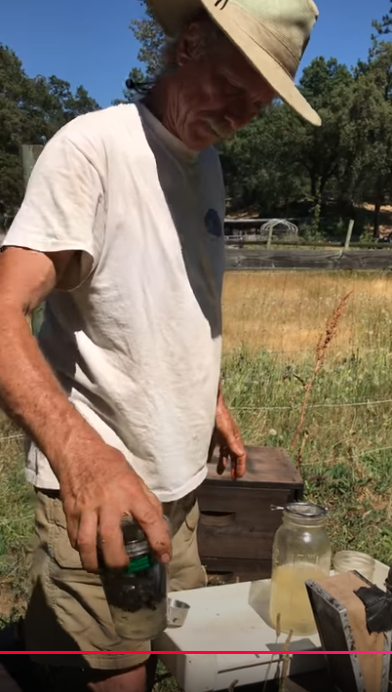
I’ve filmed a short video of me performing a mite wash here.
Tip: When dealing with a package, nuc, or otherwise tiny colony that needs every bee, take only a 1/4-cup sample of bees (~157 bees). Even that small number of bees will give you a 96% chance of getting at least one mite if the colony has a 2% infestation level.
Commercial or selective breeding
For large scale varroa monitoring, notably for the selective breeding of mite-resistant bees, one needs to be able to assess the mite infestation rates of large numbers of colonies quickly and inexpensively.
Variation in Mite Counts
In any group of hives, even those from the same queen mother, there can be a large variation in each colony’s ability to resist varroa buildup:
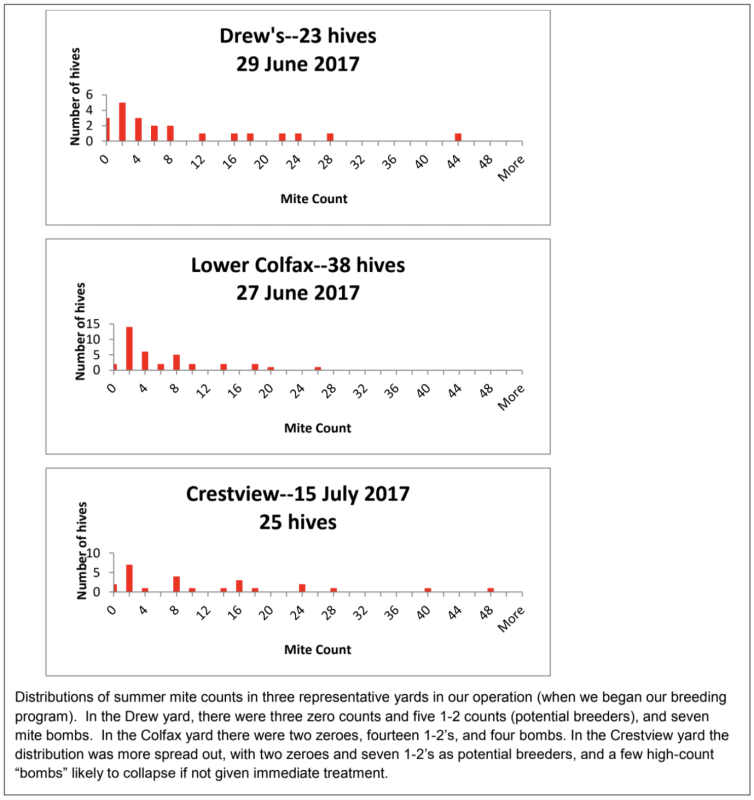
For a breeding program, you’re interested in propagating the genetics of those colonies that keep their mite counts far lower than the norm (positive selection) and eliminating the genetics of the mite bombs (negative selection). For the general beekeeper, spot sampling largely leaves you blind to what the current mite situation is, and will miss the “mite factories” that spread mites throughout the yard.
The Best Metric for a Selective Breeding Program for Mite-Resistant Bees
Several research groups [[1],[2],[3],[4]] have come to the conclusion that Harris and Harbo were right back in 1999 [[5]]:
- We define mite resistance as the ability of a colony of honey bees to impede the growth of a population of varroa.
- With this definition, a highly resistant colony of bees would cause a mite population to decline and then to either disappear or be maintained at a very low level. This is the breeding objective.
- There is no need for colonies to die in a breeding program that selects bees for resistance to mites
- By comparing the growth of mite populations in each colony, one can determine which bees are more resistant to mites.
How to Do It
The quickest and most accurate way to compare mite growth rates is to start a large number of package or nucleus hives, all beginning with minimal infestation rates, and then use alcohol or detergent washes of samples of a half cup of young worker bees to determine their degrees of infestation.
To perform selection, you must be able to measure variation, meaning that you must allow the mite infestations to grow until the less-resistant colonies exhibit wash counts of at least 10 (a level at which mites can still be controlled by a treatment).
This typically takes 2-3 months (you can assess by spot washes). At that point, tag those colonies with counts of zero or 1 as “potential breeders” and treat the rest. From that point on, rewash the potential breeders every month, treating any in which the mite counts have increased (and remove them from the potential breeder pool).
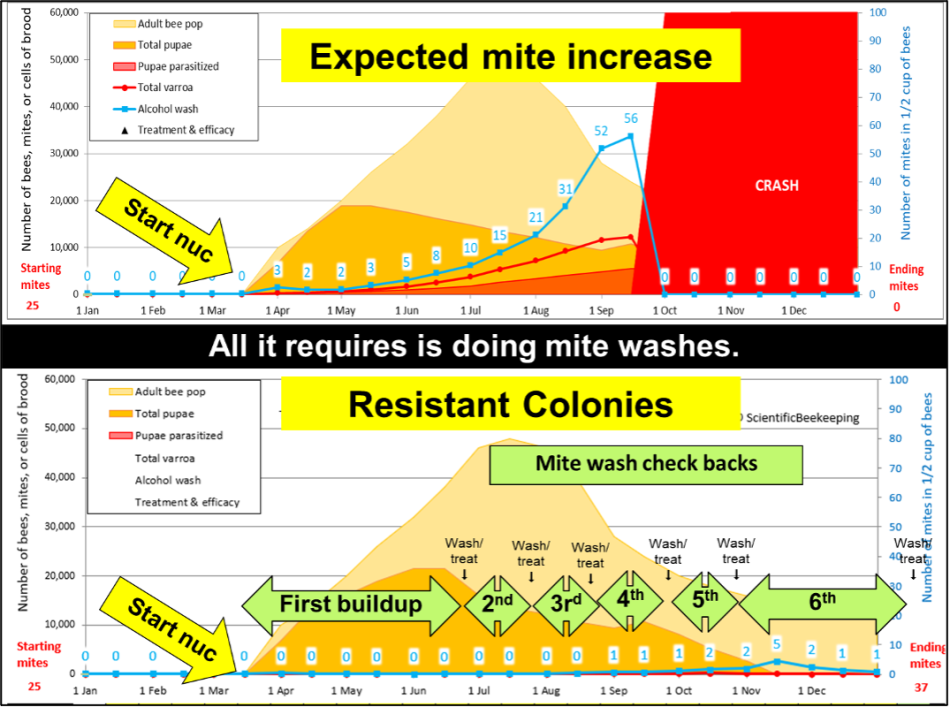
Two simulations showing the difference between typical non-resistant colonies and resistant colonies.
After identifying, marking, and withholding treatment from those potential breeders, we immediately treat the rest of the hives. Each potential breeder from the first test period must then prove that their low first count wasn’t a fluke–by testing low again at the second and third mite washes. Fortunately, I need to wash far fewer colonies for those tests, since I eliminate the vast majority from consideration at first wash, and even more at each subsequent wash.
Practical application: I’m mite washing these yards in the same order that we made up our nucs, so that each group of hives has had the same amount of time for the mites to build up. So this sampling does not delay our treating of our yards in order to keep varroa under control.
Smokin’-Hot Mite Washin’
I’m happy to say that we’ve figured out a way! What changed the game was using mechanical agitators. A two-person crew can easily perform washes at the rate of one every two minutes (including taking the bee sample, washing and counting the mites, and labeling the hive). This works out (assuming $25/hour for labor) to only $1.67 per hive sampled—less than the cost of most treatments. And that’s working at a comfortable and sedate rate–yesterday, we stepped up the pace and sampled our last yard of 25 hives in only 35 minutes (from when we pulled in ‘til we drove out). My assistant Tara and I used to sample up to 150 hives a day (including driving to five different yards).
How to Do it
Following is a short pictorial of how we currently perform mite washes quickly, accurately, and with the minimal amount of labor (typically at the rate of 3-4 man-minutes per wash).
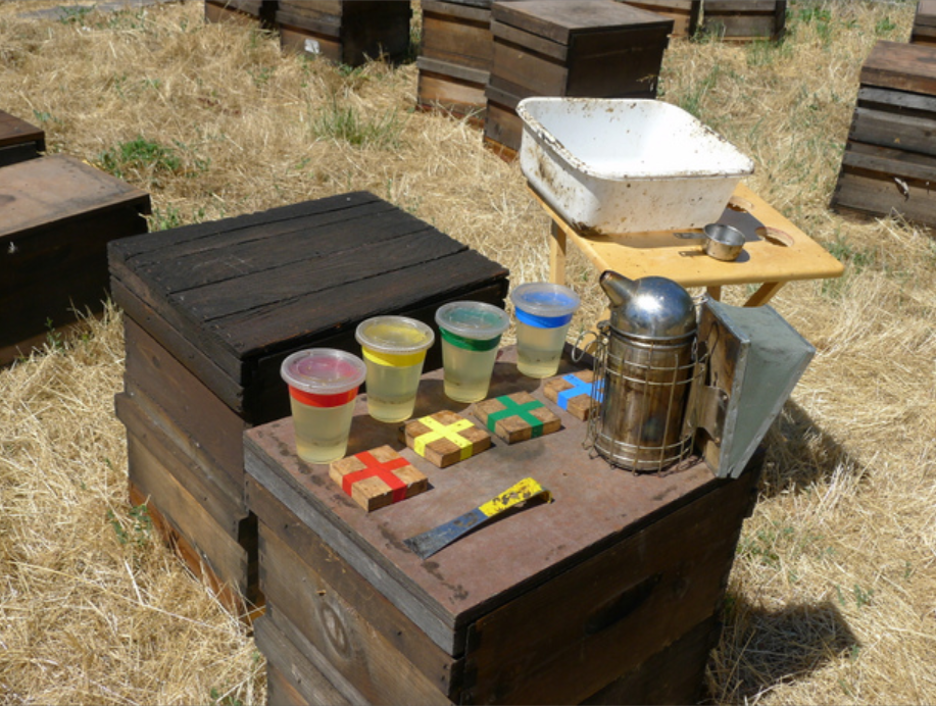
The necessary sampling equipment (above). Four color-coded mite wash cups and markers [[6]]. We no longer use the optional folding table to move along near to the hives. A white plastic 18-qt (12-qt is too small) dishwashing tub, and a stainless steel half-cup measuring cup [[7]]. . The colored tape on the cups also indicates the fill level for the wash liquid (every detail helps).
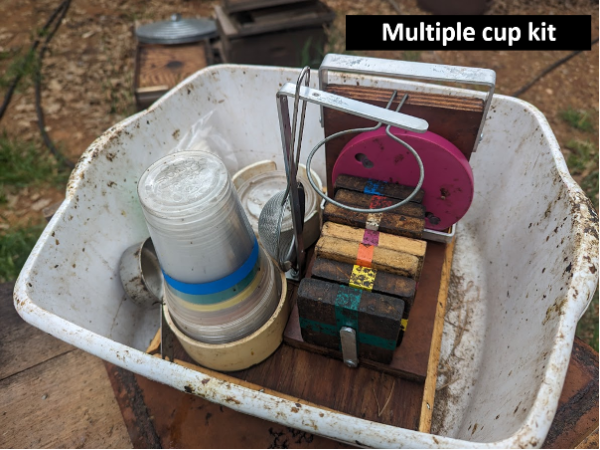
You can make a marker holder and mirror holder for counting.
Color Marking
We’ve found that there is less confusion if we simply color mark each bee sample and the hive it came from, using vinyl electrical tape (dirt-cheap on Amazon). We use 7 or 8 colors (red, green, blue, orange, yellow, white, purple), and silver) each of which starts with a different letter.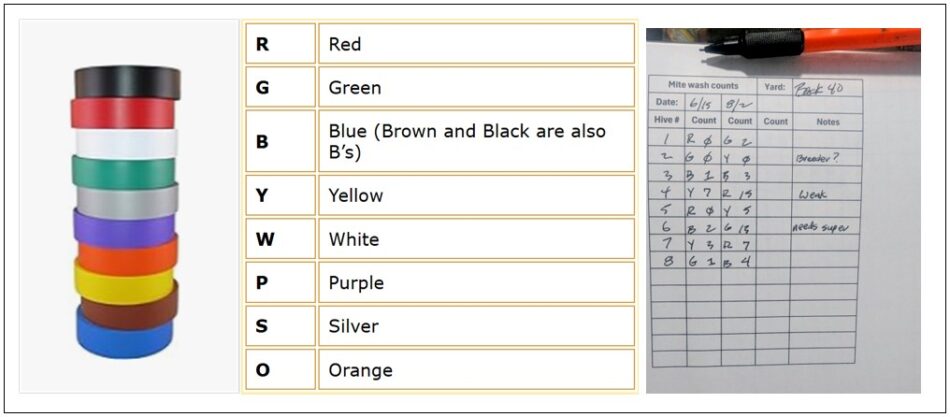
Colored vinyl tape is cheap. On the field data sheet, mark the letter for the color of the cup when you record the wash count. This gives you a checkback if there is any question.
The Washing fluid
If using alcohol, you’ll get quicker release and better recovery of the mites with 90% alcohol than with 70% (50% doesn’t even kill them!) We now use Dawn Ultra detergent mixed at the rate of 1 Tablespoon per half gallon (2 liters) of water. For more info, see *
Although mites release a bit more quickly (and sink faster) in 91% alcohol, we’ve found that high-sudsing Dawn Ultra (or Dawn Professional) detergents work as well, and are far less expensive. Low-sudsing detergents do not work well (https://scientificbeekeeping.com/refining-the-mite-wash-part-4-comparing-the-release-agents/).
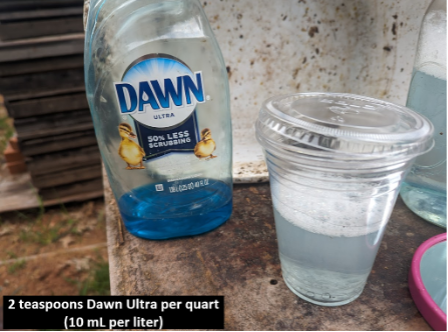
We typically mix at 1 Tablespoon per half gallon of water. If you can’t find Dawn, use a high-sudsing detergent containing sodium lauryl sulfate, sodium laureth sulfate, and C10-16 alkyldimethylamine oxide.
Timing of the First Sampling
I do my first sampling when colonies are still only doubles (before adding honey supers)–which allows adequate time for mite levels to build up enough to see a large degree of hive-to-hive variation in mite counts. The key is to sample just before you apply your first summer mite treatment (you could do it right after you pull your honey supers if that works better).
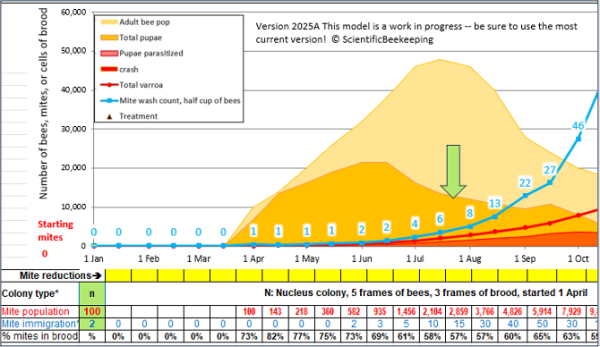
Timing for a colony started from a nuc, treated with oxalic acid when made.

Timing for an overwintered colony, treated during the winter brood break.
The point: Allow the mites to increase enough to differentiate between resistant and non-resistant colonies
Which Type of Comb to Take the Bee Sample from?
Shake the bees from a comb to the side or immediately above the broodnest.
For consistency for comparing mite wash counts, the bee samples should be taken from combs representative of the infestation rate of the colony as a whole. What I’ve found [[8],[9]] is that samples taken from combs containing open brood tend to have higher, but more erratic counts. Plus you stand a greater chance of harming the queen. Better to shake the bees from a comb on the outer edge of the broodnest (to the side or immediately above), and allow the older bees to fly off – leaving a bee sample of younger bees with a representative mite count.
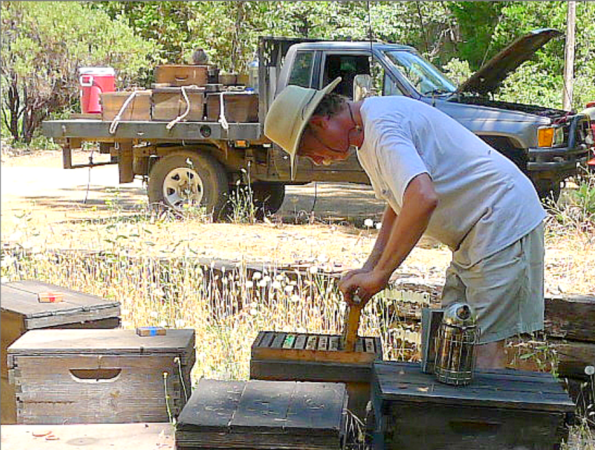
I pull a similar frame from each hive—typically two frames in from the outside of the cluster. I want a frame with beebread, but don’t want to disturb the actual broodnest or the queen. Avoid combs with drones, since even a single drone can greatly skew the count upward [[10]].
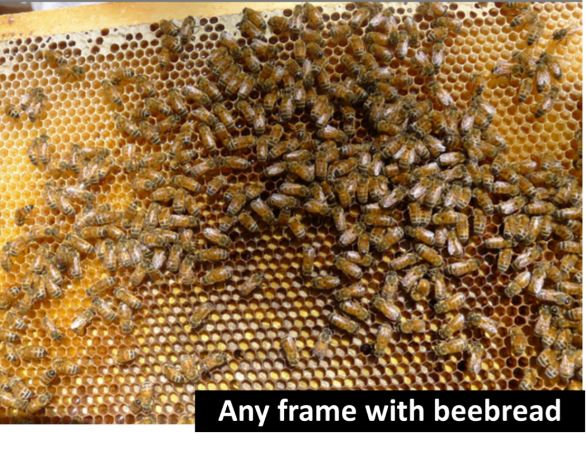
I pull a similar frame from each hive—typically two frames in from the outside of the cluster.
The person pulling the frames needs to have a good eye for spotting queens. I look for the queen as I step to the tub (which I now typically place on an adjacent hive) [[11]]. These photos were taken in near 100°F (38°C) weather, hence the truck and the sample table being placed in the shade
At this point (if I’ve pulled a brood frame) I can assess any hive for brood pattern, disease, honey production, etc. There’s no sense choosing breeders if they don’t head productive, healthy hives.
Practical application: This “mini inspections” pay for themselves, since they alert you to any colony that has issues or needs feeding or space.
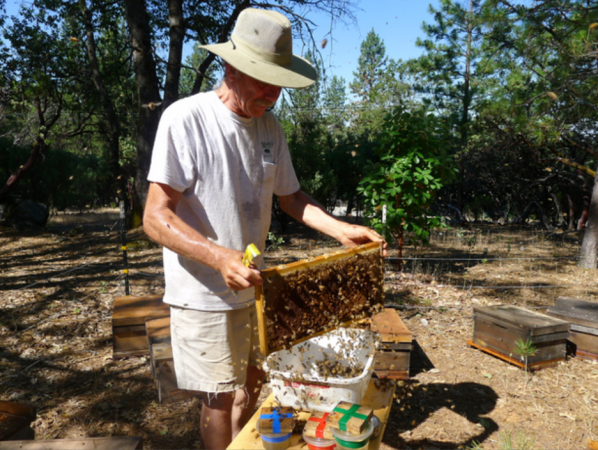
One quick shake into the tub (do a hard snap shake, since younger bees hold on tighter than do older bees). Don’t shake any more bees than you need, as it makes it harder to spot a queen! If too many bees go into the tub, scoop some back to the hive before you even look for a queen.
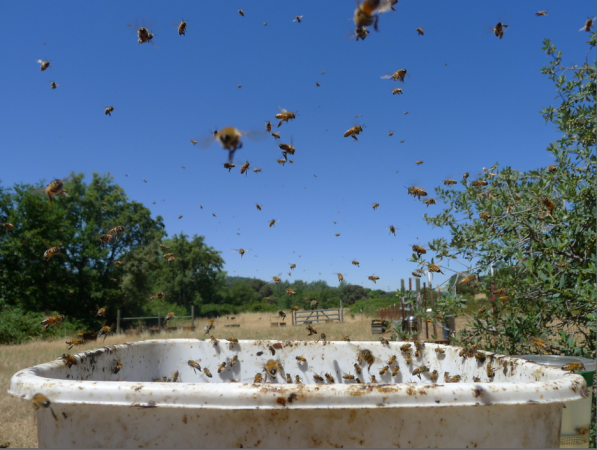
Allow the older bees to fly off. This takes only several seconds — leaving only mite-rich younger bees for sampling. During the fly off, replace the comb, and close the hive.
Practical application: this also immediately tells you something about colony condition — in a shake from a healthy growing colony, most of the bees will stay in the tub (indicating a population of mostly young bees). Conversely, if most of the bees fly off, it indicates that the hive has been broodless for a while, or that is isn’t growing.
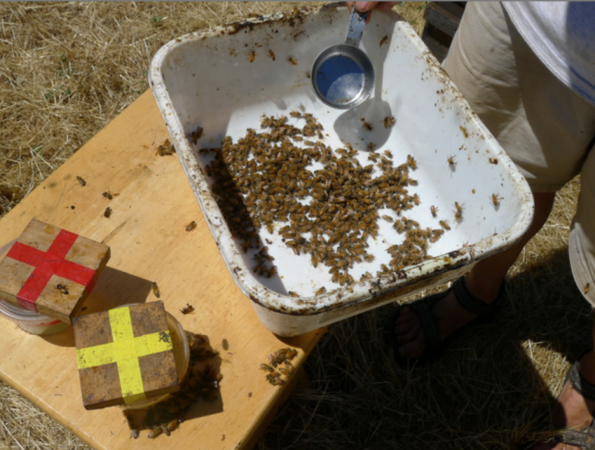
This is all the bees that you want in the tub.
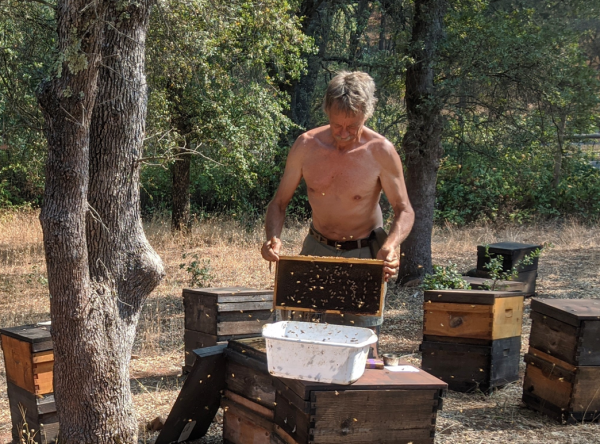
Most of the bees in the upper brood box of will be mid-age and nurse bees, which are not inclined to sting. This shaking does not elicit any defensive behavior on the bees’ part— in hot weather I can do this all day long without a defensive sting.
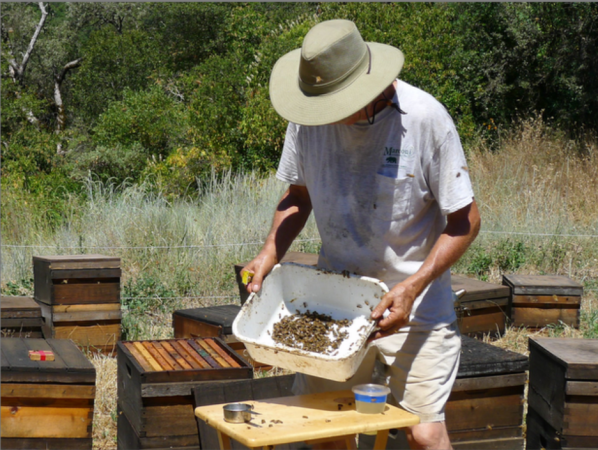
Immediately after the older bees have flown off, the remaining young bees will fan out in a single layer, making it very easy to spot the queen if you missed her on the frame.
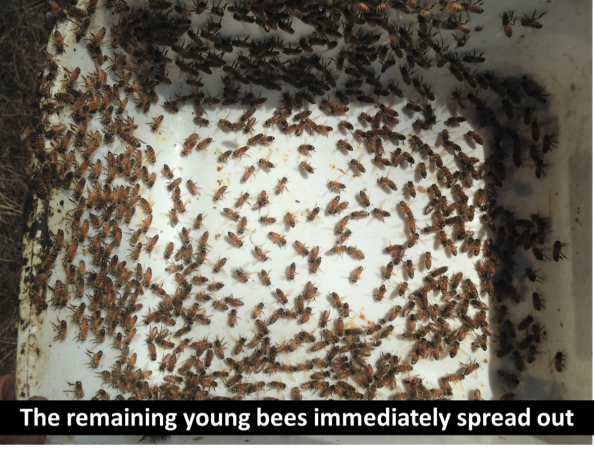
It’s typical for the remaining young bees to march in a circle. Always look for a queen before scooping up the bee sample. It is extremely rare for us to accidentally kill a queen.
Look carefully, since you don’t want to accidentally kill a potential breeder queen!
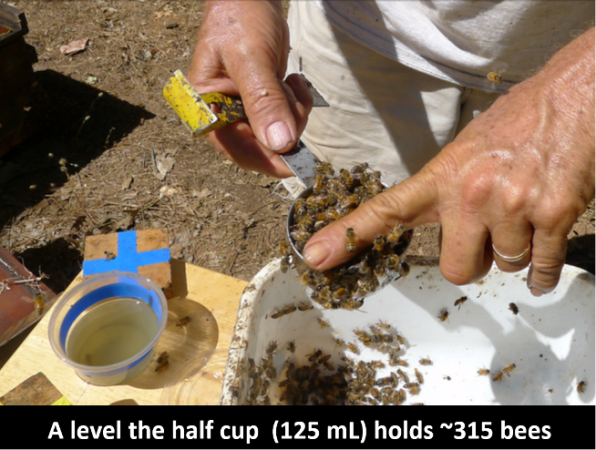
Tilt the tub, tap it on the table, and scoop the cup up under the bees, thus not causing any bees to release alarm pheromone. If there is a nectar shake on, it makes the bees stick together, so I shake the combs more gently, and wash the tub and cup with water every few hives.
For consistency in number of bees in each sample, the cup of bees should be leveled. This can often be accomplished with a quick sideways shake of the cup. Otherwise, I immediately level the cup of bees with my finger. I’ve done this thousands of times, and have yet to be stung on the finger a single time!
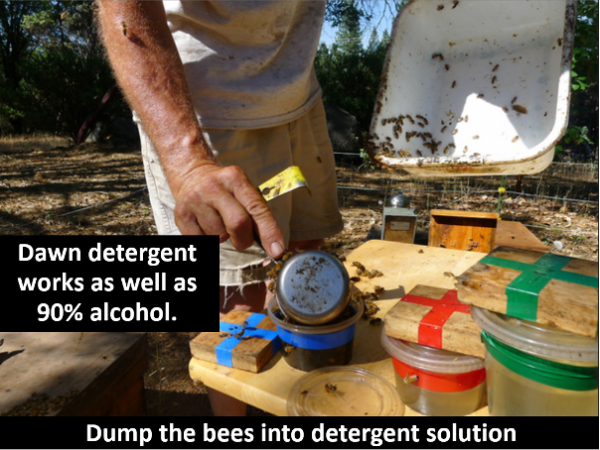
Immediately dump the bees into the detergent solution or alcohol, then press down with the bottom of the cup to prevent any bees from flying away. I snap the lid onto the cup, and pick up the marker with the matching color to place on top of the hive when I return the remaining bees. Either I or my helper(s) then take the cups to the wash station and back. I immediately move on to the next hive—there’s no dead time. Four colored cups are all that we need in rotation, since the time involved in taking the bee sample just about perfectly matches the time at the wash table.
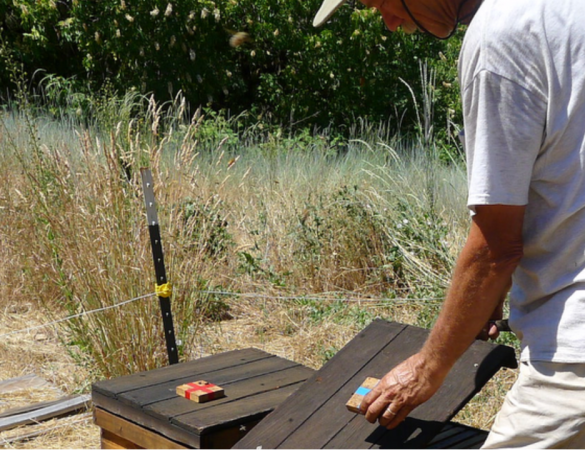
Immediately place the colored marker matching the cup on top of the hive from which you took the bee sample! Before taking the bee sample, I take the lid off the cup and place the marker on top of it. This prevents the wind from blowing away the lid, and forces you to pick up the marker to put the lid on. At this point I knock the remaining bees in the tub out with a quick bang against the front of the hive .
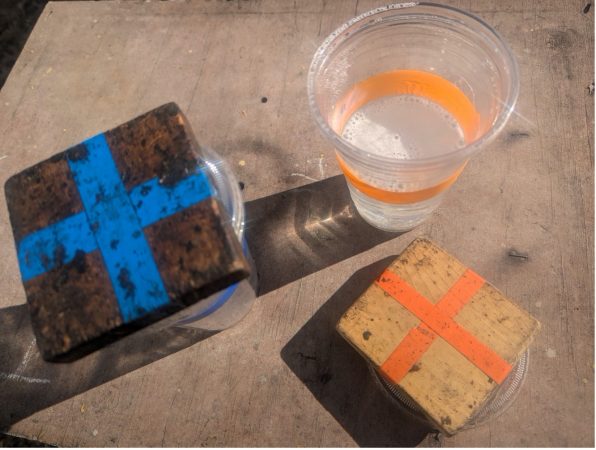
Marker sitting on top of the lid.
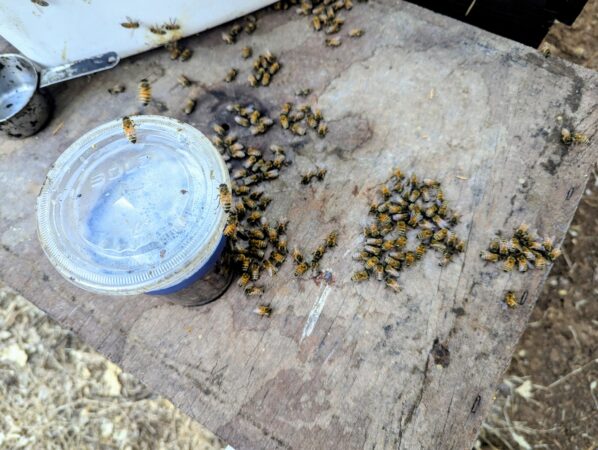
On hot days, don’t allow any young bees to remain on the hive cover, since they will quickly die from the heat. To my surprise, after I snapped this phot, we spotted the queen in the clump of bees to the right!
Agitation of the Sample to Precipitate the Mites
If using 91% alcohol, the mites release immediately. If using detergent, allow the cup to sit for at least 60 seconds before beginning agitation.
There is no need to shake the cup! All you want to do is a gentle swirl to allow gravity to pull the mites down through the moving bee bodies:
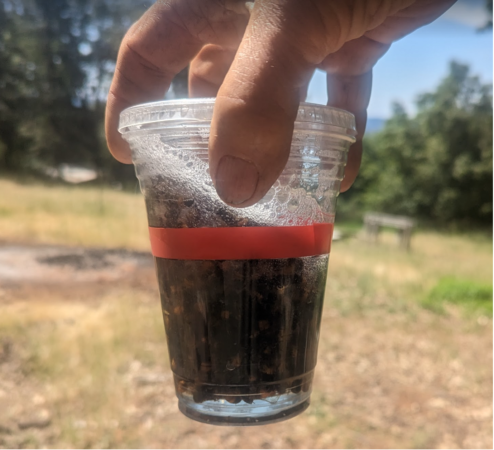
All that’s needed is a gentle circular swirl, so that the bees at the bottom are slowly tumbling.
And here’s where the game changer enters – using battery-powered mechanical agitators:
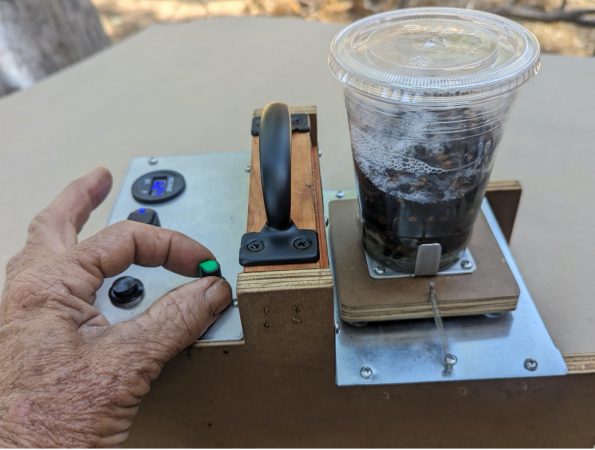
My helper Jacob McBride is producing these agitators for sale (forbeessake@gmail.com).
Most of the mites will be at the bottom of the cup after 15 seconds of agitation, and 95% by 30 seconds (close to 100% by 60 seconds). At that point, lift out the inner cup containing the bees, and count the mites.
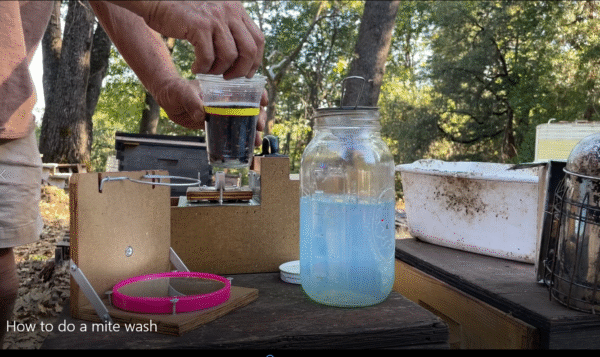
I’ve filmed a brief video of me performing a wash here.
Counting the Mites
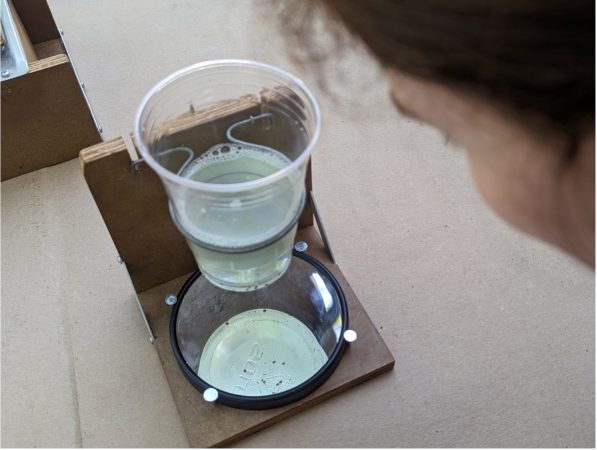
Hold the cup 4” above a 10x magnifying mirror to count the mites.
At the wash station, the washperson records the first letter of the cup color along with the mite count.
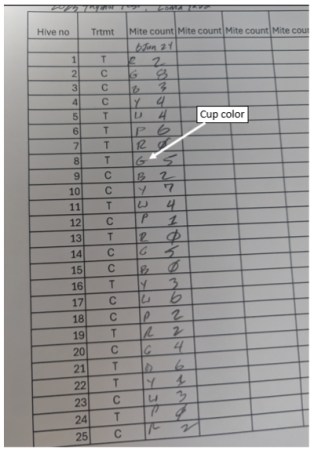
They can then holler out to the sample taker, “Red is a count of 4.” The sample taker then repeats that sentence back, and writes the date and count on the hive, as they pick up the marker.
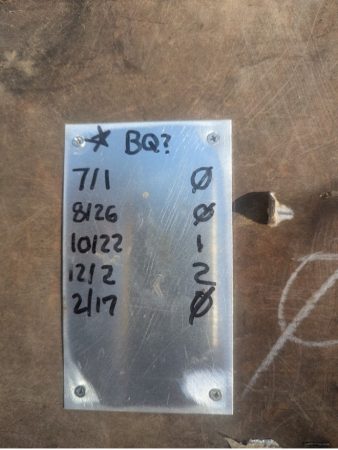
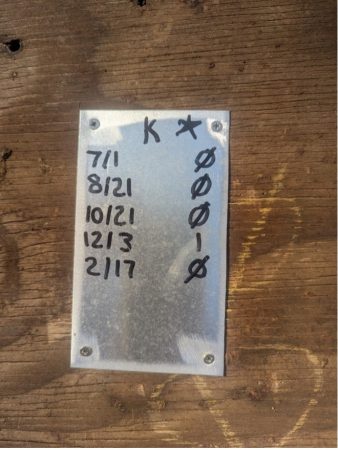
Tags on our “potential breeder” colonies. The best recording system that we’ve found is 3” x 5” aluminum tags screwed to the hive covers. The only felt pen that lasts is the Marks-a-Lot Ultra. We put a star on colonies that are top performers as far as colony strength and honey production.
Alternatively, you can stick an index card partially under the migratory cover, making sure that it’s stuck in the propolis:
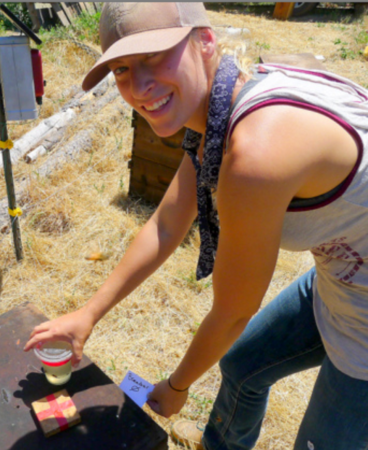
Either the washperson or a sampler returns refilled cups to the field, placing them with their markers on top onto the next hives to be sampled:
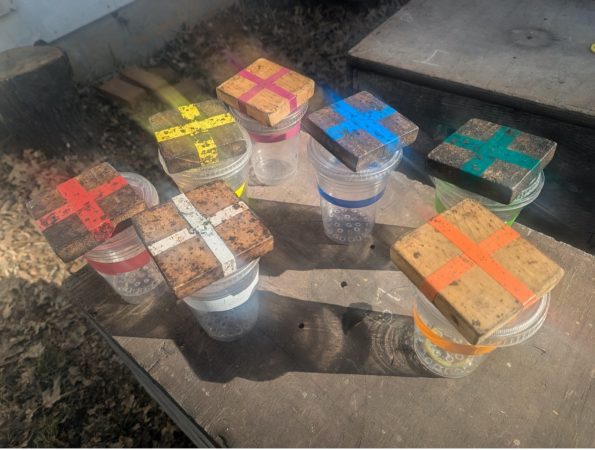
Practical application: by the time we’re done, each hive can be labeled as to mite count and whether it is a potential breeder to test again, whether it is queenless, sick or weak and needs to be taken care of, needs a super, etc. The yard crew then follows us the next day, now knowing in advance what needs to be done, and takes care of everything very quickly. Thus, we’re using the most experienced member of the crew to do a quick evaluation of the status of every hive at this critical juncture. Our savings in mite treatments, labor, and fewer lost hives more than pay for the cost of the sampling, and as a bonus we are now engaged in a realistically serious breeding program for varroa-resistant bees.
The Impossible Becomes Possible
Until we got this method down, I would have considered finding time to do 1000 mite washes to be impossible. But now we think nothing of performing 300 or more washes in an afternoon.
Notes and Citations
[1] Eynard, S, et al. (2024) Sequence-based genome-wide association studies reveal the polygenic architecture of Varroa destructor resistance in Western honey bees Apis mellifera. bioRxiv 2024-02.
[2] Guichard, M, et al. (2020) Advances and perspectives in selecting resistance traits against the parasitic mite Varroa destructor in honey bees. Genetics Selection Evolution 52: 1-22.
[3] Guichard, M, et al. (2023) Prospects, challenges and perspectives in harnessing natural selection to solve the ‘varroa problem’ of honey bees. Evolutionary Applications 16(3): 593-608.
[4] Sprau, L, et al. (2024) The selection traits of mite non-reproduction (MNR) and Varroa sensitive hygiene (VSH) show high variance in subsequent generations and require intensive time investment to evaluate. Apidologie 55(5): 68.
[5] Harbo, J & J Harris (1999) Selecting honey bees for resistance to Varroa jacobsoni. Apidology 30 (2-3): 183-196.
[6] I use colored vinyl tape. We tried numbering and lettering, but found that colors were far less confusing. We also tried more than 4 colors, but found that 4 colored cups was all that was necessary for 2-4 crew members. We can get it down to a minute a sample with 4 people.
[7] The curve of the Rubbermaid tub exactly matches that of the stainless steel measuring cup—every little detail counts for efficiency! We carry two tubs, nested. One holds all the wash cups, and slips into the clean one for taking samples below. The tubs fit crosswise into a deep super for transport (as does the mite washer). Tips: if you’re using alcohol, do not stack the wash cups after use—they will stick tightly together (not an issue with detergent). If you stack two wash tubs, put the measuring cup in the lower one to keep the tubs from sticking together.
[8] QUESTIONS ON SAMPLING HIVES FOR VARROA
https://scientificbeekeeping.com/re-evaluating-varroa-monitoring-part-2/
[9] HOW DOES MITE DISTRIBUTION VARY FRAME-TO-FRAME IN A HIVE?
https://scientificbeekeeping.com/re-evaluating-varroa-monitoring-part-3/
[10] https://scientificbeekeeping.com/drones-and-varroa-part-1/
[11] I can walk and chew gum at the same time, but have not yet mastered walking, chewing gum, and looking for the queen simultaneously.
Contents
An Unsuccessful Attempt to Create Robbing
Field Observations of the Guards Behind Robbing Screens
How Colonies Guard Themselves against Foreign Bees
The Behavior of Guard Bees
My Conclusions
Next Month
Acknowledgements
Citations and Notes
Robbing Screens Part 8:
Do They Work in Concert with the Guard Bees?
Randy Oliver
ScientificBeekeeping.com
First Published in ABJ February 2025
When we monitor the upper openings of the robbing screens that we’ve tested, we can’t help but notice that there are seldom any guard bees manning those portals to check the IDs of bees attempting to gain entry!
I can’t believe that I’m eight articles into this series! Allow me to begin with an admission: until researching this subject, I’d never used a robbing screen. I began this research solely to answer a question posed to me: Are robbing screens effective at reducing mite immigration? The answer appears to be “no,” but as is common in scientific research, one question leads to another, and that to yet another, and perhaps to discoveries that you never dreamed of.
AN UNSUCCESSFUL ATTEMPT TO CREATE ROBBING
By this time in our experimentation with robbing screens, it was autumn of our second year, and robbing pressure in our home yard was strong. It occurred to me that this was our chance to test whether robbing screens could actually prevent the robbing of weak colonies from occurring. So we ran a small preliminary experiment.
We had a couple of rows of late-season nucs available in my home yard, so we transferred 10 of them (at their original locations) into the centers of single deeps (equalizing them to 4-5 combs of bees), adding drawn comb and capped honey to either side to fill all ten frame positions (thus creating 10 weak colonies having a limited number of bees to guard their desirable honey). We randomly installed three types of robbing screens (2 of each type, plus 4 unscreened Controls), and gave the colonies a few days to get used to their new boxes and robbing screens (Figure 1). During that time, we open fed anise-scented sugar syrup a few times a day between the rows of the test hives. At each feeding, the syrup trays were mobbed by foragers (presumably from another 50 hives sitting nearby), and investigating bees were attracted to the alluring scent of anise anywhere property.
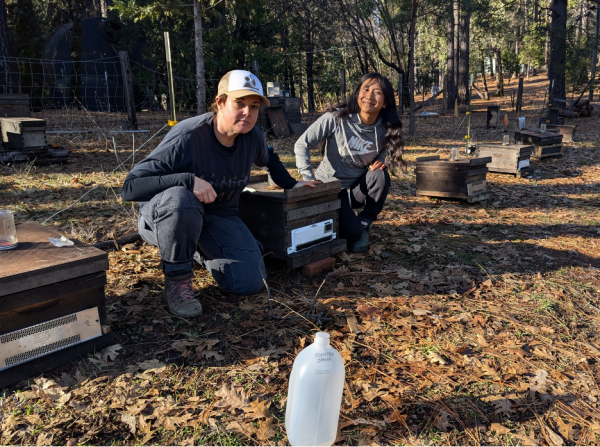 Fig.1 Our attempt to test whether robbing screens could prevent weak colonies from being robbed out. Corrine and Rose helped me monitor the action at the hive entrances. In the foreground is jug of the scented syrup that we used to stimulate robbing pressure.
Fig.1 Our attempt to test whether robbing screens could prevent weak colonies from being robbed out. Corrine and Rose helped me monitor the action at the hive entrances. In the foreground is jug of the scented syrup that we used to stimulate robbing pressure.
Once the intentionally-weak test hives were settled down, we let the open feeders go dry each day, and increased the robbing pressure on the test hives by providing them with scented sugar syrup via their top feeding holes (sometimes just squirting it in), so that they would be exhausting the odor of the bait syrup out their entrances. This immediately created strong robbing pressure, and we could easily observe defensive behavior and fighting at the Control hive entrances, but not at the screened hives (although some had dead bees on the ground in front of them.
RESULTS: To our great disappointment, not a single hive got overwhelmed by robbers — whether they had a robbing screen on or not. We repeated the feeding and baiting of the test hives for a couple of weeks, but despite their small clusters and fragrant goods inside, danged if we could induce the robbing out of a single one. 🙁
Although I’m quite familiar with watching the high-mite colonies that I bring home for experimental purposes get robbed out in their final stages of collapse, the above result was consistent with what I’ve observed over the years. In my location, it generally takes only a handful of guard bees to prevent robbers from gaining access to even a weak hive containing capped honey (as opposed to those containing open nectar).
A previous observation: It occurred to me that last year I had tried again and again to take an illustrative photo of bees guarding the upper opening of the stainless steel robbing screens that was testing at the time. But I was never able to catch a guard doing so! So I decided to start focusing my attention upon the guard bees.
FIELD OBSERVATIONS OF THE GUARDS BEHIND ROBBING SCREENS
Our previous research showed that when we fitted scent-baited empty hives with robbing screens, some potential robbers eventually found their way in. So why did those weak test hives not get robbed out? We could clearly observe the action of the guard bees at the entrances of the unscreened Control hives, but was that also occurring at the openings of the robbing screens?
So day after day, and in different locations and hives, we closely watched (and filmed) the behavior of the bees at the openings of the different types of robbing screens, as well as at the entrances of Control hives next door.
RESULTS: Contrary to the obvious guarding behavior at the entrances of unprotected Control hives, what my helpers and I observed at the top openings of the three types of robbing screens, is that only occasionally was there any guarding behavior evident at those top openings, or even monitoring of incoming bees by any guards! (Figure 2).
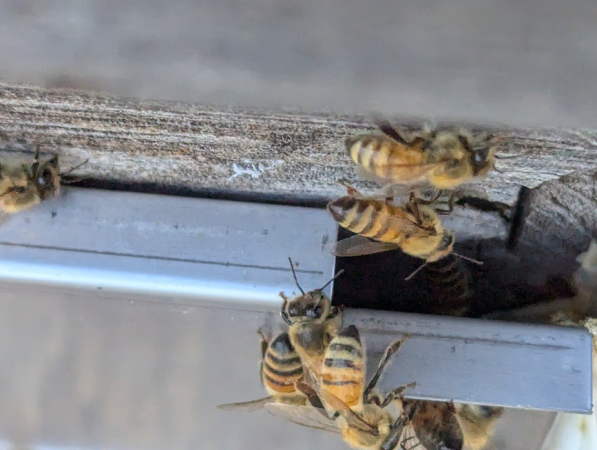
Fig. 2 Note the lack of outward-facing guard bees at this upper opening. Although most of a colony’s foragers eventually learn to use the top openings, it was rare for us to see the faces of any guards facing outward, or any head turning or other response to our waving fingers or a swinging dead bee lure. This strongly suggested that guard bees do not recognize the top opening of a robbing screen as the entrance to their nest cavity.
The lack of guarding behavior at the openings of the robbing screens really surprised us. To further investigate, I cut plastic and stainless steel guards to place black window screen in front of both the top opening and the lower hive entrance, so that we could observe whether incoming bees (either returning foragers or investigating “thieves”) were ever checked by guards (Figure 3).
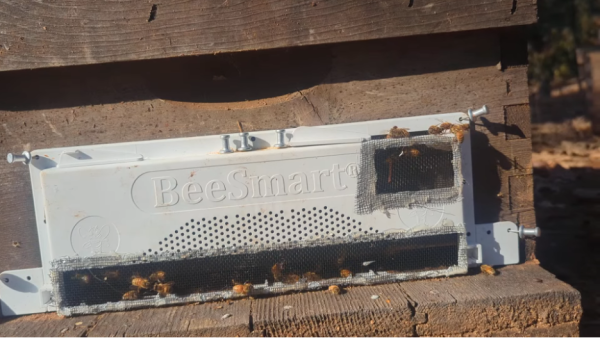
Fig. 3 When I put viewing screens in front of the top openings, we’d only occasionally observe a guard — but even they were generally outside the screens. Only rarely did we observe a guard intercepting any incoming foreign bee inside the top opening. We laid on our bellies day after day when there was plenty of robbing pressure, and watched bee after bee enter the top opening and then just walk down to the lower entrance without ever being checked by a guard.
Practical application: I suspect that the lack of guards at the top openings may be due to the guards not recognizing that remote-from-the-cluster opening (with light coming in between it and the actual nest cavity entrance) as the place to take up their defensive position.I may be making a dumb assumption, but it seems to me that a robbing screen might be even more effective if it were designed to work in conjunction with the colony’s guard bees, and encourage them to set up an inspection station at the robbing screen’s opening. So I dug into the literature to see what I could learn about the behavior of guard bees, and especially what cues trigger them to “activate” and challenge an incoming foreign bee.
HOW COLONIES GUARD THEMSELVES AGAINST FOREIGN BEES
There are any number of critters that would love to gorge on the energy-rich honey stored in a hive, so honey bees have evolved effective defenses against them. A few large predators, such as honey badgers, bears, and humans, require that a colony stores its goods in a strong physical fortress, preferably high above the ground. But most smaller predators or thieves are deterred by the bees’ painful sting. Others, such as ants, are identified by smell, and bitten.
But anywhere that colony density is high, the bees must also protect their honey from theft by foragers from other hives, especially when floral nectar sources dwindle. Hungry foragers will then investigate any scent that they might associate with a sugary reward — especially that of ripening nectar or inadequately guarded honey.
Practical application: A colony’s innate and most effective defense against such potential nectar thieves are its guard bees! So a robbing screen would likely perform best if it was designed to work in concert with the guard bees.
THE BEHAVIOR OF GUARD BEES
In the typical progression of “jobs” that a worker bee performs over the course of its life (“temporal polyethism”), some may act as guards for a day or so (just prior to transitioning to foraging). Bees acting as guards are kinda like “seasonal temps” — a temporary standby force that is only activated if needed (the key word being “activated,” Figure 4).
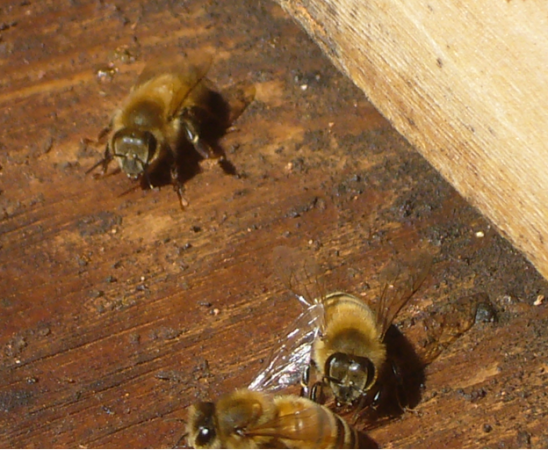
Fig. 4 Activated guard bees assume a typical stance with their front legs raised, and their wings lifted for quick take-off, following any moving object with their heads. The also challenge, “sniff,” and tug at any bee that doesn’t seem “right” to them.
As most beekeepers notice, when a colony is relatively “undisturbed” and there is a nectar flow on, few workers are inclined to act as guards, and even those guards may not be “activated” to any extent.
Practical application: Any beekeeper who doesn’t wear gloves has learned to move smoothly, so as not to “activate” the guards. Any jerky motions of your hands will initiate “warning bumps” from guards flying out to determine whether you are a potential predator, or merely a tree branch waving in the wind.
Younger workers live in darkness and avoid light (being negatively phototactic), and don’t use their sense of sight (if you pull out a comb, the young bees don’t even look at you). The only bees that look at you are those acting as guards that day. Guard bees are extremely observant of anything that moves, being on the lookout for a potential predator or thief.
A guard bee at a hive’s entrance must differentiate a potential thief from the thousands of returning foragers (kinda like an FBI agent trying to pick out a terrorist in an airport lobby). The first cue to alert them is visual notice of unusual movement, which they may then follow with an “identity check and patdown” (sniffing the bee in question for colony scent, and checking to see whether it tries to get away).
Curious foragers from another hive (aka “honey thieves”) exhibit a typical “investigatory” approach to a hive’s entrance while “sniffing” for the source of the attractive scent. Instead of plunging straight into the entrance as do foragers returning home, they wave back and forth a few inches in front of the hive (inspecting for danger, and locating where the odor is coming from). This investigative flight pattern is recognized by the guards and puts them on alert. When an investigating scout tentatively lands, it is generally immediately challenged by one or more guards, and unlike a confused drifted bee, may try to escape.
Butler and Free published a fascinating paper in 1952 titled The behaviour of worker honeybees at the hive entrance [ ]. They describe how colonies generally allow drifted foreign bees who fly “straight in” to peacefully enter the hive — that is, until a number have done so, at which point the guard bees become activated by the scent of “too many” intruders. The authors found that:
Excited guard bees watch the movements of bees flying overhead and approaching the hive, often jerking round to do so, and make intentional movements to intercept any bee which they see alight near them. Each guard tends to patrol a particular, circumscribed, area of the alighting-board, sometimes for an hour or more, then to disappear either within the hive or for a flight only to reappear on guard once more at the same part of the alighting-board [Figure x]. Guard bees intercept and examine members of their own colonies as well as intruders from other colonies, and the guard bees themselves are often in turn approached and examined by other guards of their own colony.
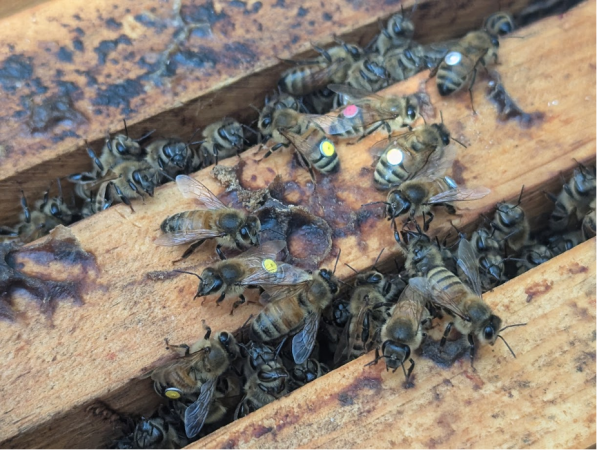
Fig. 5 We also observe guards returning to their exact same station after flight. After gluing steel discs on the backs of guard bees (identified by them facing us with interest) on the top bars, then releasing them to fly back to the hive, a large proportion of them then returned to resume guard duty on the very same top bars that they’d been plucked from several minutes earlier.
Butler and Free continue (boldface mine): It was concluded from the results of these experiments, that provided that a colony of bees has not been disturbed (and its members thus “alerted”), few, if any, guard bees will be present, and foragers from another colony can enter the hive without difficulty or even examination. If, however, the members of the same colony have been “alerted,” some of them commence to guard the entrance, and foragers from another colony are, under these circumstances, liable to be intercepted and examined, although they still enter the hive without hesitation or difficulty.
It is clear from these data that the bobbing motion of a dead-bee lure at the hive entrance was sufficient to alert the experimental colonies, and that guard bees remained in evidence for periods varying from 12-65 minutes, with a mean time of 28.5 minutes.
Again, we’ve confirmed the above, also by using a hanging dead-bee lure for further investigation on many hives in different locales, with or without robbing screens (Figure 6).
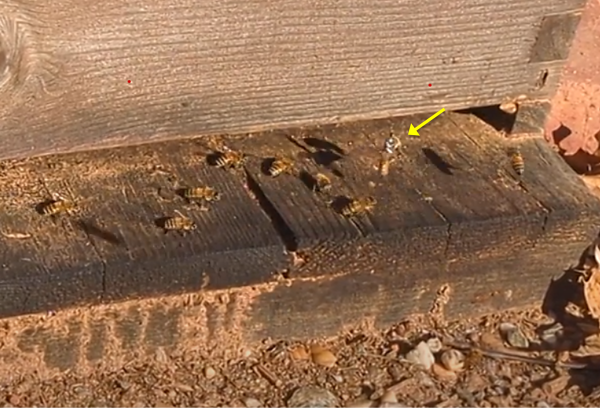
Fig. 6 We swung a suspended dead bee on a fish hook in front of hive entrances to gauge the response of the guards. This is a freeze frame from a video — note how the guard bees have turned to follow the left-to-right motion of the swinging bee indicated by the yellow arrow (the fine leader string doesn’t show ). Activated foragers will often fly out to intercept and attempt to sting the bee lure.
A drifted bee normally walks right into the foreign hive, but if stopped by guards, often offers nectar — which is generally refused. After such refusal the drifted bee my engage in “tongue stropping,” an usual behavior that my placate the guards. But if the guards continue to tug at the legs of the drifted bee, it goes entirely passive and submissive (akin to “playing possum,” aka thanatosis). On the other hand (again from Butler and Free):
When the guards succeeded in seizing a robber the latter invariably tried to break away from them. Occasionally an excited guard was seen to seize a member of her own colony in which case the latter adopted a submissive attitude and was soon released. If a guard bee succeeded in getting a firm hold of a robber she curled the tip of her abdomen towards the robber without any hesitation and attempted to sting her. When this happened the robber and guard bee frequently lay on their sides, holding onto one another’s legs with their mandibles, and, in mutual attempts to sting each other, buzzed round and round extremely fast like a catherine-wheel. Usually in such cases one of the bees succeeded in stinging the other and, on being released, the stung bee crawled away slowly, obviously seriously hurt, and died within 2-3 minutes or less. Sometimes, however, the vanquished bee had such a tight grip on the leg of the victor that the latter had great difficulty in breaking away from the dying bee or even, in some cases, from the corpse. In every one of the many fights that were seen to result in the death of a bee the victorious bee succeeded in withdrawing her sting from the body of her victim extremely quickly.
The steps of action involved in guarding are also described by Napier [ ]:
The mildest defensive behavior is antennation, in which guard bees rub their antennae on returning foragers and use scent cues to determine if the foragers are nestmates or non-nestmate intruders. The next behavior is antennation with open mandibles, a threat behavior. The next behavior is biting, where guards bite the legs, antennae, or abdomen of forager bees. Abdomen flexion is the next most severe behavior, where a guard grabs the forager and flexes her abdomen without extruding her stinger. Stinging is the most severe of the guard behaviors, in which the stinger is extruded in an attempt puncture the cuticle of the other bee. See Figure 7.

Fig. 7 Guards actively antennating and biting an intruder. One guard is flexing its abdomen in preparation for stinging (note the shininess of the bee being attacked, suggesting that it’s been previously engaged in robbing).
MY CONCLUSIONS
For best functionality, an anti-robbing device would:
(1) Have a small entrance opening where guard bees will be induced to set up a security checkpoint,
(2) That opening placed so that the guards will be visually activated by the flight pattern of investigating potential thieves,
(3) It would be of benefit if the entrance opening location minimized the confusion of returning foragers,
(4) Lastly, its screen would be placed above that entrance to allow the attractive exhaust air to rise and exit there, thus diverting investigating thieves away from the guarded entrance below.
NEXT MONTH
We’ll review the history of robbing screens, and attempt to design an “improved” one that meets the above qualifications, and then test it in the field for performance.
ACKNOWLEDGEMENTS
I thank my helpers Rose Pasetes, Corrine Jones, and Jacob McBride for their many hours of diligent and often tedious field and lab work. And to all you donors who help pay for the cost of our research!
CITATIONS AND NOTES

Robbing Screens Part 9:
Designing a Robbing Screen that Works in
Conjunction with the Colony’s Guard Bees
Randy Oliver
ScientificBeekeeping.com
First Published in ABJ March 2025
The defenders of a colony against robbing are its resident guard force. Do the current designs of robbing screens help or hinder those guard bees?
Robbing Starts with an Attractive Scent
“Robber bees” don’t go looking for trouble — they are merely foragers attracted to a scent that they associate with a sugary reward, especially the scents of nectar. A hive ripening nectar into honey strongly emits those scents, and each variety of honey emits volatile floral compounds that may attract the interest of foragers (Table 1).
| Table 1. Some volatile organic compounds in honey, and human perceptions of their aromas. After Manyi-Loh (2001) [[1]]. |
| Volatile Compound |
Human Aromatic Description |
| Nonanal |
Aldehyde, citrus, fatty, floral, green, piney |
| Nonanol |
Green, sweet, oily |
| Decanal |
Soap, orange peel, tallow |
| Octanal |
Fat, soap, lemon, green |
| Linalool |
Sweet, citrus, forest, geranium |
| Benzaldehyde |
Sweet, almond, marzipan |
| Dimethyl sulphide |
Sweet, honey, acrid, cooked vegetables, sulphuric |
| Furfural |
Sweet, fruit, cherry, soft almond |
| Sinensal |
Sweet, orange |
| β-damascenone |
Fruity, sweet, honey |
| Phenylacetaldehyde |
Sweet, honey-like |
| Isophorone and cetoisophorone |
Spicy |
| Benzene and phenolic acids |
Ripe fruit and spicy |
| Hexanol and hotrienol |
Balsamic and aromatic herb |
| 3-caren-2-ol and spathulenol |
Cheese and hay |
| Lactones |
Woody, toasty, caramel |
The concept behind robbing screens is to misdirect foragers attracted to a scent away from the hive entrance, making it more difficult for them to find their way into the hive. Our findings indicate that the designs that we tested indeed do so, but it was clearly evident that enough foragers can still figure out how to get in that robbing screens alone were not enough to prevent robbing — it was still up to the guard bees to keep any “potential thieves” that located the device’s opening from gaining entry to the hive itself.
History of the Robbing Screen
So let’s take a look at the original “robbing screen” invented by Dr. Harry Laidlaw (Figure 1).


Fig. 1 Two photos of Dr. Laidlaw’s original robbing screens (the first from [[2]] and the second from [[3]]). Note how he left a part of the lower entrance open (rather than having a substitute entryway at the top). And in the design on the left, he had a vertical metal barrier to separate bees attracted to the screen away from the entrance.
Having the entryway at the bottom allows the less-dense exhaust air to rise through the screen, thus diverting investigating potential robbers (guided by scent) away from the bottom entrance (refer to my smoke tests earlier in this series [[4]]). So I built a copy of Laidlaw’s screen to test (Figure 2).

Fig. 2 For testing, I built a copy of Laidlaw’s original design, with a metal barrier between the screen and the small entrance to the side.
Of course we now needed to test it in the field against the other designs (Figure 3).
 Fig. 3 I built some more top-viewing windows, so that we could compare all the designs side-by-side, moving the boxes to different locations for each run, and randomizing their placement.
Fig. 3 I built some more top-viewing windows, so that we could compare all the designs side-by-side, moving the boxes to different locations for each run, and randomizing their placement.
The Laidlaw screen performed well, but some investigators still found their way in (Figure 4).

Fig. 4 All four types of robbing screens greatly reduced the rate of investigating bee entry, with the Mesh performing best, and the Laidlaw design on par with the rest. Raw data in Table 1.

Table 2. Raw data for the experiment. The screen types are described at [[5]].
Although the robbing screens clearly made it difficult for potential thieves to locate their entryways, some invariably still got in! And that’s why it’s necessary to have a security checkpoint of guard bees to prevent those that do locate the entrance from entering.
Practical application: A robbing screen can make it more difficult for a potential thief to find its way to the hive entrance, but it’s up to the colony’s activated guard force at the nest cavity entrance to prevent robbing from progressing.
Establishing a Security Checkpoint at the Nest Entryway
A point brought to my attention by Milan Jovanovic (one of the editors of Serbian Beekeeper Magazine) [[6]], was that the wide entrances and landing boards of Langstroth hives make it more difficult for the guard bees to intercept and defend the nest entrance against incoming thieves. He’s not the only one — to minimize robbing or wasp predation, many beekeepers simply restrict the entrance opening to make it easier for the guard bees to defend it. Ernie Daley, in an article in this Journal[[7]], noted that using an inner cover as a bottom board created a small, central lower entrance that benefitted his colonies. So I was surprised that Laidlaw, although providing a reduced entrance, placed it to the side of the hive, which would be away from the cluster of a weak colony.
Practical application: It’s likely best for a robbing screen to not only have a restricted entryway, but for that entrance to be as close to the colony’s cluster as possible.
A second design consideration for a robbing screen is suggested by a key conclusion by Butler and Free [[8]]: “that guard bees recognize robber bees by their characteristic flight and behaviour rather than by their body odours”.
We filmed foragers trained to anise scent exhibiting such back-and-forth flight as they investigated empty hive bodies exhausting that scent from their entrances [[9]].
Free’s later observations [[10]] are informative as to the optimal design for a robbing screen (I boldfaced his most germane finding):
[Our] observations strongly suggest that the identity of robbers is normally established by their behaviour, and then confirmed by their ‘foreign’ odour. This same mechanism acts as a safeguard to members of the guards’ own colony which approach the hive in a hesitant manner, although under what are probably exceptional conditions some of them may be killed by the guards. The practice among beekeepers of reducing the size of the entrance to a hive during the robbing season therefore not only leaves a smaller area for the guards of the colony to defend, but also causes congestion at the entrance and accentuates the innate hesitant flight of robber bees, which are not as well orientated to the entrance as the bees of the colony and so facilitates their recognition.
Practical application: Butler and Free’s observations suggest that for a robbing screen to be effective, it should promote some congestion, as well as allow the guard bees to visually monitor for the swaying investigatory flight pattern of investigating potential thieves.
As I pointed out in my article last month, we’ve observed that guard bees tend not to take up positions at the remote entryways of the robbing guards that we’ve tested. I suspect that the reason is that the guards take up station where light enters the nest cavity — not at a remote opening.
Activation of the Guards
Colonies tend to adjust their number of guard bees at the entrance dependent upon nectar availability, since robbing pressure becomes more intense during dearths. When there’s a strong nectar flow on, guards (if there are any) accept any and all incomers, but during a dearth they reject most non-nestmates. However, in an apiary of closely spaced hives, there is often considerable drifting of confused bees between the colonies. This influx of bees with foreign odors may accustom the guard bees to the odors of non-threatening “intruders.”
As found by Dr. Free, guard bees tend to allow drifted bees from other hives to freely enter, and they are not concerned about the occasional “thief” who sneaks in to nab a bit of stored nectar. Dr. Free ingeniously experimented with training foragers to feeders within empty hives, then adding combs of bees from a different hive, or the parent hive, to the empty hive, and observing the changes in behaviors of the foragers and the guard bees (which were sometimes sisters of the foragers):
In the above experiments it has been found that bees which foraged for sugar syrup or honey at a hive other than their own did not assume the typical swaying flight of robber bees at the entrance to it, even when it contained an enclosed colony of bees having the same or different odour as themselves. The foragers adopted this behaviour when there was a congestion of bees at the hive entrance.
Free’s observation of the deterrent effect of congestion at the hive entrance is something to keep in mind (Figure 5).

Fig. 5 There are reasons that colonies, even in warm regions, prefer nest cavities with small openings — the bee activity there is intimidating to investigating foragers (who aren’t looking for trouble), and easier for the guards to monitor and defend. Photograph by JarrahTree at wikimedia.org.
Working as a security guard can be boring, until something activates them into taking action. As pointed out by Free, guard bees don’t do much until they are “activated.” Certain cues alert them that their colony is being threatened, and trigger them to “wake up and take action.“ The main cues (other than a predator or beekeeper scraping or jolting the hive) are:
- An excessive amount of the odor of foreign bees entering the hive (sense of smell).
- Swaying or jerky movements in front of the entrance (sense of sight).
Practical application: It is this last cue that may be most important to activate the guards against potential “robbers,” and where the designs of the screens that we tested fail. It was very simple for us to test for the presence of guards by simply looking down into the substitute entryways, or by seeing if there was any response to a bee lure waved by us above it — very seldom did we observe any response from an activated guard!
By this point in time, I had some ideas about improving the design of robbing screens, based upon the physics of air flow and the biology of bee behavior (rather than mere assumptions). This involved addressing four issues:
- Investigatory potential honey thieves cue to the attractive floral scents exiting a hive. Those scent plumes rise by convention, and thus guide investigating thieves right to an upper entrance. Mesh screens work better than perforated plates.
- The device should be field tested on scent-baited empty hives to confirm its effectiveness at frustrating and deterring potential “honey thieves” from finding their way in.
- Ideally, the gateway should be placed so as to minimize confusion of the colony’s own returning foragers or workers returning from their first flight.
- The gateway should be designed and located to work in conjunction with the colony’s guard bees. Perhaps there should be a single small entrance (easier to defend, and encouraging a little thief-deterring congestion), placed centrally (nearest to the broodnest), and blocking light from above (to help that day’s guard bees to recognize it as the entrance to the nest cavity and take up their defensive positions there).
Since I love to invent and build things in the shop, I modified Laidlaw’s design slightly (Figure 6).

Fig. 6 To try out the New design, Rose and I fabricated a batch for testing. We placed a restricted “guard station” entryway in the center, blocking any light coming through the screen above, and incorporated Laidlaw’s metal barriers.
Testing the “New” Design
Issue # 1. Moving the entrance away from the attractive scent
We had noticed again and again that returning foragers and investigating “potential thieves” tended to orient to the upper portion of the robbing screens, and used the scent emanating from the upper substitute entrance to find their way in. So we ran smoke tests on the New design (Figure 7).

Fig. 7 There were gentle shifting breezes when we ran the smoke tests. The smoke was slightly more buoyant than the ambient air (similar as how colony exhaust air will also be less dense), so it slowly rose up into the screened area (where the scent of nectar would attract investigating foragers).
Unlike as with the guards with upper openings that we previously tested, we rarely observed smoke exiting the low entryway, even as the smoke shifted from side to side with the breezes. But would it work the same with bees seeking the scent of honey? Take a look at Figure 8.

Fig. 8 Despite there being an open entryway at the bottom, bees orienting to the scent hovered above and in front of the screen. We were surprised, however, how much more quickly the returning foragers figured out how to “get in.”
Issue # 2. Testing efficiency at diverting and frustrating investigating foragers
We again ran comparative tests to count how many potential thieves entered empty scented-syrup baited hives, using matched pairs — one unscreened Control, and the other with the New design (Table 3).

Table 3. Twelve times as many scent-trained foragers seeking the odor of anise entered the control hives compared to those entering hives fitted with the New design of robbing screen, suggesting that this design appears to be reasonably effective at preventing “robbers” from locating the entrance.
Issue # 3. Minimizing confusion at the entrance
When a robbing screen is first placed on a hive, the returning foragers have a hard time trying to figure out how to get in (Figure 9).


Fig. 9 With the robbing screens that we tested, there was often a pileup of confused and frustrated returning foragers (sometimes lasting for several days). A substantial proportion of those bees may “just give up” and drift to nearby hives.
We didn’t see as much traffic congestion with the New design (Figure 10).

Fig. 10 Unlike as with the first three designs we tested, which confused their foragers for many days, foragers adapted very quickly to this design (flight often looked close to normal within an hour). Note how bees seeking the hive scent go to the top of the screen, whereas returning foragers fly right into the entrance. Regarding the bees inside the screen, with time the traffic pattern stabilizes, and we see far fewer.
Since the foragers adapted so quickly to using the low-central entryway position, we hoped that there would be less drifting of first-time flyers, but we were apparently wrong (Figure 11).

Fig. 11 When we tagged 100 guard bees on the top bars, to our great surprise (I keep repeating that phrase), we recovered 20 tags over the next two days on the magnetic traps (shown below, after removal of the discs for counting) that we placed on two adjacent hives (10 discs in the first few hours after tagging the bees!).
Oh well, I guess no design is perfect, and the weather turned cold, so we unfortunately couldn’t repeat the test.
Issue #4. Setting up a “security checkpoint” of guard bees scanning for potential thieves
Here’s where the New design really shone. In our initial tests with heavy robbing pressure in November, with weak hives containing only four combs of bees, we observed that guard bees quickly set up security checkpoints at the entryways of the New design (Figure 12).

Fig. 12 With the small entryway near the center of the hive, guard bees made it clear that they weren’t going to let any robbers in.
Encouraged by these results, but with the weather getting too cold for further testing, I phoned my beekeeper friend Rob Stone in sunny Southern California, and asked how strong the robbing pressure was from the feral Africanized bees surrounding his apiaries. He said “intense.” So I shipped him down a few robbing screens of each design and asked him to install them on his hives. A few days later I flew down to observe and film them (Figure 13).

Fig. 13 Rob watching the entrance to one of the New robbing screens.
We’ve now closely watched the guard activity at dozens of entrances, including swinging a dead-bee lure in front of them (you can watch some video at [[11]]). Unless the guards have already been activated by robbing pressure or hive jolting, there is little or no response. But when a colony’s been exposed to robbing pressure, at least one guard will immediately rush out and follow the lure’s movements. Its motion appears to immediately activate additional guards, who quickly rush to its side, looking in all directions, and help to attack the lure (often flying out to intercept it; Figure 14).

Fig. 14 You can barely make out the fishing leader and hook holding the dead bee lure, which we swung in front of the entrances to simulate a potential nectar thief. Note the guards that immediately attacked it, as well as the activated guards who rushed out the entrance at the ready.
But that’s not all! We noticed another unusual phenomenon (Figure 15).

Fig. 15 Not only did the guard bees protect passage through the entryway, but some activated guards would patrol the outsides of the screens! Uncoordinated individual guards would chase down and drive away any foreign bees that landed on the screen! There are at least three of them doing so in this photo. Watch a video at [[12]].
Conclusions
OK, I’m wrapping up our investigations into robbing screens. We found that it was of benefit for a robbing screen to have:
- A small, centrally-located entryway,
- Placed at the level of the bottom board, and
- Shaded from guard-distracting light.
- With the misdirection screen placed well above the entryway, so that the exhaust air rises well-away from the entryway. The screen should have a large “opening ratio.”
I publish our research and findings for the benefit of beekeepers everywhere — any beekeeper or manufacturer building robbing screens is welcome to use them.
Back to the Drawing Board and Shop
The above said, my assistant Rose wondered whether we could make the New design even more useful to the beekeeper. So back to the drawing board and workshop (Figure 16)!

Fig. 16 We’re currently working on prototypes for a tricked-out model to cover all conditions. Rose is thinking of producing them as a side gig, so she’s going to build a batch for others to try out.
The “Oliver Screen” will be designed for long life, hot-wax dipped, and have four adjustable seasonal settings:
- A screened anti-robbing and wasp setting.
- An unscreened minimal-ventilation restricted-entrance setting for winter (or year-round).
- An unscreened wide-open entrance setting for hot-weather or honey ripening.
- A screened closed-entrance “moving” setting for ventilated transport.
If you’re interested in trying one, send an email to endrobbing@gmail.com to get put on the list (Rose will respect your privacy, and contact you after she’s happy with the design, builds a hundred, and figures out a price).
Citations and Notes
[1] Manyi-Loh, C.E, et al (2011) Volatile compounds in honey: A review on their involvement in aroma, botanical origin determination and potential biomedical activities. International Journal of Molecular Sciences 12(12): 9514-9532.
[2] Laidlaw, H & J Eckert (1962) Queen Rearing. Univ. Calif. Press (p. 98)
[3] Laidlaw, H (1992) Production of queen and package bees, p. 1041 in The Hive and the Honey Bee, Joe Graham, editor. Dadant & Sons.
[4] Robbing Screens Part 5: They don’t just affect robbers. ABJ November 2024
[5] Robbing Screens Part 7: Can they alone prevent robbing? ABJ January 2025
[6] Jovanović, Milan (2005) Troyan Tragedy of Bee Colony. Serbian Beekeeper August 2005: 32-37.
[7] Daley, E (2022) Inner Cover Bottom Floor. ABJ 162(4): 457-459.
[8] Butler, C & J.B. Free (1952) The behaviour of worker honeybees at the hive entrance. Behaviour 262-292.
[9] View at https://www.youtube.com/shorts/eLsXk2AZChg?feature=share
[10] Free JB (1954) The behaviour of robber honeybees. Behaviour 7(2/3): 233-40.
[11] https://youtu.be/vOetLg7IlpU
[12] https://youtube.com/shorts/AtQ0o8k_vnA?feature=share
Honey Cleanup without Robbing
Randy Oliver
ScientificBeekeeping.com
First Published in ABJ September 2023
I’m often asked how to “clean up” the honey in cut-out burr or volunteer combs, spilled honey, sticky extracted combs, or other honey that we’d like to recycle back into hives — without initiating robbing and the potential transfer of pathogens.
THE LAW
I’m well aware that many beekeepers just put combs out to “let the bees clean them up,” but that can initiate robbing throughout an apiary if there is similar-smelling honey in the hives, and more importantly, spread pathogens, notably American foulbrood (AFB) [1].
In order to avoid the transmission of AFB spores via robbing, some (or possibly all) states have laws against setting out combs containing any honey. In California, for example:
Article 12. Sanitation
No person shall extract or render any honey, pollen, or wax from comb except in a building or enclosure which is so constructed as to prevent access by bees.
No person shall possess any comb which is not occupied by a live bee colony unless the comb is tightly enclosed to prevent access to the comb by bees.
Any hive or appliance which contains any comb that is not occupied by a live bee colony and that is accessible to bees constitutes a public nuisance.
No person shall make honey available to bees by means of open air feeding.
Practical application: Allowing the robbing of honey can transmit disease-causing pathogens not only in your own apiary, but also to the colonies of neighboring beekeepers. It is not only a poor beekeeping practice to allow the robbing of honey, but in your state may actually be against the law.
HOW TO CREATE A “HONEY CLEANUP HIVE”
So how can you “clean up” combs with honey (or dirty honey in a bucket) in a controlled manner? I use a simple double-long bottom board to turn a single colony into a “honey cleanup hive” that will clean up combs without initiating robbing, as well as limit exposure to pathogens to that single colony.
I recently had some beekeepers visiting for a field class, so we took some photos of how I do it.

Fig. 1 Build an extended bottom board that can hold two hives. I use plywood for the floor, then staple beeway rails on three sides (I use ¾” height, but haven’t tried shallower beeways). Attach a piece of 1×4 across the middle, with an open beeway under it. (There are already bees on this board, since we lifted off the colony to take this photo.)

Fig. 2 Visitor Tamiko Panzella helped me replace the strong colony at the entrance position. The open beeway below the 1×4 allows mid-age workers from that colony to access any honey placed in the rear position. The strong colony provides a gauntlet of guards on the bottom board through which any robbers would need to pass to access any honey that one places in the rear section.
Side view.

Fig. 3 Place an empty deep super in the rear position. Drop in any combs to be cleaned, and then place a tight cover over the box. Check to make sure that there are no gaps that robbers could enter. (We lifted the cover to take this photo, while comb cleanup was already underway.) The bees in the hive will quickly get to work removing the honey from the combs, and transfer it to the combs of their hive in front.
Bees from the strong colony in front will explore the box behind, and quickly discover any honey there (whether in combs or in a bucket). Since the honey is in “the wrong place” in the hive cavity, they will remove it and transport it into their hive in the front — cleaning and recycling it back into combs.
Tip: I would not place combs already in the process of being robbed into the cleanup box, since foragers (robbers) from other colonies would have been trained to seek out the specific scent of that honey. Store it for a couple of weeks until any robbers trained to that scent have died off.

Fig. 4. I lifted out the cleaned combs from the photo above, handing them to visitor Michelle White to confirm that after two days they were free of any honey.

Fig. 5 Combs or spilled honey can be placed in tubs for cleanup. If you’re putting in liquid honey, just sprinkle some straw over it so bees don’t drown during cleanup.

Fig. 6 Here I’m placing a deep of sticky extracted combs (one frame lifted to show), which the colony will clean up over a couple of days. Be sure that you provide the colony space to store the honey.
Practical application: We often have a lot of hives in the home yard, and once the honey flow is over, it’s a pain if we start robbing by leaving out honey in any form. Having a “cleanup hive” handy allows us to recycle that honey without initiating any robbing.
FOOTNOTES
[1] As luck would have it, an acronym commonly confused with ABF (the American Beekeeping Federation).
Monitoring the varroa infestation rate by performing mite washes
We don’t like to kill a bee any more than you do, but feel that any colony would gladly sacrifice a handful of workers in order to prevent facing an ugly death due to a varroa/virus overload.
I’ve spent years testing and developing different methods of monitoring the varroa infestation, and testing and developing different mite wash devices and methods (just search “mite wash” on the Home page).
I’m happy to say I’ve invented an inexpensive mite wash cup that works beautifully, and asked my assistant Jacob McBride to manufacture and make them available at low cost to beekeepers (and especially to beekeeping clubs to pass out to there members). Jake can be reached at forbeessake@gmail.com.


For the agitation solution we prefer to use Dawn Ultra detergent (2 tsp/quart water), or 90% alcohol (which works better than 70% and causes immediate mite release), but the ForBeesSake cup will also work with powdered sugar for dry shaking (this does not kill the bees, but produces inconsistent recovery).
I’ve made up a Powerpoint presentation in pdf format to show how to do mite washes. Here’s the link: Visual presentation on how to perform and interpret a mite wash
And you can watch me performing a mite wash at: Video of Randy performing a mite wash
Below are written instructions:
TAKING THE SAMPLE
- Use an 18-quart dishwashing tub and a stainless-steel half cup (125 mL) measuring cup (for measuring live bees, a deep cup is more accurate than a shallow cup).
- Take the bee sample from a frame (or frames) adjacent to the broodnest, but not containing open brood — this will greatly reduce the chance of the queen being on the frame (check for her), and the sample will be most representative of the colony as a whole.
- Use a snap shake or brush to dislodge the bees from the frame into the tub (young bees hang on tighter than do old bees).
- Wait about 30 seconds for the older bees to fly off, shaking the tub, if necessary, to distribute the bees evenly. If more than a cup of bees remain in the tub, scoop out the excess so that you can more easily spot an inadvertently-shaken queen (the young bees will generally spread out evenly over the tub).
- Tilt and tap the tub firmly to shake the bees into a pile along one edge, and tip/scoop your half-cup sample of them into the cup. For the most accurate reading, use your finger to level them off before dumping them into the wash cup (young bees don’t sting).
PERFORMING THE WASH TO SEPARATE THE MITES
For either Dawn or alcohol, first fill the cup to the line with solution, dump in the bee sample and immediately snap on the lid. Allow one minute for the mites to release from the bees, then gently swirl (don’t shake) the cup for a minute to precipitate the mites down through the bee bodies. Swirl just strongly enough so that all the bee bodies are in motion – vigorous agitation is counterproductive, since it keeps the mites stirred back up in the bees!
For a sugar shake, first place a tablespoon of powdered sugar into the cup, add the bees, snap on the lid, and then invert the cup back and forth until the bees are evenly coated. Wait a minute, then holding the cups upside down vigorously shake them up and down for a minute. Then pull off the outer cup and invert the inner cup over a white tub of water, and continue to shake it and the bees over the water until no more sugar (and mites) fall. The sugar will quickly dissolve into the water, leaving the mites temporarily floating on the surface for counting. The shaken bees can be returned to their hive.
DETERMINING THE MITE COUNT AFTER A WASH
Once you have separated the mites from the bees, remove the inner cup and discard the bees (compost them on the ground or save them for nosema microscopy). Then put on your reading glasses and lift the cup to view the bottom to count the mites. Better yet, hold the cup 4 inches above a 10x magnifying mirror to enlarge the mites for easy identification. This will be your “mite count” (you can divide the count by 3 to approximate the “percentage mite infestation rate if you wish).
TREATMENT THRESHOLDS FOR COLONY HEALTH AND SURVIVAL
So long as a colony’s mite count is below 2, varroa and its associated viruses have little impact upon colony health. Viruses begin to become a problem at counts above 6 mites, and colony performance declines noticeably once the count exceeds 15. A count above 40 will likely result in imminent colony collapse.
The key concept is to be proactive and stay ahead of the exponential rate of mite reproduction — the higher the mite count, the faster the rate of increase! When colonies are rearing brood, expect the mite count to double each month. Don’t be fooled by low counts in April – at that time most of the mites are hidden in the brood, and won’t show up in a mite wash!
To maintain optimal colony health, your treatment threshold counts would be:
January – April: zero-2 mites.
June-July: no more than 6 mites.
Mid-August: zero out the mites in preparation for their critical autumn brood rearing.
October – November: colonies may survive if they enter the winter in November with a count of up to 10 mites, but they’ll have a better chance if you get the count down to the zero-2 range (an oxalic acid or Hopguard treatment once they go broodless really helps).
Depending upon how many months the bees engage in brood rearing in your area, it will take one to three 95% reductions of the mite population (by whatever means) over the course of the season to maintain the above low levels of infestation. Your bees will thank you for helping them!
Contents
Experiment #1. 2
Conclusion. 6
Rallying the Troops 7
The Dance Language. 7
Direction. 7
Distance. 8
“Profitability” and Desirability. 8
ODOR. 9
An Amusing Anecdote Regarding Training Bees to A Scent 9
The Purpose of a Robbing Screen. 9
Experiment #2. 10
Results. 12
The Question of Recruitment 13
The Question of Visual Recognition or Training. 14
Conclusions 15
Coming Up. 15
Citations and Notes 16
Robbing Screens
Part 7
Can They Alone Prevent Robbing?
First Published in ABJ January 2025
Randy Oliver
ScientificBeekeeping.com
Robbing screens can clearly act as a diverting obstacle to bees (foreign or natal) attempting to enter a hive, causing them to “give up and go away.” But is that enough to completely deter investigating honey thieves?
Since discovering that robbing screens can (to our great surprise) prevent a substantial proportion of returning young foragers from figuring out how to re-enter their own hive, I was now curious as to how effective they were at deterring potential “robbers.” So I shifted our research to try to answer three questions:
Question #1: How effective are robbing screens at thwarting the perseverance of investigating scouts (potential honey thieves) — attracted to the scent emanating through a robbing screen — until they “give up and go away”?
Question #2: If a scout were indeed successful at entering through a robbing screen and then returned home to recruit additional foragers to seek that scent, could the screen then deter enough of the recruits to prevent mass robbing from occurring?
And then there’s the practical application:
Question #3: Which design of robbing screen is most effective?
We addressed these questions in separate experiments and investigations.
Experiment #1
Scientific design: So how does one go about testing robbing screens? It would be difficult (and expensive) to do so with hives full of bees, due to the biological variables of a colony’s attractiveness to robbers, and its strength and defensiveness. So I decided to test the effectiveness of robbing screens with us controlling the olfactory attractiveness, and without any colony (or its guard bees) present.
We began by day-to-day training of the foragers in the yard to the scent of anise, by open-feeding ~1/2 cup at a time of anise-scented 50% sugar syrup in small trays at my home apiary (with over 50 hives of bees scattered at various locations on the property). The result was that soon, anywhere on the property that we exposed even a whiff of anise scent, investigating scouts or scent-foragers would quickly appear — especially just after the syrup in the trays had all been consumed (we’d refill the trays from time to time throughout the day).
To test whether robbing screens could deter those “investigators” from gaining entrance into an empty hive body that was emitting the attractive scent (henceforth referred to as “hives”), I first tried building various designs of screened traps fitted inside the hive to count any entered bees — but the bees stubbornly refused to enter them. So we instead placed a framed Plexiglas viewing window over each test hive so that we could simply count the entered bees visually. Inside each hive we set a cotton pad with a drop of anise extract, next to a tiny computer fan to gently blow the fumes out of the entrance (Figures 1-3).

Fig. 1 To attract foragers trained elsewhere to the scent, we used a drop of anise extract and a small fan to simulate the aroma of nectar coming out of a hive containing bees. We did not include any syrup in the scent lure, to avoid the possibility of a bee getting a sugar reward and then exiting and recruiting others.

Fig. 2 We tested (L to R) the stainless steel RobberGard, the plastic BeeSmart, and a “traditional” self-fabricated wood and 1/8” hardware cloth device, each compared to a Control hive with a ¾” high open entrance.
Fig. 3 We ran paired tests of each robbing screen design against an open Control entrance.
We again used a crossover design, swapping robber screen types and positions back and forth between the pair of hives in each run to equalize any location, box, or scent variables. We temporarily screened the entrance of the Control hive with window screen between runs to confirm that bees were equally attracted to the entrances of the two boxes, before starting each test run.
We then counted the number of bees entering for several minutes. Since there was no syrup reward, we took our final counts before any disappointed bees began exiting. Our results are shown in Figure 4 and Table 1.

Fig. 4 The robbing screens worked! Compared to the unscreened Controls (gray), all three types of robbing screens greatly decreased the total numbers of investigating bees that entered.

Table 1 Since the intensity of the investigative pressure by bees seeking the scent varied from run to run (due to wind, time of day, amount of open feeding taking place, etc.), the durations of the individual runs varied considerably. In order to better compare the efficacy of each robbing screen type, I calculated the rates of bees entering per minute for easier visual comparison (Figure 5).

Fig. 5 Compared to their paired unscreened Controls (gray), all three types of robbing screens greatly decreased the rates of investigating bees entering per minute (you may also wish to compare the median values in Table 1).
Conclusion
All three robbing screen designs were highly (but not completely) efficient at deterring investigating bees from entering an empty scent-lured hive body.
Practical application: A few investigators still did figure out how to get in. The question then is, if a scout were to be successful at entering through a robbing screen and then return home with a sugary reward and recruit additional “robbers,” would enough of those recruited foragers also be able to figure out how to get in, and as a result, exponentially progress to mass robbing? I ask this question since I’ve observed that once mass robbing has begun, installing a robbing screen will not stop it, since the returning robbers orient to the exiting bees and quickly figure out how to get in.
So let’s talk about bee foraging and recruitment behaviors.
Rallying the Troops
Once a scout or lucky forager finds a worthwhile source of nectar, pollen, or other food source, it returns to its own hive, and if it “feels that its find is of importance,” will perform waggle dances to share that information with its nestmates, and potentially recruit other foragers. The more enthusiastic the dancer is about the return on investment of that food source (effort vs. reward), the more vigorously it will dance.
The Dance Language
Karl von Frisch discovered how honey bees convey information via their dance language. He concluded that they used two distinct dances, with the “waggle dance” indicating the direction and distance to a desirable food source, whereas the “round dance” ostensibly indicated the presence of an attractive food source somewhere nearby. Since then, researchers have concluded that the “different” dances actually represent the two ends of a continuum, with the intensity of the distance signal and accuracy of the directional signal of the waggle dance each decreasing as the distance to the food source decreases. For those interested, I highly recommend an article on the dance language by Grüter & Farina [[1]].
There are four main informational components delivered by a forager performing a waggle dance:
- The direction of the food source (relative to the sun)
- The distance to the source
- The “profitability” and desirability of the food source
- The odor of the food source
Let’s take a look at these four components, relative to how mass robbing gets going in an apiary. Keep in mind that in a bee yard, the colonies are unnaturally close together, relative to how bees evolved that dance language (the opportunity to rob presumably seldom occurred in a “natural” situation).
Direction
Kirchner [[2]] and Gardner [[3]], independently using sugar syrup bait stations and filming waggle dances, collected data that show how dancers adjust the width of the directional component of the waggle dance (alternating the figure-8 directional run to the left and right), rather than to a specific spot (Figure 6).

Fig. 6 I charted data from Kirchner’s and Gardner’s studies to illustrate the amount of deviation (the MVL) that foragers use in the directional component of the dance. The closer the source, the wider the indicated range; the farther the source, the more precise. For close sources, there is minimal directional information, leading the recruits to just fly out and “sniff around.”
Practical application: In any bee yard, recruited potential robbers would be searching the area for the scent, rather than being directed to a specific hive.
Distance
The waggle component of the dance provides acoustical information about the distance to the food source [[4]]. Honey bees gauge the distance flown not in meters, but by means of the “retinal image flow” experienced while flying. Not only that, but they can account for detours, and the differences in distance between the outgoing and return flights [[5]].
Practical application: Not surprisingly, we noticed that there would be more “investigators” nearer to the feeding stations than farther away. Their appearance shifted with the wind, since they were flying upwind toward the scent, rather than showing up at a specific location.
“Profitability” and Desirability
The dancer, by the vigor of her dance, communicates her evaluation of the profitability of the food source (based upon energy expenditure vs. caloric gain), and upon the degree of positive feedback from the mid-age receiver bees and potential recruits receiving a sample of the nectar via trophallaxis [[6]].
There’s a reason why there generally isn’t much robbing when there are easy pickin’s during a nectar flow (although I’ve seen nucs being robbed dry during a flow). In general, foragers favor nectar with a 30-50% sugar content (such as when they suddenly shift from pear nectar at 10% sugar to the 30% sugar offered by apple blossoms).
Below 30% sugar concentration, bees are able to simply suck nectar (or syrup) up through their proboscis — but that nectar carries fewer calories. Above 50% sugar content the bee must work harder, since it must switch to energetic “viscous dipping” of its tongue [[7], [8]] (It’s not clear to me whether a forager needs to also add saliva to imbibe honey.)
Practical application: This is why it is recommended to feed 50% sugar syrup, since at that concentration, they can transport it, share it, and process it with the least effort for caloric gain. Plus it supplies the nurse bees with the critical water required to produce jelly.
In any case, foragers investigate whatever’s available, and respond to the feedback from the mid-age receiver bees that unload them to “tell them what the colony needs.” When nectar is scarce, foragers will work to pillage high-viscosity honey (or even dry sugar).
ODOR
It appears to me that the most important part of the waggle dance is its conveyance of the odor associated with the reward. Forget our human perspective — bees exist in a world defined by odors. A successful forager shares the “odor cue” associated with the reward (on its body or via passing out tastes of the nectar) with interested recruits. As explained by Kirchner [[9]]:
Dances lead the recruits into the right area, where odor cues then … become more and more important for them finally to find the flowering plants.
Practical application: This is why it’s so easy to train bees to a scent. And also why robbing occurs at the end of a nectar flow, when hives are exhausting the scent of ripening nectar. Or when a beekeeper leaves unprotected honey out during a dearth (the recruited “robbers” will only seek honey having the same odor). Or why one must be careful not to start robbing by adding a scented “feeding stimulant” to sugar syrup.
An amusing anecdote Regarding Training Bees to A Scent
One August day, during our nectar dearth, I stopped by one of our outyards. On top of one hive was a hand-scrawled angry note from a neighbor saying that our bees had attacked him at his house. Incredulous, I drove over with a case of honey and a smile.
He came out apologetically, and explained what had occurred. He was an admitted Dr. Pepper junkie (the full sugar version). After drinking one, he’d toss the can into an open recycling can in his garage. One day he inadvertently left the garage door open, and some of my hungry foragers discovered the sugary remainders in the cans — soon filling his garage with a cloud of bees. As he willingly admitted, they showed no sign of aggression, and he hadn’t actually been “attacked.”
But here comes the funny part. After he had posted the note to our apiary, he went back to his house. Once the bees had all gone home for the evening, he closed the garage door.
The next morning he walked outside, and was delighted to not notice any bees (not realizing that there were hundreds in the air, “sniffing” for the scent of their disappeared sugar source). So to celebrate, he popped the lid on a can of Dr. Pepper. Immediately, those bees smelled Dr. Pepper, and (orienting to the odor) descended on the top of the can. As you might imagine, he was a more than a bit surprised and startled, and dropped the can — spreading the sugary lure in front of him, which the cloud of bees then swooped down upon. It was apparently an impressive scene!
Again, no stinging occurred. I congratulated him heartily for being such a good animal trainer and we shared a laugh. I gave him the case of honey, and suggested that he get a lid for his recycling can.
The Purpose of a Robbing Screen
Scouts (or foragers recruited to a scent) scour the neighborhood for that scent, flying upwind to see whether it leads to a sugary reward. If they land on a source of the scent and find that there’s no sugar reward, they fly off to continue their search. (We see this when our scented-syrup open feeding trays go dry and the bees immediately abandon them.)
Practical application: The main function of a robbing screen is to redirect and divert bees that are investigating the scent emanating from a hive, away from the hive entrance. If they fail to quickly reach a reward, they “just give up” in frustration and fly away to look elsewhere. The robbing screen thus challenges the investigating bees’ persistence and perseverance — some designs being more effective than others.
Since we had found that a few investigators do eventually figure out how to get through a robbing screen (not surprising, since most of the natal bees of a hive also figure out how to do so), I decided to see what would happen if we placed a scented sugar syrup reward inside and allowed foraging/robbery to progress.
Experiment #2
We set up four bee-free “hives” of similarly-weathered bottom boards and hive bodies. For each run we placed the boxes in rough circles, their entrances facing outwards, with no noticeable objects near them. Three test hives got different types of robbing screens, and one hive served as the unprotected Control. Into each hive we placed two pans of anise-scented 1:1 sugar syrup midway back, but no fans (Figure 7).

Fig. 7 Once we saw that roughly equal numbers of bees were investigating the fronts of the hives, we unplugged the entrances, and sat nearby and recorded the number that entered each hive.
We ran a few runs at each of four different locations on the property. After counting the bees for each run, we’d close the entrances and shoo out the bees inside, then independently swap the boxes, guards, bottom boards, and syrup dishes around to randomize their locations relative to each other. We’d then wait (and adjust if necessary) until we observed equal interest by investigating bees in front of the boxes, prior to opening the entrances.
Then the action would start happening! Invariably (and hardly surprisingly) syrup-lapping bees would build up in the unscreened Control box first (Figure 8).

Fig. 8 Unlike as with in the unbaited scent trays in Experiment 1 (in which there was no reward), incoming investigators would hang out at the syrup to tank up. At the left is an example of early “robbing,” and at the right what it would look like when we called the count. We concluded each run once there were too many bees to count with reasonable accuracy.
Results
I’ll first show our findings graphically in Figure 9, then numerically in Table 2.

Fig. 9 There were always more robbers in the Control hives (gray columns). Note how quickly invasion got going in the first runs (earlier in the day, and more proximate to the open-feeding syrup stations). As we moved further away (and later in the day), invasion took longer (being bored, we checked less frequently, and recorded a count as 60 once the dishes were overflowing with bees).
You may notice that the later runs were for longer periods. This was because again and again we found that interest in scented syrup was most intense in the morning, and waned later in the afternoon. I have no idea why.

Table 2 Some robbing screens appeared to be more efficient than others.
The Question of Recruitment
This experiment was not designed to simulate the initiation of the robbing of a particular hive, but rather what would occur in an apiary should there be investigating foragers seeking a particular scent that they’d already associated with a potential reward (such as at the end of a nectar flow, or had a colony already been robbed).
That said, I was curious as to whether recruitment of additional bees into a hive would be accelerated via waggle dances or the presence of “robbers” already in the hive. As far as recruitment by waggle dances, take a look at the times involved in each run. In several runs, the dishes of the Control box would be filling with bees within a few minutes — long before any forager could have returned to its hive to recruit others.
This observation is supported by the findings of Dr. Adrian Wenner, who also experimented with scented sugar syrup and found that recruitment to nearby (within several hundred feet) scented syrup sources did not appear to be the result of directional orientation by waggle dances, but rather due to scent alone, especially when associated with a reward from previous experience [[10]]. That appeared to be the case in our runs, since we’d been open feeding to train the foraging force to the scent — so the invading bees could have come from any number of hives in the yard.
But that doesn’t mean that the presence of “happy” bees slurping up the syrup couldn’t be drawing others (although investigating bees couldn’t see them). We did not notice any sort of “recruitment pheromone” at the outside feeding sites, nor by the feeding bees within the hives. No Nasonov glands were exposed [[11]], and bees ignored the dishes or combs as soon as the syrup was all taken.
Despite regularly moving the test “hives” to new locations on the property, at some locations very quick “invasion” of the test hives occurred as soon as we uncovered the entrances. This appeared to be somewhat associated with proximity to the open feeding stations, wind, sun, or other features of the landscape.
The number of entered bees in a hive appeared to progress in a linear fashion, rather than exponentially. The wait for the twentieth bee to show up was often agonizingly long — we didn’t notice a pickup of the pace of invasion with time, strongly suggesting a lack of recruitment by either waggle dances, or some signal from the feeding bees. This is not to say that more waggle dance scent recruitment couldn’t have taken place had we run our tests for longer duration. But by that time the “random” entry of foragers from many hives would have already occurred.
Practical application: The robbing of a particular hive in an apiary is more likely due to the robbers orienting to the scent, rather than precise directions from waggle dances.
The Question of Visual Recognition or Training
One factor that we couldn’t control was that an experienced “robber” might learn to associate the visual image of a particular type of robbing screen with a reward, and thus orient to that image (as well as know how to enter it!). This was especially a question with regard to the white BeeSmart devices, which stood out against our dark test boxes.
In order to see whether there was actually a learning curve associated with that device, I graphed out the rate of bee entry over the course of all our runs, in order to see whether there was an increased progression of entry over the course of our runs that day — since it is likely that some of the same bees would have kept showing up at our scent-baited hives as we ran run after run in the same yard (Figure 10).

Fig. 10 It doesn’t appear that the bees got any better at invading through the BeeSmart device with “practice” over time. So visual orientation didn’t appear to be the case.
Conclusions
We’ve clearly found that a robbing screen can indeed make it difficult for potential robbers to enter a hive (but unfortunately at the cost of losing some bees returning from their first flights).
But we’ve also found that a robbing screen cannot alone prevent robbing from getting underway. Honey bees have a talent for “sniffing out” any odor associated with a sugary reward, and the perseverance to figure out how to get at it (as any beekeeper with a honey house or stack of supers quickly learns).
We also found that some designs appeared to work better than others.
Coming Up
In order to test these devices without the confusion of foragers returning to their own hive, I’d so far excluded the contribution of the critical players in a colony’s defense against robbing — the vitally important guard bees that normally patrol the entrance.
Practical application: A colony is dependent upon its guards to defend itself against robbers — a robbing screen is merely a device that decreases the number of investigative potential robbers that the guards have to deal with.
A good robbing screen should also be designed to work in concurrence with a colony’s guard bees. But our observations suggest that the screen designs that we’ve tested may actually work against the guards!
Next month, I’ll focus on the guard bees, and make suggestions as to how we might improve the design of a robbing screen — based upon physics, guard behavior, and close field observations, rather than assumptions and “common sense.”
Citations and Notes
[1] Grüter, C & W Farina (2009) The honeybee waggle dance: can we follow the steps? Trends in Ecology & Evolution 24: 242–247. https://www.socialinsect-research.com/resources/Gr%C3%BCter%26Farina2009b.pdf
[2] Kirchner, W, M Lindauer & A Michelsen (1988) Honeybee dance communication: acoustical indication of direction in round dances. Naturwissenschaften 75: 629-630.
[3] Gardner, K, T Seeley & N Calderone(2008) Do honeybees have two discrete dances to advertise food sources? Animal Behaviour 75(4): 1291-1300.
[4] Kirchner, W, op cit.
[5] De Marco, R & R Menzel (2005) Encoding spatial information in the waggle dance. Journal of Experimental Biology 208(20): 3885-3894.
[6] Farina, W & A Wainselboim (2005) Trophallaxis within the dancing context: a behavioral and thermographic analysis in honeybees (Apis mellifera). Apidologie 36(1): 43-47.
[7] Wei, J, et al (2020) Sucking or lapping: facultative feeding mechanisms in honeybees (Apis mellifera)Biol. Lett.1620200449 http://doi.org/10.1098/rsbl.2020.0449
[8] Wei, J, et al (2023) Honey bees switch mechanisms to drink deep nectar efficiently. Proceedings of the National Academy of Sciences 120(30): e2305436120. https://www.pnas.org/doi/pdf/10.1073/pnas.2305436120
[9] Kirchner, W & A Grasser (1998) The significance of odor cues and dance language information for the food search behavior of honeybees (Hymenoptera: Apidae) Journal of Insect Behavior 11: 169–178.
[10] Ibid. See Chapter 10, and especially Fig. 10.2 and Table 10.1.
[11] Wenner concluded that Nasanov pheromone does not serve as an attractant to sugar syrup. Wenner, A & P Wells (1990) Anatomy of a Controversy, Columbia University Press, p.318.
Contents
Fact-checking some “common knowledge” about Robbing behavior 1
Anthropomorphizing bee behaviors. 4
There are different types of foragers. 4
Persistence of Memory. 5
How robbing happens –– Step by Step. 6
Importance of Scent 7
Our initial experiments to test the deterrance effect of screens 8
“Guilty” Flight Behavior 13
So is zig-Zag flight due to guilty intent, or is it “normal”?. 13
A Simple Experiment 14
Back to our original question. 16
Citations 16
Robbing Screens
Part 6
De-Anthropomorphizing Robbing
First Published in ABJ November 2024
Randy Oliver
ScientificBeekeeping.com
After finding that a robbing screen can frustrate bees returning to their own hive enough to cause them to “give up,” I now wondered to what extent a screen could thwart potential robbers investigating the scent coming out of a hive. But first, let’s look into the details of how robbing takes place.
Fact-checking some “common knowledge” about Robbing behavior
Let’s fact check some “common knowledge” regarding robbing [[1]]:
Claim: Robbers appear to seek out weak…colonies with a vengeance…
Fact: There’s no evidence that robbers “seek out” weak colonies (but they do tend to be chased away by the guard bees of strong colonies). And the colorful term “vengeance” (punishment inflicted or retribution exacted for an injury or wrong) is a human attribute, not relevant to honey bees. Robbing bees are only interested in obtaining sugar with the least amount of effort.
Claim: …and will not hesitate to kill the bees within in their determination to steal whatever honey is available.
Fact: Robbing aren’t looking to pick a fight, and although they may shove each other to get to the honey, they go out of their way to avoid conflict. As mentioned in my previous article, robbers don’t bother or harm any nondefensive bees in the hive being robbed.
Claim: Robbing bees exhibit a nervous behavior that is quite unlike that seen under any other circumstances.
Fact: There’s a difference between “nervous” and cautious. I’ll investigate whether this behavior is actually unique later in this article.
Claim: One popular blog wrote: During the course of robbing, the bees turn frenzied and aggressive – both towards each other as well as to any nearby people. Stinging increases.
Fact: From what I’ve observed, robbing bees may get pushy, but are hardly “aggressive.” Any aggressive bees would be the alarmed guards of the colony getting robbed (who may sting a human standing nearby), but the robbers themselves have zero inclination to sting.
Many years ago I read an article in which a prominent East Coast beekeeper wrote about how he’d take a truckload of extracted supers out to his apiary to allow his bees to “rob out” the honey. He related that on hot days, he would strip down to his BVDs and happily stand in the middle of the cloud of robbers, who displayed no interest in stinging.
I’ve myself worked in the middle of clouds of “robbing” bees that were so dense that it was difficult to take a breath without inhaling a bee (I don’t even bother to put on a veil). But such bees had no inclination whatsoever to sting me or the other bees that they were so vigorously shoving against (Figure 1).

Fig. 1 Rose is here amusedly demonstrating that “robber” bees vigorously competing to feed on scented syrup have no more inclination to sting than do foragers on attractive flowers.
Anthropomorphizing bee behaviors
In my last article I warned against our tendency to anthropomorphize bee behaviors. The reality is that honey bees sensorially perceive the world entirely differently than do humans. Although capable of thought and learning, their tiny brains have limited capacity for deep analysis and thinking, much less human concepts of morality. By happenstance while writing this article, I came across a piece published in this Journal in 1966 by one of my icons — Dr. Norm Gary — entitled Robbing Behavior in the Honey Bee (read it at [[2]]). In it, he writes:
Thus, we mistakenly attribute many human virtues to honey bees. Instead of referring to robbing as a special type of foraging activity, we call it “robbing.” Immediately a false impression is created. The implication is that robber bees have a criminal nature and knowingly steal honey that doesn’t belong to them. Some authors mention that robbers may be distinguished by an air of roguery and a nervous and guilty agitation as they hover in front of the colony that is being robbed. The implication is clear –– bees know right from wrong –– otherwise, why would they act nervous and guilty?
Dr. Gary concludes that:
ROBBING IS SIMPLY A NORMAL FORAGING PROCESS THAT MAY BE EXPLAINED IN TERMS OF KNOWN FORAGING BEHAVIOR.
From the evolutionary standpoint, it is extremely unlikely that a special robbing behavior, distinct from normal foraging behavior, could have evolved, because colonies were sparse in nature, nectar was abundant, and exposed unguarded honey was a very rare occurrence.
Since that writing, there has been more research on “conspecific cleptobiosis” (stealing food from another member of your species). In a number of species of food-caching animals, reciprocal pilfering is the norm [[3]] –– this is certainly the case for honey bees.
Practical application: Such pilfering behavior, although abhorrent to us, may actually be of benefit of a breeding population, since it allows for the quick transfer of hard-won sugar reserves from failing colonies to any related survivors in the neighborhood, before that precious honey gets consumed by ants or other species of predators or scavengers. This trait is especially evident with bees carrying African genetics, who plunder other hives with abandon.
When we place a bunch of hives in unnaturally close proximity to each other in an apiary (which creates a goodly amount of “drifting” of bees from hive to hive), foragers routinely help themselves to inadequately-unguarded nectar or honey from the larders of other colonies, via progressive or overt robbing.
There are different types of foragers
The last behavioral stage in a worker bee’s life is that of foraging –– a task that it will typically engage in until it “wears itself out” after about two weeks of effort. But as we often find with honey bee biology, it’s a bit more complicated, since individual workers have different aptitudes for learning, thinking, and leadership, which can lead different individual (albeit short) “careers.” Dr. Tom Seeley graciously granted me permission to share a great diagram of his on forager dynamics (Figure 2).

Fig. 2 With experience, a novice forager can progress to being an investigating scout, or an inspector (a forager who continues to return to check back on a previous source of nectar). “Reticent” foragers wait on the combs for scouts, inspectors, or excited returning foragers to “reactivate” them. Robbing is initiated by a returning scout who has discovered unprotected honey, who then recruits a mob of foragers into employment. Chart also in [[4]].
Be in awe: The honey bee has evolved a complex management system to most effectively allocate the field force of the colony for the greatest productivity and returns on investment.
Persistence of Memory
Karl von Frisch (the discoverer of the waggle dance) wrote about “inspector” bees back in 1923 [[5]]. Inspector bees are foragers who have “retired” from a food source that has become depleted, but continue to occasionally check back to see if it’s again available (if so, they’ll resume foraging on it and recruit others). Moore [[6]] elaborated on this behavior in 2011, using the oh-so-scientific term “food-anticipatory activity,” (which of course has a handy acronym: FAA):
The environment surrounding the honey bee colony is constantly changing: on any given day, some plants come into flower while others become depleted. After a period of rain, some depleted plants may recover their ability to yield nectar. Rather than depending on the flower patch being discovered again by scouts, the prolonged FAA (at least in some individuals) would ensure that the source receives significant reconnaissance.
Practical observations: The forager force of a colony doesn’t waste energy or muscle wear on fruitless foraging. In the dense bloom of an almond orchard, there may be zero bee flight once all the pollen has been gathered (often by noon). First thing the next morning, the inspectors fly out to see whether they should tell the inactivated foragers (and any novice recruits) to resume foraging, while scouts scour the landscape for new finds. At home I’ve been observing this on a coyote brush shrub along my driveway (which appears to refill its blossoms with nectar at night) –– early in the morning, a few inspectors show up and return to their hives; within minutes the plant’s blossoms are roaring with bees. But by 10:00 am there are only a few, and by noon the bush is abandoned, only to be roaring again the next morning.
The forager force of a hive can be considered to be “on call,” since it can rapidly shift from one nectar source to a more “profitable” one –– such as unguarded combs of honey [[7]].
Practical application: This simple, but well-coordinated, work allotment strategy directs the forager force to the best returns on investment, while allowing them to save their energy (and prolong their lives) when resources are scarce or intermittent.
How robbing happens –– Step by Step
Scouting forager bees continually investigate sources of odor that they associate with a potential sugary reward (commonly from a nectar that their colony has been recently gathering) [[8]]. If that scent happens to be emanating from a dark cavity (as opposed to an open flower in the sun), the forager will (understandably} cautiously approach the entrance, not only to figure out where the odor is emanating from, but also to determine whether there are competitors or defenders present, or predators lying in wait.
If there are responsive guard bees at a cavity entrance (or competitor species or spiders on a flower), the scout will back off and fly away; but if it instead is able to walk in and come out full of nectar, game on! The scout, now with its crop full of easy pickin’s, will return home, and by performing vigorous waggle dances, recruit additional foragers (now considered as potential “robbers”). And if those recruits also subsequently manage to get past the guards and successfully return home, the number of additional recruits can increase exponentially within minutes (easy to observe by leaving a comb of honey or spilled syrup exposed during a dearth).
Practical questions: No mass robbing will take place unless a scout, forager, or inspector first returns with a prize. The mission of the guards is to prevent this from happening. Beekeepers commonly help the guards by reducing the size of the hive entrance. But will the barrier of a robbing screen also thwart investigating scouts? And perhaps more importantly, deter any recruited additional foragers?
Once the robbers have plundered the sugar source, there is no longer any return on investment for returning to the site, and the robbed hive or comb is just as quickly abandoned. But not completely abandoned –– some inspector foragers will continue to return to the scene of the crime (and nose around the neighborhood) for several days, sniffing for the scent associated with the sugary reward (easy to observe if you put a net over combs being robbed).
Importance of Scent
Forager bees identify and investigate potential floral sources by color (notably blue, yellow, and ultraviolet), and by shape and pattern, but especially by scent (which plants produce specifically to attract pollinators). It’s very clear to me that robbing is all about scent:
Practical observation: Just this week I picked up a deadout nuc in the middle of my crowded home apiary during a dearth, during which not only were there plenty of bees robbing at the honey house and at our feeder jar filling station, but also where we were intentionally inciting robbing by putting out scented syrup for our experiments. Yet even after sitting open in a line of nucs for at least a week, the combs of that deadout nuc were still full of open honey that hadn’t been robbed –– that honey apparently did not have the scent that any scouts had been trained to.
To again quote from Norm Gary:
It is known that the newly recruited bee has received rather precise information about the food, that is, its odor, flavor, distance, and direction from the colony. If the food is close to the hive…the directional component of the “message” in the dance is very weak, or non-existent. Consequently, the recruit bees fly in all directions within approximately a 50-yard radius, as they search for [the scent].
Compared to the ignored honey in the deadout nuc, we easily trained foragers from colonies to seek out scented syrup. If we simply put a couple of drops of scented syrup on the landing boards of several hives in the apiary , within a few minutes investigating scouts would show up at a tray of scented syrup placed anywhere on the property. They would tank up and leave, and soon the tray would be covered with bees –– apparently foragers recruited to the scent by a returned scout (Figure 3).

Fig. 3 It’s easy as pie to train foragers to scented sugar syrup. Note the shiny abdomens of several of the bees –– in the sticky hustle and bustle of mass feeding (robbing), those foragers often get the fuzz rubbed off their bodies (and visually stand out on the combs).
Practical application: As opposed to bees afflicted with Chronic Bee Paralysis Virus, their wings are not chewed, and they don’t tremble. But their presence does indicate that the colony had recently engaged in robbing, meaning that its foragers may have carried back pathogens or mites from the robbed hive, or from the other robbers that they mingled with.
Our initial experiments to test the deterrance effect of screens
It occurred to me that since robbing is initiated by a scout successfully entering a hive to plunder, then we could best test the efficacy of a screen design without the presence of guard bees or honey combs (since this would eliminate the variables of colony scent or guard defensiveness). Instead, we could run our comparative tests on empty hive bodies containing a scent that we’d trained foragers to be “sniffing” for.
So we scented sugar syrup with anise extract and dumped it into horizontal drawn combs placed twenty feet ahead and behind a group of four test hive bodies on bottom boards (Figure 4).

Fig. 4 Initially, after dumping the syrup on the comb, it took a while for the first scout to show up (presumably coming from one of the several dozen hives on the property), but it soon appeared to have recruited a mob. We repeated this baiting and training several times a day, day after day.
We ran our tests during our warm-to-hot September nectar dearth. The bees would abandon the comb once they’d taken all the syrup. But after the first training, investigators would quickly pick up the scent when we replenished the syrup, and call the gang back again. Meanwhile, there would be plenty of anise-trained foragers seeking out any other source of anise scent (Figure 5).

Fig. 5 I chose anise extract since there were no flowers with that scent in the neighborhood. Since all the foragers came from nearby hives, the scouts and investigators likely only performed round dances –– without specific direction –– so the recruits would be scouring the proximate neighborhood for the scent of anise, investigating any trace of the odor anywhere on the property.
Once trained to the scent, we could place trays of scented cotton (without any syrup) as attractants to the hives (Figure 6). We intentionally did not provide a sugar reward, since we did not want a bee that made it to the scent to recruit other foragers to that particular location.

Fig. 6 In order to quantify the number of bees that entered a scented hive through the robbing screens, I spent days making different designs of entrance traps of black screen, to no avail –– we were amazed and frustrated by how reticent investigating bees were to attempt to enter a hive with any screen present.
We tried everything, including placing tiny computer fans to blow the scent out through the entrances (Figure 7).

Fig. 7 We spent frustrating days in amazement. Plenty of investigating bees would fly back and forth in front of the entrances (exhibiting what many would call “robber flight”). But even without the presence of guard bees, danged if they would go in any sort of black-screened entrance tunnel (even though robbing bees, as many have found, will squeeze through any crack to get at unguarded honey).
So I wondered whether the investigating bees (potential “robbers”) had been trained through previous experience to recognize that the object in front of them was a beehive (identical to their own), and be exhibiting trepidation that there might be guards lurking in the entrance.
“Guilty” Flight Behavior
Any beekeeper soon recognizes the back and forth (zig-zag) flight of potential robbers in front of a hive, as described in 1954 by Free [[9]]:
Bees which are attempting to rob colonies of their stores of honey, fly to-and-fro in front of the hive entrance with a characteristic swaying motion as though watching for an opportunity to enter the hive unchallenged by its guards.
So is zig-Zag flight due to guilty intent, or is it “normal”?
After confirming how easy it was to train bees to scented sugar syrup, we assumed that it would be a simple matter to get scouts to enter a bee-free screen trap (so that we could count them to test the efficacy of robbing screens). Not so!
One thing that we noticed was that investigating scouts (or inspectors) orienting to the scent emanating from the entrances of our unguarded hive bodies exhibited similar “cautious” behavior, despite the fact that they had all flown from nearly identical-looking hives. As much as at the entrance, we’d see investigators flying around every crack or crevice in a hive body containing a scent lure. And despite having our tiny fans pushing a plume of scent out the entrance, the investigating bees would fly back-and-forth in front of the entrance, without even attempting to touch down on the landing board before flying off. It was frustrating for us to watch their hesitancy (view their exploratory hesitant flight at [[10]]).
I finally gave up on screened traps and found that if we gave them enough time, some of the investigating bees would eventually walk through an open entrance (or a robbing screen opening) to the scent lure.
Much later, I read in Norm Gary’s article about robbing that:
It should be emphasized that these new foragers are directed to the odor of this newly discovered food source. As these recruits begin to search they discover the location of the food by perceiving the abundant honey odor coming from colony entrances. Experiments have shown that there is a rapid rate of air exchange within the hive, as regulated by fanning bees. This colony “exhaust” odor is highly attractive to recruits. At this time they are unfamiliar with the “host” colony as a foraging vessel; consequently, their approach flight is somewhat erratic, and their learning experience is not helped by frequent attacks on the intruders by guard bees at the colony entrances. Thus, during this searching behavior the sidewise flight pattern is induced.
Significant to this discussion of robbing is the fact that the initial searching and orientation behavior near [new types of] flowers could be described as “hesitant,” or “unsure,” although not as “guilty” or “nervous.” After a brief learning experience, which may occur quickly if the problem [of obtaining nectar] is simple, experienced foragers become “sure.” They at last approach the food source quickly and in a manner that seems to indicate with the flower structure and nectar location.”
Aha! –– thanks Norm, maybe that back-and-forth flight was not due to guilt or fear of guard bees, but rather simply due to unfamiliarity with the new odor source. But how could I confirm this? Maybe I could test it by presenting the bees the scent on a natural-looking, but unfamiliar flower.
A Simple Experiment
We purchased some realistic-looking artificial flowers in yellow and purple, and set them out to observe the behavior of investigating bees (Figure 8).

Fig. 8 Despite appearing surprisingly realistic, foragers paid no attention to the artificial flowers until we placed a drop of the anise scent to the center of the corolla. Immediately plenty of (scent-trained) bees would be interested! But they didn’t just land where we had placed the drop, but first engaged in the same sort of back-and-forth investigative flight that they did in front of the empty scented hives, only eventually working their way to the center (they quickly abandoned the flowers when they found no sugar reward).

An example of why a forager approaching an unfamilar flower might do it with caution!
Practical application: We laid to rest the implication that the hesitant back and forth flight of bees investigating the scent emanating from a hive implied guilt or intent to commit robbery–– they do the same with a harmless-looking unfamiliar flower!
Back to our original question
I began our investigations into robbing screens to determine whether they helped to prevent the immigration of mites (by excluding drifting bees). Although our findings didn’t support a reduction in mite immigration [[11]], to our surprise, we found that robbing screens could clearly frustrate natal bees trying to enter their own hive to the point that they “give up” and enter other hives [[12]].
A robbing screen can clearly prevent foragers from figuring out how to enter their own hive. But that still leaves us with two questions:
Question #1: To what extent will scouts (potential honey thieves) from other hives, attracted to the scent emanating through a robbing screen, persevere before giving up and moving on?
Question #2: If a scout were to be successful at entering through the robbing screen of an unguarded (by bees) hive and return home with a sugary reward, would it be able to recruit additional “robbers” to that scented sugar source (by odor, since the round dance does not specify location, nor even more specifically, how to get past the danged obstructive robbing screen)?
You’ll find out next month!
Citations
[1] Quoted from The ABC and XYZ of Bee Culture, 41st Edition.
[2] https://scientificbeekeeping.com/robbing-behavior-in-the-honey-bee-by-dr-norm-gary-1966/
[3] Vander Wall, S, et al (2003) Reciprocal pilferage and the evolution of food-hoarding behavior, Behavioral Ecology 14(5): 656–667 https://doi.org/10.1093/beheco/arg064
[4] Biesmeijer, J. C., & Seeley, T. D. (2005) The use of waggle dance information by honey bees throughout their foraging careers. Behavioral Ecology and Sociobiology 59: 133-142.
[5] von Frisch, K (1923) Über die ‚Sprache’ der Bienen. Eine tierpsychologische Untersuchung. In: Zoologische Jahrbücher (Physiologie) 40: 1–186.
[6] Moore, D, et al (2011). Diminishing returns: the influence of experience and environment on time-memory extinction in honey bee foragers. Journal of Comparative Physiology A, 197, 641-651.
[7] Wagner, A, et al (2013) Persistence, reticence and the management of multiple time memories by forager honey bees. Journal of Experimental Biology, 216(7): 1131-1141.
[8] Read about my observations at my screened exhibit https://scientificbeekeeping.com/a-survey-on-robbing-at-collapse/
[9] Free JB (1954) The behaviour of robber honeybees. Behaviour 7(2/3): 233-40.
[10] https://www.youtube.com/shorts/eLsXk2AZChg
[11] See parts 1-4 of this series.
[12] Can Robbing Screens Reduce Mite Immigration? Part 5. ABJ November 2024
Contents
Introduction and Some Scientific Terms 2
Don’t Anthropormorphize Honey Bees 3
An Example of Robbing Without a Fight 4
There’s Little Difference Between Foraging and Robbing. 4
How Robbing Screens or Guards are Presumed to Work. 5
Test 1: Does Any Exhaust Air Exit Out the Upper Entrance?. 5
Our Findings 6
Test 2: If returning resident bees can eventually figure out how to get in, why wouldn’t potential robbers? 10
Our Findings 15
Discussion. 17
Next Month. 17
Acknowledgements. 17
Citations and Notes 18
Robbing Screens
Part 5
They Don’t Just Affect Robbers
First published in ABJ November 2024
Randy Oliver
ScientificBeekeeping.com
Although I was unable to confirm that robbing screens reduce the immigration of mites into a hive, I wondered about their various designs, and how they affected the foragers of the colony.
Introduction and Some Scientific Terms
Honey bee colonies exhibit a behavior termed “larder caching” –– the storing of food reserves. Their energy-rich larder of honey is highly attractive to predators and thieves, so honey bees seek sturdy domiciles with a defensible opening, have developed strong guarding and defensive behaviors, and back them up with weaponry (if needed).
The thievery of food from another animal is termed “cleptobiosis.” Honey bees routinely practice conspecific cleptobiosis (stealing from one’s own kind), and likely steal more honey from other colonies than do bears, ants, and other predators combined. Such cleptobiosis may be overt (robbing en masse (Figure 1)) or covert (the commonly-observed “surreptitious,” “progressive”, or “silent” robbing by foragers that “sneak” in and out of other hives).

Fig. 1 We’ve all seen overt robbing taking place. Note that these robbers are attracted to the scent issuing from a crack in a loose lid, rather than visually searching for an opening elsewhere.
Honey bees also practice “nest usurpation,” when a swarm simply moves into another colony’s domicile, kills its queen, and “takes over” ownership of the invaded colony’s hard-earned stores.
Practical application: Beekeepers routinely do this, when they requeen a colony, or combine two colonies.
Don’t Anthropormorphize Honey Bees
Making a living as a nectar forager is hard work. But Mother Nature has no rules, and all’s fair in the competitive game of evolution. Unlike humans, honey bees don’t need to justify their plundering of the less powerful or unfortunate, since all they are doing is a form of foraging. As noted by Breed [[1]]:
The western honey bee is a feeding generalist and forages on both floral and nonfloral sources of sugars, such as extrafloral nectaries. The evolutionary switch from foraging on nectar collected at flowers and extrafloral nectaries to foraging on stored honey in other bees’ colonies is within the foraging flexibility of honeybees and may not have required any particular adaptations to allow bees to make this switch.
My point is that we should avoid anthropomorphize bees; “robber” bees are not engaging in any moral transgression when they help themselves to unguarded sources of sugar –– they are merely foraging, and if they’re not chased away from a food source, they help themselves. This happens every day on flowers, when another bee of a different species may scare them off a blossom. If a colony does not actively defend its hard-won stores, their nectar or honey is fair game for the foragers of another colony, with no evil intent on their part.
Practical application: Robbery is defined as the action of taking property by force. Robber bees are thus misnamed –– they are actually only thieves, since it is only the guard bees that engage in fighting. Robbers may push and squeeze each other once overt robbing has started, but initially they act as thieves very much attempting to avoid a fight.
An Example of Robbing Without a Fight
I’m typing these words in early September, after checking on a tiny swarm that I’d hived a couple of days ago (swarms are normally unusual during our late-summer dearth, but for some unknown reason, I’m seeing a few swarms issue even from weak hives). The day after I hived it into a nuc, I gave it a half gallon of syrup in a top feeder. Several hours later, I noticed unusual activity at the entrance, but no fighting. I of course suspected that foragers from other hives were entering to help themselves to the syrup. Since no fighting was taking place, out of curiosity I allowed the apparent “gentle robbing” to continue.
The next day, the syrup bottle was empty, and flight at the entrance was back to normal. So I opened the nuc to see what had happened. The tiny cluster was still there, but there was barely a drop of syrup stored in the combs. It was pretty clear that every drop of that half gallon of syrup had been carried away by foreign bees –– without a fight, since there were no dead or injured bees to be seen.
I’ve observed this sort of “robbing” without fighting again and again, sometimes with nucs during a spring nectar flow, or when a colony weakened by mites or disease is unable (or chooses not to) defend itself –– it may be in the self-interest of outgunned workers to stand aside and allow the robbers to plunder their larder without a fight, since robbing bees have no interest in fighting, and disappear once they’ve cleaned out the combs, leaving behind the weak colony unharmed, other than having lost its stores.
There’s Little Difference Between Foraging and Robbing
The most common source of precious sugars for honey bees is the nectar of flowers. Foragers identify resource-rich flowers not only by sight (color and shape), but especially by their odors (flowers did not evolve their fragrances to woo humans). As any beekeeper with a honey house knows, the odor released when one uncaps combs of honey is extremely attractive to foragers –– especially once they’ve had a taste of it and identified that odor to be associated with a high-sugar reward. A lucky forager will immediately report its discovery to other foragers in the hive via the waggle or round dance, and soon we may see thousands of “recruits” seeking the specific odor of that sugar source everywhere in the vicinity.
Ditto with feeding bees syrup –– any spilled syrup, especially if scented, quickly attracts foragers, which if they detect that odor coming out of a hive ripening that syrup, tempts them to enter that hive.
Practical application: Having foragers merely investigating unguarded honey or syrup is not a problem for the beekeeper, unless one of them gets lucky and successfully returns to its hive with a rewarding crop full of sugar, and then recruits additional foragers to join it in harvesting the remainder (before another colony discovers it). Those recruited foragers go out searching for its associated odor (and perhaps its geographic location if far enough from the hive that the discoverer performed the figure-8 waggle dance). My point is that there’s no way for the discoverer to tell the recruits whether that reward came from a flower, a leaking syrup nozzle, a box of extracted combs, or an active guarded hive –– so the recruits (and additional scouts) are not visually looking for a specific object, but rather “sniffing” for a specific odor. Honey bees live in a world of smells.
How Robbing Screens or Guards are Presumed to Work
I was surprised that I was unable to demonstrate that robbing screens reduced mite immigration via the drifting of bees from high-mite hives to low-mite hives (this opposed to immigration on returning robbers, which would presumably not be affected by a screen).
The concept of how robbing screens work is founded on two assumptions: (1) that the fanned ventilation air from a hive will predominately exit straight out horizontally through the screen, rather than going up through the small offset entrance, and (2) since potential thieves are attracted to scent, they will presumably attempt to enter the hive through the aromatic screened area on the face, and “give up” when they are unable to find the offset entrance.
Practical application: Be careful with assumptions and conjecture! Although the above assumptions seemed plausible, it occurred to me that both could be tested for validity.
Test 1: Does any exhaust air exit out the upper entrance?
Bees actively ventilate their hive, especially if ripening nectar or cooling the hive in hot weather. It occurred to me that any exhaust air exiting a hive would normally be less dense than the ambient air, due to two reasons:
- Warm air is less dense than cooler air. Colonies generate heat, especially when ripening nectar, and maintain a broodnest temperature of around 95°F (35°C), so the exhaust air will normally be warmer than the intake air, and tend to be more buoyant than the ambient air.
- The exhaust air will generally also be of higher humidity than the intake air. Water molecules don’t evaporate into air –– they evaporate into space, and displace air molecules. Avogadro’s Law states that equal volumes of all gases (including air), under the same conditions of temperature and pressure, contain the same number of molecules. A molecule of nitrogen gas (N2) has a mass of 28g, and O2 a mass of 32g, whereas a molecule of H2O has a mass of 18g, so humid air will be considerably less dense than drier air, and likewise tend to rise.
So my question was, does enough of the less-dense exhaust air exit the top to guide a potential thief to that entrance? To find out, I set up an empty deep super with a bottom board and hive cover, and placed an aquarium pump inside to direct a weak stream of air towards the entrance. I then puffed slightly less-dense-than-air smoke from a smoker into the hive body and we watched where the exiting smoke went (Figures 2 – 5).
Our Findings

Fig. 2 Smoke exiting a box without a screen. Note how it rises, since it is slightly less dense than the ambient air –– simulating the odor-rich exhaust air normally exiting a hive.

Fig. 3 Smoke exiting a screen mesh guard. Note that the smoke (as proxy for the odor of ripening nectar) is also exiting through the top opening.

Fig. 4 Ditto for a metal guard with a very small offset upper entrance opening (black tape placed to better see the rising plume of smoke). Orientation to this odor plume would likely be how returning foragers eventually locate the new entrance –– so would potential thieves do the same?

Fig. 5 The same for a plastic guard. I prefer to call robbing screens robber guards, since the perforations in the metal and plastic ones hardly qualify as screens, since they would exhibit considerably more friction against the exhaust air than would a screen.
We found that although the aquarium pump put out a standardized exhaust stream, where the smoke exited the guards varied greatly with the air movement taking place outside the hive. But there was often a substantial amount of smoke (as a proxy for odor) exiting the upper entrances of the robbing guards. Since potential thieves investigate odor sources rather than visual locations, it was clear that an investigator (or returning resident bee) might well orient to the plume of exhaust air exiting the top entrance.
Practical application: To deter investigating nectar thieves orienting to an odor, it appears that the common designs of robbing screens could possibly stand improvement. To quote from themeshcompany.com: A woven wire mesh’ open area percentage measures how much void space there is within the structure, showing how easily air… can pass through. For designers…calculating this percentage isn’t just an academic exercise, it’s a necessity. Not only that, but adding a simple angled baffle inside the guard could likely minimize the escape of exhaust from the top entrance, without causing much additional restriction of bee passage. But as we’ll see in a moment, a guard’s efficiency at diverting potential robbers comes at a cost.
Test 2: If returning resident bees can eventually figure out how to get in, why wouldn’t potential robbers?
It also occurred to me that the success of a robbing screen is based upon the premise that a foreign potential intruder would not persevere as much as a returning resident bee at figuring out how to get in (perseverance being the key word).
When one installs a robbing screen on a hive, the colony’s returning foragers initially attempt to reenter the hive through the faceplate screen –– even if they had exited through the upper escape (Figure 6).

Fig. 6 Upon placement, even though bees exit via the new top entrance, they return to the bottom — presumably due to the outgoing colony odor.
But eventually, you’ll see foragers entering through the “hidden” entrance” (Figure 7).

Fig. 7 The colony’s foragers eventually learn where the new entrance is (some more quickly than others). However, I always see some bees at the screen face, and wondered why (which kicked off our subsequent investagtions below).
The assumption is that all the foragers eventually learn the new entrance, since by nightfall there are no more bees outside the entrance and we don’t see unsuccessful dead bees lying in front of the hive. But that’s only an unfounded assumption –– they could have given up and drifted to another hive (or flown off to die).
But if the foragers can all figure out the new entrance, why wouldn’t potential thieves? To see what actually occurs, we plucked 100 guard bees from the front of a hive at dusk and glued steel discs to their back, let them all return to the hive, and then placed a robbing screen on the face of the hive. I took a break to snap this photo of Rose intensely concentrating on applying a drop of glue (to avoid touching a wing) (Figure 8).

Fig. 8 We plucked 100 presumably guard bees from the hive entrance, glued steel tags on their backs, and let them walk or fly back into the hive. Watch a video of me tagging a bee at [[2]].
I wanted to minimize the variable of which bees we arbitrarily chose to tag, targeting bees that:
- Hadn’t yet been foraging (and thus trained to visually orient to the “normal” hive entrance).
- Would be taking their first foraging flights — having first exited through the new top-of-the-guard entrance.
- Taking that first flight within the next few days after tagging.
It occurred to me that any bees facing us from the periphery of the cluster would fit the bill, since they would be exhibiting guarding behavior. Moore and Breed found that a worker bee normally engages in guarding behavior for only a day, and then shifts to foraging [[3]] (Figure 9).

Fig. 9 For all runs after the first, we plucked guard bees from the top bars after removing the hive cover, and performed the tagging a few inches away on top of the hive cover laid crossways . Ater gluing a tag on a bee, we released it to walk or fly the few inches back to the to the combs. To our surprise, instead of hiding after the indignity of being man-handled and tagged by us (as gently as possible), after diving back down between the combs, many reappeared right back up to the same place that we had originally plucked them from. And when we reached between the top bars to pluck a new guard be facing us to tag, they often came out with a tag already on them! By the time we had tagged a hundred, their behavior clearly confirmed that they were guards (although they rarely flew towards us or attempted to sting). In this photo, you can see 7 bees with tags taken at the time of tagging the last few bees (we were using up a mixed batch of previously-painted tags).
We placed magnetic traps [[4]] at the entrances to the hives on either side of the tagged-bee hive, each hive about a foot distant (Figure 10).

Fig. 10 Layout of our first run of the experiment. In order to quantify the effect of a robbing guard upon the drifting of bees taking their first foraging flight, we used three hives next to the house (already being used in a pollen sub experiment, and thus having viewing covers above). Rose is showing the placement of a plastic robbing screen; the hives to either side have magnetic traps above their entrances.
The day after tagging it was easy to observe tagged bees at the entrance, trying to figure out how to “get in” (watch a video at [[5]]). Many flew off in apparent frustration and soon returned to try again (often multiple times), but others didn’t return while we watched. We used the magnetic traps to determine if any frustrated tagged bees “gave up” and drifted into adjacent hives (the traps lift an entering tagged bee off its feet; it then struggles briefly to free itself –– leaving its tag on the magnet). We were stunned by the number of tagged bees that drifted to a hive next door –– 33 of the 100 did so in the first two days!
(Even more amazing is that a few days later, I realized that we had undercounted due to a screwup. We had not tagged bees for a few years, and in the confusion of locating the sheets of metals that we had initially experimented with, we had inadvertently punched an unknown proportion of the 100 discs out of aluminum! I only realized this a few days later when I observed a tagged bee walking out through the magnetic trap. So the 33% percent drift was certainly an undercount.)
Was this astounding amount of bee abandonment of their hive an anomaly, or was this the normal effect of a robbing guard? So we repeated the experiment again –– once with the same hives, and then three more times in another apiary containing 25 hives, placing magnetic traps on the 24 hives without the tagged bees and robber screen (each time with a different test hive, choosing ones located near the center of the apiary).
And finally, we reused the original hives at home to perform a Control run with no robbing screen, to determine the amount of “normal” drift to be expected after tagging 100 bees.
Our Findings
I’ve summarized the results in Table 1.

In all cases, tagged-bee drifting dropped off after two days. But we couldn’t assume that all the tagged bees had actually exited the hive. To check, four days after placing the guard on the 9 Sep run hive, we placed a magnetic traps over its entrance for three days to recover any additional flying tagged bees still in the hive (I then checked inside and found 3 that have never flown). We recovered 56, indicating that nearly 60% the tagged bees had been successfully flying in and out of the robber screen during the magnetic recovery period (in total, we recovered 83 of the 100 tagged bees on the magnetic traps, plus a few on the bottom board, with no idea of what happened to the others).
In the 22-Sep Control run, only two tags showed up (both in the first hour after tagging, which was unusual). No additional tags were recovered over the next two days, despite me encouraging foraging by putting out scented syrup, and “chumming” the colony. An hour later I observed a number of tagged bees mixed in the frenzy [[6]]. These observations support the conclusion that that there is far greater drifting of exiting tagged bees if a robbing screen is placed over the entrance.
In the outyard trials with lots of surrounding hives, nearly all the drifted tags were recovered from hives immediately or fairly close to the test hive, indicating that frustrated returnees are more likely to drift if there is a closely-adjacent hive. Of interest were the large number of returnees still trying to get in through the wire mesh of the 16-Sep run when I took drift counts three days after installing the screen (Figure 11), suggesting that this type of robbing screen may be more confusing to the bees than the plastic one –– which might make it more effective at deterring potential thieves.

Fig. 11 Was the reason that there was still so much confusion at the entrance of this mesh screen after three days due to there not being an adjacent hive on one side? Or was it because the mesh was better at confusing returning bees?
Based upon our observations of tagged bees attempting to reenter their screened hives, many attempt to find a way in, but then fly away in frustration, only to soon return to try again. But during that flyaway period, it appears that some may expand their search range and drift into a nearby hive entrance. But the majority are eventually successful in figuring out how to get back into their new hive entrance.
Practical application: Our findings indicate that when you place a robbing screen on a hive, that up to a third of the young bees in that hive may drift to other hives when they first exit! On the flip side, up to 85% may “figure out” how to find a way in –– suggesting that a determined robber might do so too!
Discussion
Robbing screens can clearly frustrate bees trying to enter a hive –– not only potential thieves, but also the workers of that hive. It was a complete surprise to us that placement of robbing screens may cause a substantial amount of workers to drift to other hives.
Practical application: The tradeoff for robbing screen design is that the better device thwarts robbers, the more it will likely also thwart first-time flyers from getting back into the hive.
There’s no reason to think that the roughly 25% figure for bees drifting after their first exit would not continue with every ensuing generation of workers taking their first flight, so long as the robbing screen remained on the hive. Think about it –– if there are 1000 workers reaching forager age each day (not unusual during robbing season), that could be 250 bees lost from the hive on their first flight –– every single day! Most would likely drift to a nearby hive, but if that hive also had a robbing screen on it, how many would starve before they found a way in? And how many would drift if there were no nearby hives were to receive them?
Practical application: Beekeepers often install robbing screens on weak hives. What impact would the loss of 25% of first-time foragers have upon that colony’s buildup and foraging each day? And what if its weakness were due to high varroa levels, or another transmissible pathogen –– would a robbing screen increase transmission to the other hives that receive the drifted bees?
Our findings suggest that more research needs to be done to determine whether the beneficial effects of robbing screens outweigh their possible negative effects.
Next Month
Our curiosity aroused, we next investigated robbing behavior and ran experiments to determine to what extent robbing screens discourage potential robbers (thieves) from entering an aromatically-attractive hive.
Acknowledgements
Thanks to Dr. Norm Gary for inventing the steel tag technique and advising me. And to my helpers Rose Pasetes and Corrine Jones.
Citations and Notes
[1] Breed, MD, et al (2012) Cleptobiosis in social insects. Psyche: A Journal of Entomology 2012(1): 484765.
[2] https://youtube.com/shorts/pyJv0BavFaA?feature=shared
[3] Moore, AJ, et al (1987). The guard honey bee: ontogeny and behavioural variability of workers performing a specialized task. Animal Behaviour 35(4): 1159-1167.
[4] Fig. 8 in https://scientificbeekeeping.com/8063-2/ and Fig. 2 in https://scientificbeekeeping.com/a-study-on-bee-drift-and-mite-immigration-part-4/
[5] https://youtu.be/UNydqwcJ7-I
[6] See at photo at https://scientificbeekeeping.com/scibeeimages/Feeding-frenzy-tags-537×450.png
Contents
Introduction. 1
Materials and Methods. 1
SIDE NOTE: A Practical Observation. 9
Back to M&M.. 9
Results. 10
Discussion. 13
Next 15
Citations and Notes 16
Can Robbing Screens Reduce Mite Immigration?
Part 4
First Published in ABJ October 2024
Randy Oliver
ScientificBeekeeping.com
I’m typing these words freshly returned from presenting in New Zealand, where “reinvasion” (aka immigration) by varroa from abandoned hives (due to the downturn in the manuka honey market) is a big concern. Beekeepers there have asked me whether placing robbing screens (aka robber guards) on their hives will reduce the number of mites coming in.
Introduction
When asked the question above, I couldn’t find any hard data to support an answer, so I set up the two field trials that I’ve covered in my previous articles to find out [[1]]. But due to the surprisingly low mite immigration counts in those trials, I couldn’t tease out an answer. So, being a glutton for punishment, I decided to give robbing screens a third chance to prove their benefit against mite immigration.
We again set up a crossover trial, in which we would swap the robbing screen treatment back and forth on the hives, but this time we brought in collapsing colonies to ensure that an informative amount of mite immigration would take place.
Materials and Methods
In mid-June last year we introduced 28 5-frame nucs (dribbled with oxalic acid during a brood break) with new queens into single deeps, and two days later applied one strip each of Apistan (fluvalinate) and Apivar (amitraz). Since the mites in our operation haven’t been exposed to either of these treatments, I expected the intense combination to completely eliminate all mites.
By 5 July the colonies had grown to an average of 9 combs of bees. But we still got a mite wash count of 4 in one sampled hive. So we balanced colonies for strength, added a second brood chamber of drawn comb, and treated them with a single strip of Formic Pro. Ten days later we applied a second Apivar strip along with an extended-release OA/gly sponge for good measure (Figure 1).

Fig. 1 We applied miticides with four different modes of action to eliminate the mites (formic acid not shown). We left the treatments in for the full course of the trial, to kill any incoming mites (which we then counted on stickyboards)
This strong treatment regimen retarded colony growth somewhat, so we supplementally fed the colonies to help them to build up into double-deep, moderately strong, mite-free hives. We installed stickyboards under screened bottoms, and baited for ants so that they wouldn’t remove any fallen mites.
From 16-19 July we took baseline stickyboard counts, followed by semi-weekly counts from 25 July on (Figures 2 -6).

Fig. 2 The mite-free colonies on 21 July, all on screened bottoms with stickyboards. The weather was hot, and the colonies often bearded during the day

Fig. 3 Since by this time we were tired of taking stickyboard counts, I built a carry tote to hold all the necessary equipment and data clipboard (including reading glasses and a hand lens), which made things easier. We found the hand tally counters useful to keep us from losing count!

Fig. 4 Every hive got a numbered stickyboard. I make them out of fiberglass-reinforced plastic, with divider lines drawn with a Marks-a-Lot felt pen. These boards are reusable and last for years.

Fig. 5 After counting the mites, we use a sheetrock knife to scrape them clean in two strokes.

Fig. 6 And then we roll them with a light coat of petroleum jelly and mineral oil blend for the next count.
By the end of July, the baseline mite drop counts were low – averaging less than two mites dropped per hive per week, successfully confirming that (1) the colonies did not contain reproducing mite populations, and (2) unfortunately indicating that very little mite immigration was taking place. So beginning on 30 July, we started moving in untreated high-mite “mite factories” adjacent to the test hives to serve as a source of mites (Figure 7).

Fig. 7 To increase mite immigration, we extended the bear fence, and throughout the month of August moved in a dozen high-mite hives on the far side of the 28 test hives (in the shade in this view; photo taken as we laid out the robbing screens on top of the 14 highest-immigration hives). We fed the mite factories pollen sub and syrup to help them produce mites. Several of them collapsed during the trial and some got robbed out.
Moving in the “mite factories” increased mite immigration, but by late August it was clear that half the hives consistently kept mite immigration to a minimum (Figure 8).

Fig. 8 By early September only half the hives exhibited substantial mite immigration counts. On the left are the 14 low-immigration hives, with counts too low to be of use in the test, so we ran them as a Control group. To the right are the high-immigration hives to which we applied the alternating robbing screen “treatment.”
SIDE NOTE: A Practical Observation
As you can see in Figure 2, we had laid out the 28 hives in a rough square enclosed by a bear fence, 22 around the perimeter with their entrances facing outwards, along with 3 pairs of hives in the center, entrances facing the mite-donor hives (which were added later within an extension of the bear fence). I’ve drawn a rough schematic in Figure 9.

Fig. 9 This is an approximate layout of the hives, with those hives having cumulative mite drop counts above 90 shaded in red. Note how most of the high-immigration hives were nearer to the mite donors and outside corners of the apiary, rather than the interior. This suggests that the majority of mite immigration was due to bees drifting from the mite donors, rather than from being carried back by foragers robbing the collapsing mite donors.
Back to M&M
So we ran only the 14 higher-immigration hives as Test hives for the crossover design test of the robbing screens, leaving the low-immigration hives in place as an untreated Control group to perhaps track the level of background immigration into undisturbed hives. We flipped a coin to randomly assign whether each of the 14 Test hives received a robbing screen (Figure 10).

Fig. 10 We installed guards (screens) on all 14 Test hives, but raised the end on half of them to allow bees to freely return through their accustomed entrance during their “screen off” periods (left). During “screens on” (right), only the small top entrance was open (not full width). We reversed the “on” or “off” treatment roughly every 10 days, to determine the screens’ effect upon mite immigration.
Results
Scientists use the word “stochastic” to describe a phenomenon whose outcome is determined by one or more random variables. I can safely say that mite immigration into hives is wildly stochastic, dependent upon a number of variables. To enter a hive, a mite needs to hitchhike a ride in on a bee, but that bee can be a returning forager who was robbing another mite-infested colony, or a drifted bee or surreptitious robber from another hive. Flight of any of those bees is dependent upon weather (Figure 11).

Fig. 11 The amount of mite drop increased when we moved in “mite donor” hives, and then correlated largely with flight weather.
And then there is the attractiveness (presumably due to odor) of a hive to drifted bees –– all my observations indicate that some hives are magnets for drifted bees. And some colonies may practice more vigorous guarding –– preventing the entry of drifted or curious bees from other hives. In this trial, half the hives (the Control group) exhibited very little mite immigration. The occasional large spikes in mite immigration may have been due to a colony’s foragers robbing out a hive collapsing from varroa (a process that may take only hours). To see how much hive-by-hive variation there was in our semi-weekly mite drop counts, take a look at Figure 12.

Fig. 12 Semi-weekly mite drop counts for all 28 hives. Although there were trends (notably on 7 and 28 September and 8 October), note the occasional large spikes in the counts of individual hives (perhaps due to robbing?). Note that at the last count, most hives were dropping only 1 mite per day, confirming that they still had no appreciable endemic mite infestation.
So did having a robbing screen on or off make a difference? I’ve created a chart to help us see (Figure 13).

Fig. 13 In this crossover trial, we alternated whether the 7 hives in each test group had their robbing screens on or off. I’ve averaged the semi-weekly mite drop counts for each test group, dividing the unscreened low-immigration Controls into two groups (by hive number) to show the relative consistency of the Control hive counts. To interpret the results, look for inflections in the slopes of the red and green plots following the alternation of screen treatment (occurring at the four dashed columns). Robbing screens were on when the plotlines are dashed.
All hives were unscreened up until 11-Sep, with Group A happening to exhibit consistently higher mite drops (a result of our random assignment), which continued throughout the trial. We installed screens on both Test groups on that date, and although mite counts dropped, they also did so in the unscreened Controls. Starting with the 20-Sep swap, only one of the test groups had screens on.
At the 20-Sep switch, there appeared to be a possible benefit to having screens, since Group A’s counts went up more than the other groups when its screens were removed.
But then at the 28-Sep switch, the mite drop of Group A increased when we screened it! After the last switch on 11-Oct, it’s not clear whether there was a benefit to Group B from being screened.
Discussion
How frustrating! To my considerable surprise, we have been unable to tease out any obvious positive effect of robbing screens upon mite immigration –– in three separate field trials in different yards in different years. Although there are testimonials by beekeepers that they thought they observed a benefit, I’ve yet to see hard data to support that conclusion.
When in New Zealand, I heard over and over again that they were having a huge problem from “reinvasion” of mites from unmanaged hives –– but when I asked, that was only an assumption not based upon any hard data. My own hard data from California, and that of other collaborating beekeepers, suggests that it would take an awful lot of collapsing colonies in the neighborhood to produce enough mite “reinvasion” to make a large difference in the rate of mite buildup in a colony [[2]].
As an example, in this trial there were 12 donor hives that nearly or completely collapsed during the trial, some of which got robbed out. Yet the cumulative amount of mite immigration into the 28 adjacent experimental hives averaged only 93 mites (Figure 14).

Fig. 14 Note the wide range in cumulative mite drop counts (all or most of which was presumed to be from immigrated mites)(I excluded one mostly zero-count hive that had issues).
The average total mite drop per hive was only 93 (from which any endemic resident mites would need to be subtracted to quantify immigration) –– hardly enough to make a difference in the infestation rate of a “normal” colony with mites. As an example, I’ve run a couple of simulations (Figure 15).

Fig. 15 In the upper simulation I entered a figure for mite immigration of zero (figures in blue in the lowest row), and applied two 95% efficacy treatments. In the lower simulation I set the amount of immigration to a total of 1000 mites. If you look at either total mites in the colony (red plot line) or the infestation rate (blue alcohol wash), even having a thousand mites coming in didn’t make a heckuva lot of difference!
Now I’m not saying that mite immigration or “reinvasion” can’t be a problem – I lived through the collapse of the feral population in California, and the Aussie beekeepers are starting to experience it. And I’ve heard any number of beekeepers say that when their neighbors finally started controlling mites in their hives, that mite control became easier for them too. And it appears that extended-release oxalic acid is more efficacious in apiaries where there is no mite immigration taking place. So in our own operation, we blast any extreme high-mite “outlier” hives with formic acid and requeen them, to eliminate the “mite diffusion” coming from them.
The above said, we need to be careful about blaming our problems solely upon “mite immigration.” The numbers simply don’t work!
Next
I’m not done yet with robbing screens (aka robber guards). We’re currently running experiments to determine exactly how and why they work, and whether there are ways to improve their design to reduce the entry of foreign bees. Teaser: some of our findings are surprising. Stay tuned!
Citations and Notes
[1] Published in the last two issues of ABJ.
[2] https://scientificbeekeeping.com/a-study-on-bee-drift-and-mite-immigration-part-6/ ABJ July 2023.










































































































 Fig.1 Our attempt to test whether robbing screens could prevent weak colonies from being robbed out. Corrine and Rose helped me monitor the action at the hive entrances. In the foreground is jug of the scented syrup that we used to stimulate robbing pressure.
Fig.1 Our attempt to test whether robbing screens could prevent weak colonies from being robbed out. Corrine and Rose helped me monitor the action at the hive entrances. In the foreground is jug of the scented syrup that we used to stimulate robbing pressure.









 Fig. 3 I built some more top-viewing windows, so that we could compare all the designs side-by-side, moving the boxes to different locations for each run, and randomizing their placement.
Fig. 3 I built some more top-viewing windows, so that we could compare all the designs side-by-side, moving the boxes to different locations for each run, and randomizing their placement.





















 Here’s a video of hiving a swarm by placing a nuc box next to it:
Here’s a video of hiving a swarm by placing a nuc box next to it:















































